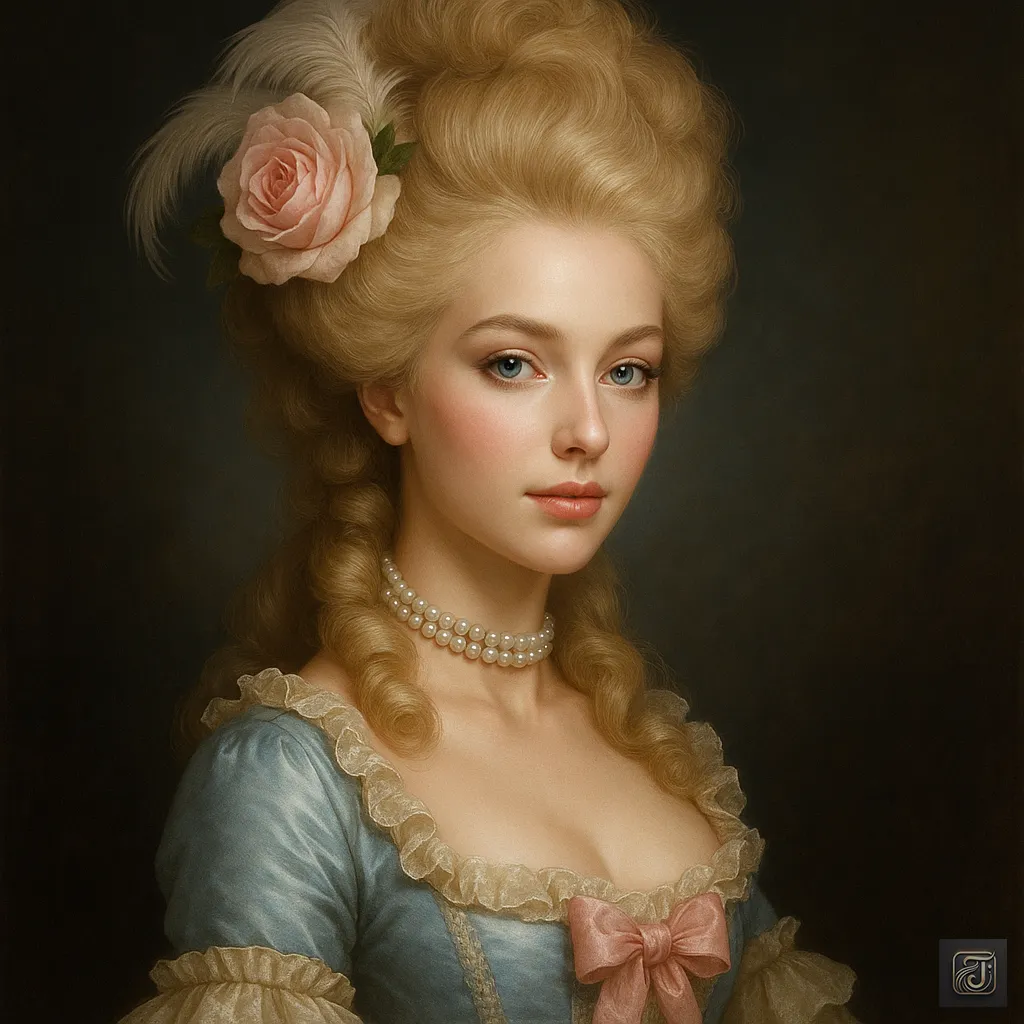
Marie Antoinette: The Greedy Queen
- Prologue: The Day of Fate — October 16, 1793
- Chapter 1: The Little Princess of Austria
- Chapter 2: The Dauphine of France — A 14-Year-Old Bride
- Chapter 3: A Loveless Marriage
- Chapter 4: Escape and Masquerade — The Encounter with Fersen
- Chapter 5: A Queen’s Freedom — To the Petit Trianon
- Chapter 6: Luxury, Gambling, and the Duchess of Polignac
- Chapter 7: The Man She Loved – Fersen, and the Fall into Despair
- Chapter 8: The Affair of the Diamond Necklace
- Chapter 9: The Eve of Revolution — The National Assembly and the Tennis Court Oath
- Chapter 10: Escape from Versailles! — The People’s March of October 6
- Chapter 11: The Desperate Escape — The Flight to Varennes
- Chapter 12: The End — The Abolition of the Monarchy and the Guillotine
- Final Chapter: Why Did People Hate This Queen?
- Afterword from the Author
Prologue: The Day of Fate — October 16, 1793

Paris, October 16, 1793.
A cold morning mist blanketed the capital.
Revolution Square (formerly Place Louis XV) was already overflowing with crowds.
“Look! Here comes Her Majesty, the Queen!”
“That woman who drowned herself in luxury!!”
A storm of jeers and curses filled the air.
The guillotine stood ready.
Its wooden frame was stained with blood, and the blade gleamed dully in the pale light.
Just then, a prison cart approached.
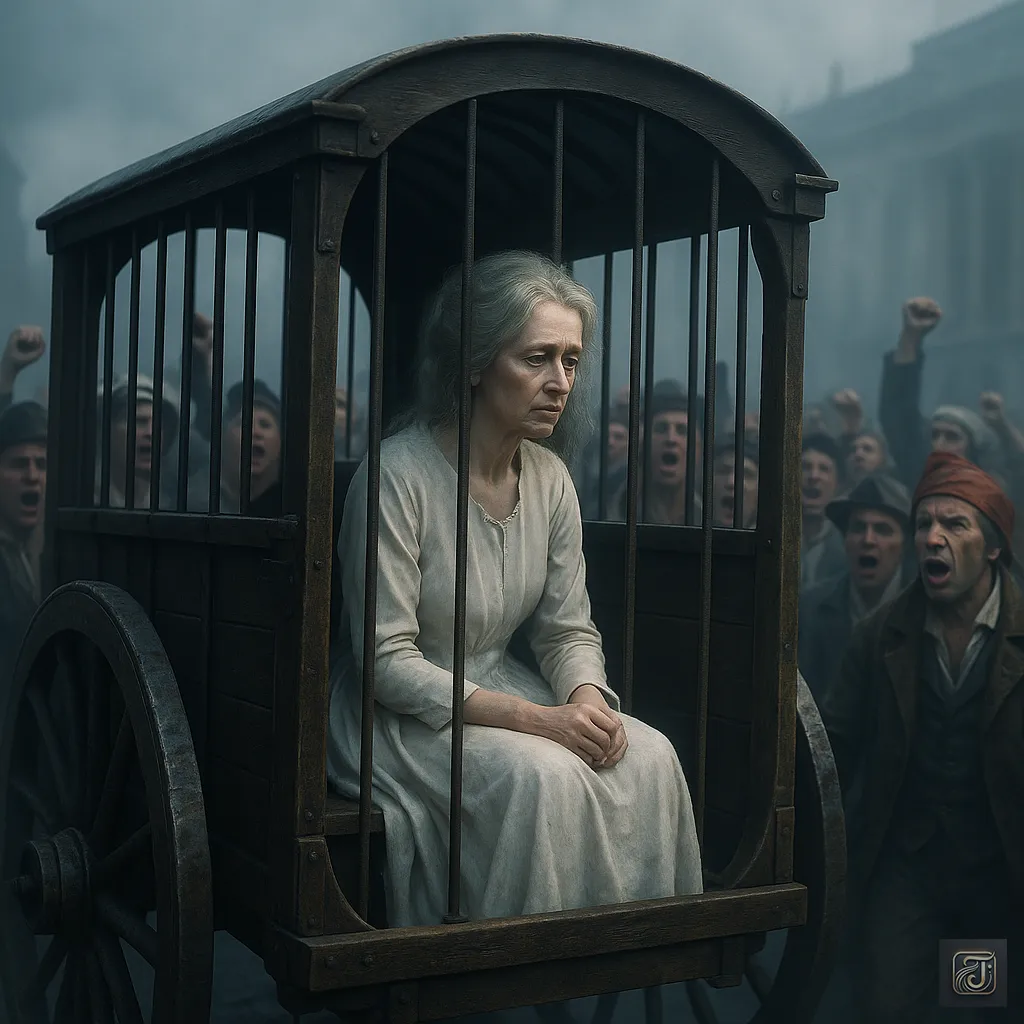
Inside sat the woman once called “Queen” — Marie Antoinette.
Her once-glorious hair was now disheveled and streaked with gray.
Her face, pale and drawn.
She who had once worn gowns of silk and jewels now wore nothing but a simple, threadbare white mourning dress.
The cart came to a halt.
A soldier took her by the arm as she stepped down.

Citizens:
“Die, you lavish whore!”
“Now you’ll pay for the hunger we’ve suffered!”
Shouts, curses, even stones flew through the air.
But Marie Antoinette’s eyes remained calm.
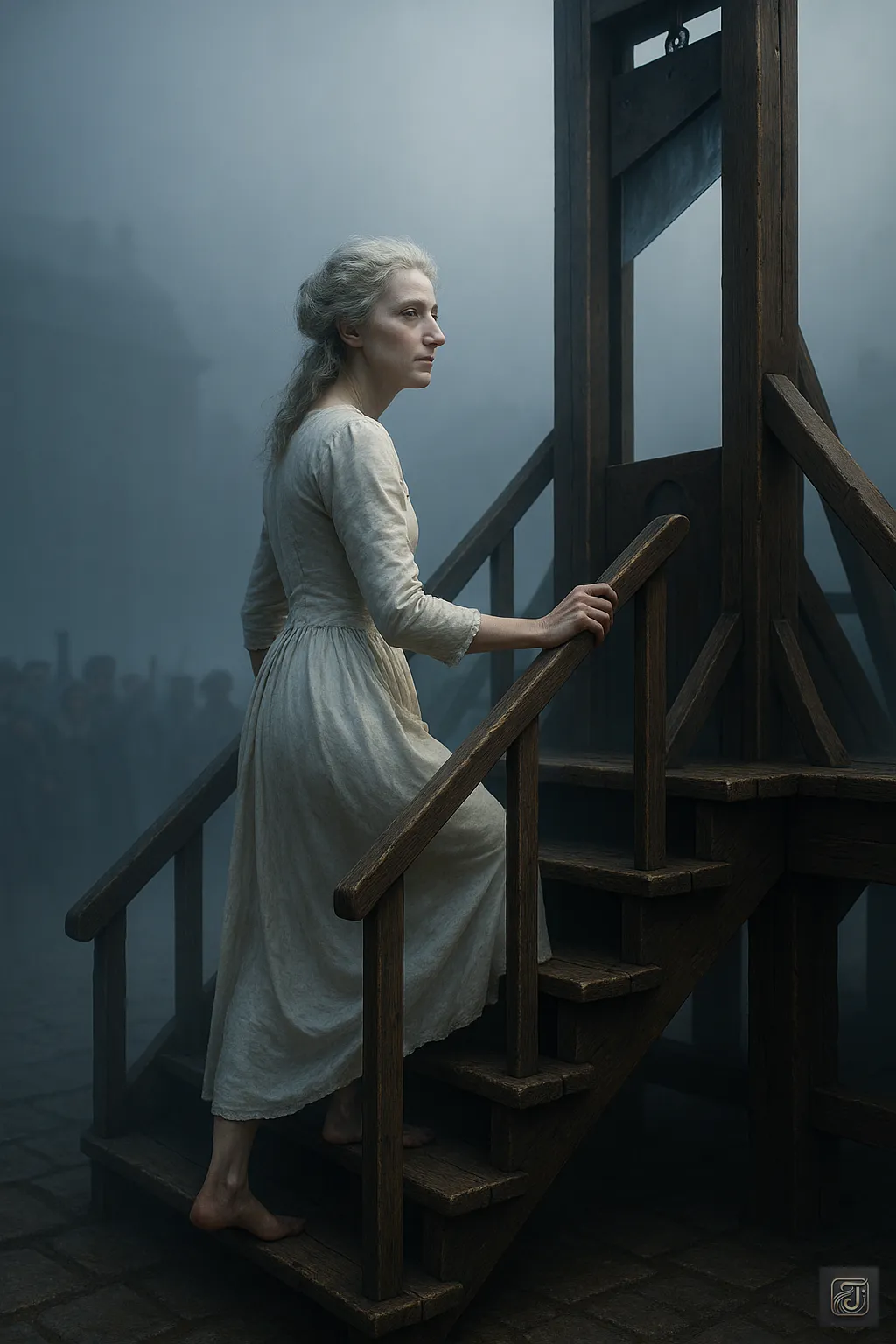
Marie Antoinette:
“Why… am I here?”
As she climbed the steps to the scaffold, one slow step at a time,
Fragments of her past drifted through her mind.
The day she arrived in France at fourteen…
The dazzling court of Versailles…
The carefree days at Petit Trianon…
Her secret feelings for Fersen…
And the scandal of the Diamond Necklace…
All of it felt like a distant dream.
As she laid her head beneath the blade,
Marie Antoinette whispered softly, almost to herself:
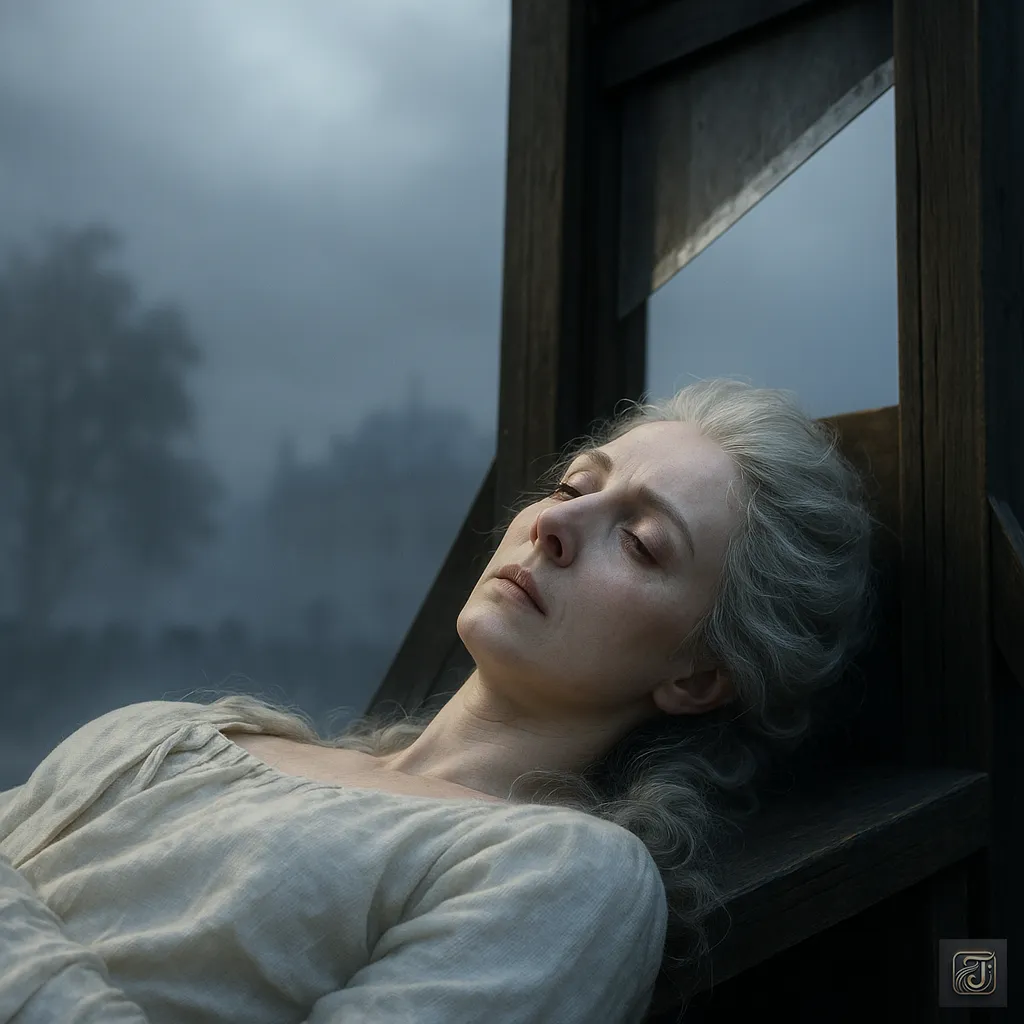
Marie Antoinette:
“My life… Where did it go wrong…?”
—Why was this queen sent to the guillotine?
Now, the door to her story swings open—
Chapter 1: The Little Princess of Austria

November 2, 1755 — Hofburg Palace, Vienna.
As autumn fog blanketed the city, the cry of a newborn girl echoed through the palace halls.
Her name—Maria Antonia Josepha Johanna.
The world would come to know her as Marie Antoinette.
She was the fifteenth child of Francis I, Holy Roman Emperor,
and Empress Maria Theresa of the Habsburg Empire.
Yes—the fifteenth.
Though born a princess, no great expectations were placed upon her shoulders.
And yet, fate can be a cruel trickster.
As the balance of power in Europe began to shift,
The “value” of a single young girl suddenly changed.
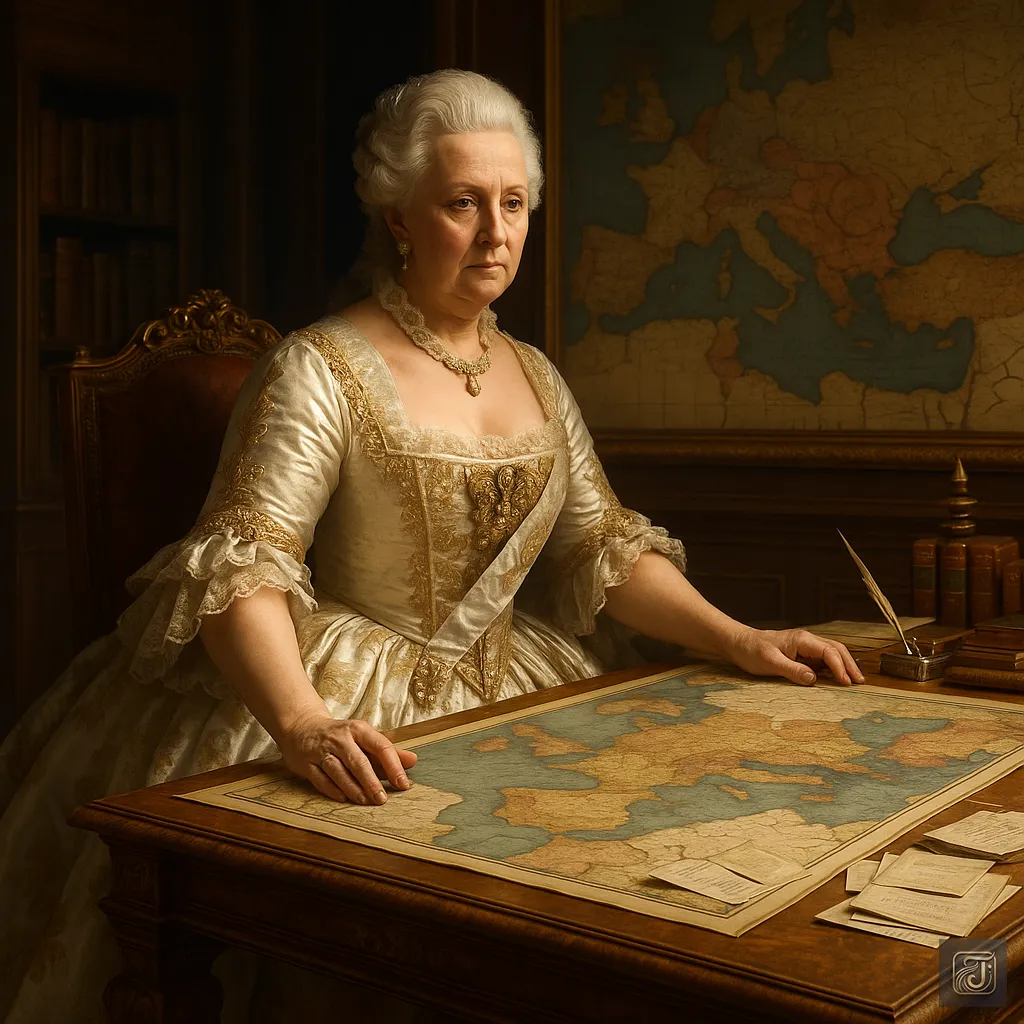
Maria Theresa was a rare political genius.
She defended her territories, enriched her nation,
and maneuvered skillfully in the fierce struggle for dominance in Europe.
Her ultimate goal was clear—
Reconciliation between Austria and France.
For centuries, the two nations had been bitter enemies.
But forging peace with France and maintaining balance in Europe had become Maria Theresa’s deepest desire.
And the one chosen to serve as the “symbol of peace”—
Was none other than the young Maria Antonia.
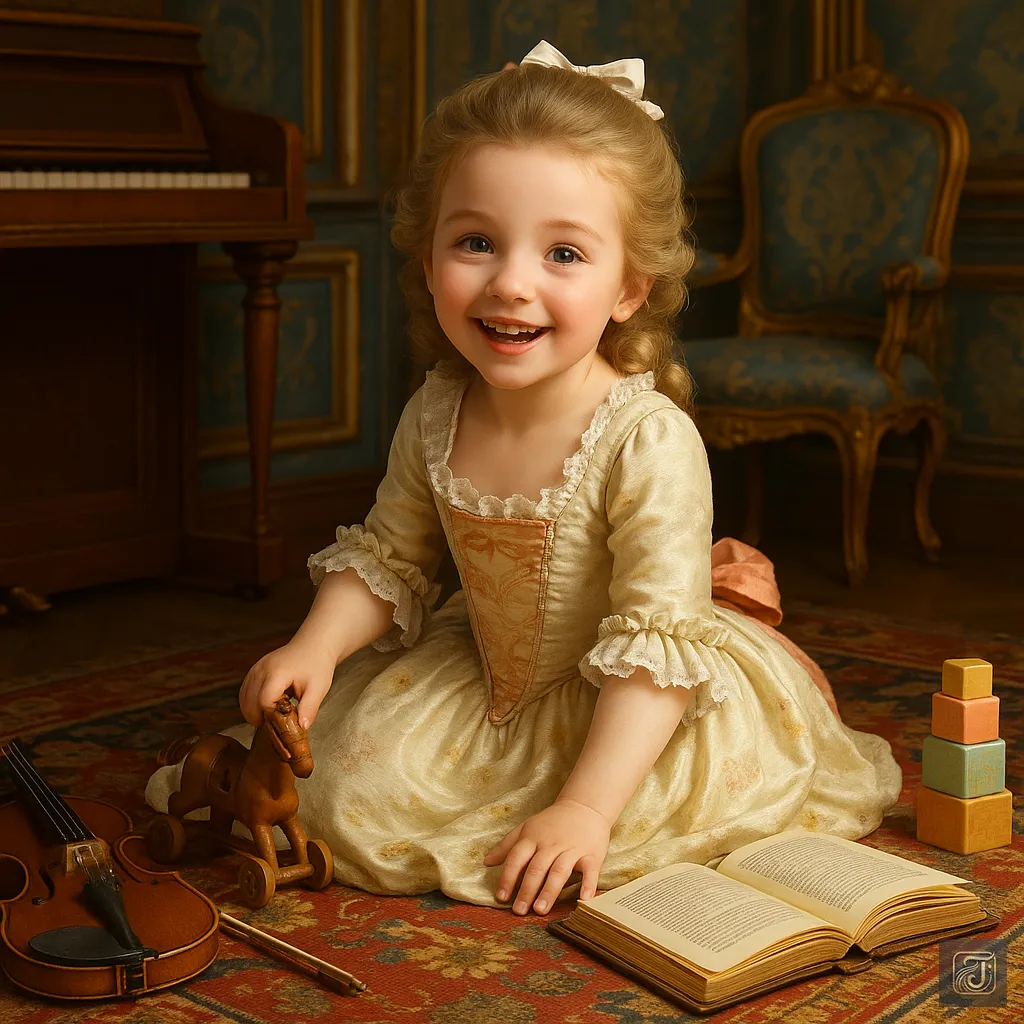
She was a bright and innocent child.
She loved music, dancing, and above all, playing.
As for her education… well, it wasn’t exactly her strong suit.
She struggled with reading and writing, and her French was clumsy at best.
But her natural charm, beauty, and radiant personality outshone everything else.

Maria Theres:
“This child… has the power to captivate.”
Maria Theresa watched her daughter and felt certain.
And so, without truly understanding it herself, the young Maria Antonia was destined to become a pawn of international politics.
In the late 1760s, talks of a marriage alliance with Louis-Auguste, the Dauphin of France (the future Louis XVI) began to take shape.
From that moment, her mother ordered that Maria Antonia be trained in earnest—to become a proper Queen of France.

Intense French language drills.
Strict corrections in etiquette.
Rigorous training in courtly dance.
Endless practice in graceful comportment.
Her feelings?
No one cared.
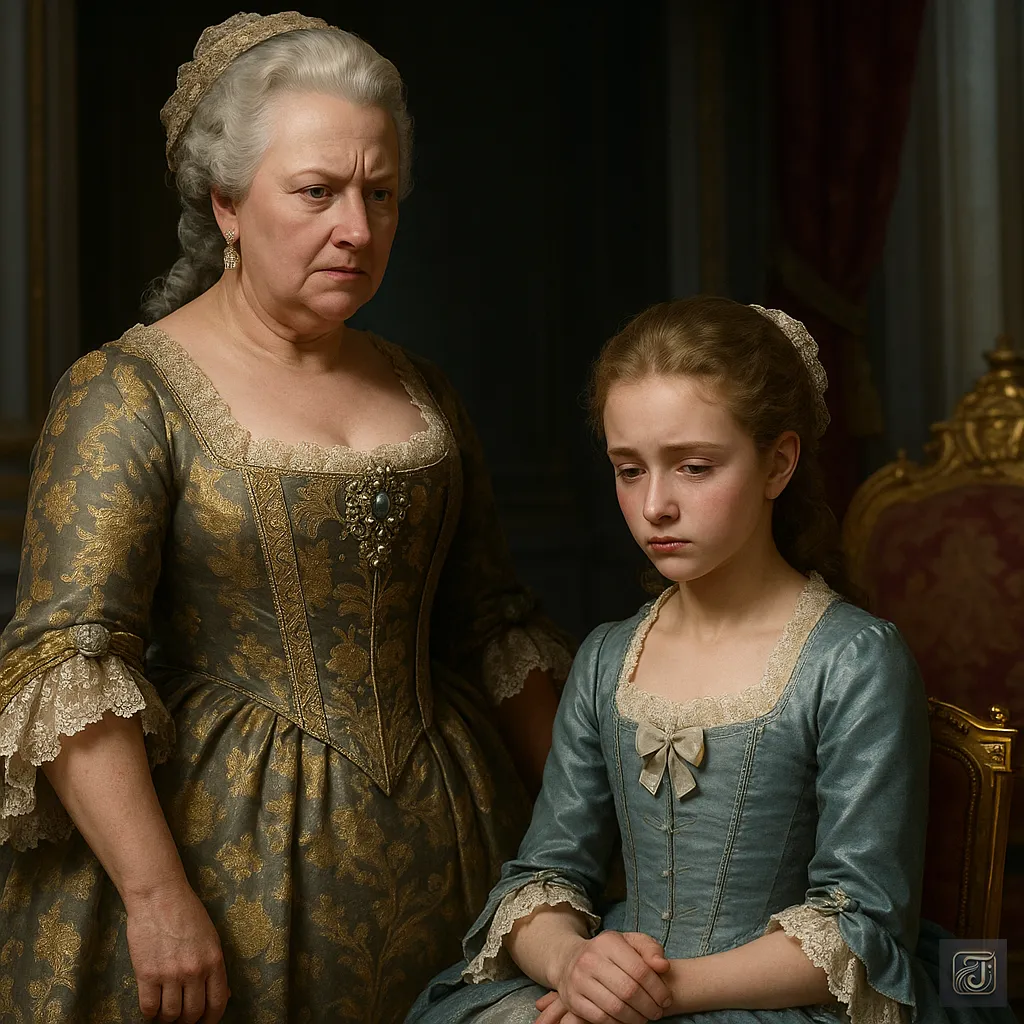
Maria Theresa:
“This is for your country.”
“Your duty is to succeed as queen.”
Her mother, Maria Theresa, remained unyielding—her will was ironclad.
And so, an innocent young girl, knowing nothing of the world,
was forced to bear the weighty crown of “Future Queen of France.”
But—she had no way of knowing.
That this very crown would one day become a signpost…
leading her to the guillotine.
Chapter 2: The Dauphine of France — A 14-Year-Old Bride

May 16, 1770.
Maria Antonia—just 14 years old.
As the spring breeze swept through the palace halls of Vienna, the young girl faced the day of her departure.
Her destination: the Palace of Versailles in France.
Her new title: Dauphine of France.
The marriage was hailed as a “symbol of peace between two nations.”
But at its core, it was pure politics.
“Because my mother commands it.”
“Because it’s for the good of the country.”
For young Antonia, there was no right to refuse.
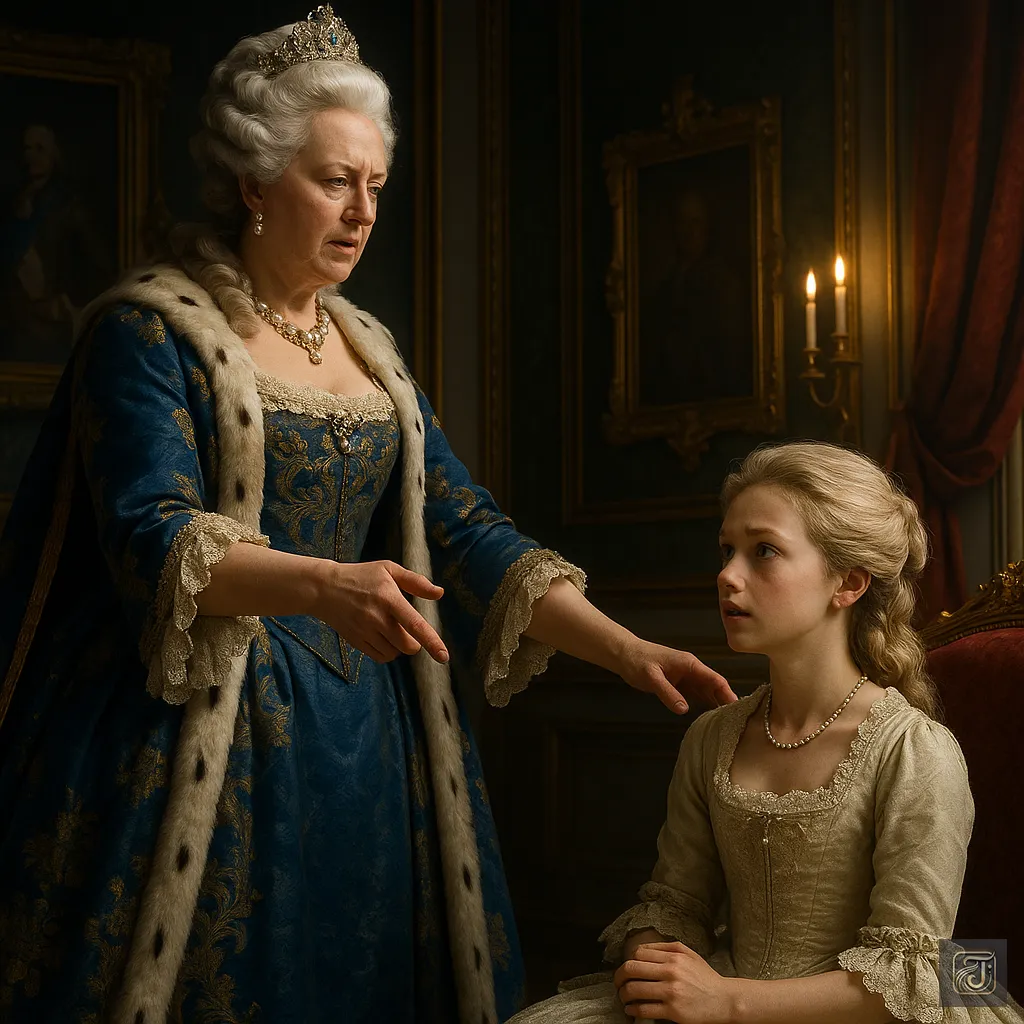
Maria Theresa:
“This marriage will unite Austria and France.”
“You will be the bridge between our nations.”
So spoke her mother, Maria Theresa, impressing the words upon her daughter.
But was there love in that gaze?
No—only the cold, resolute eyes of an empress.

She would never return to her homeland again.
Rocked by the carriage, the young girl quietly bid farewell to the receding skyline of Vienna.
Eventually, they arrived at the banks of the Rhine—the border between Austria and France.
It was here that the famous “Rite of Handover” took place.

Maids:
“You now belong to France.”
“Leave behind all things Austrian.”
The young girl was stripped of everything from her homeland—her clothes, her jewelry, even her attendants.
Even her name was changed—from Maria Antonia to Marie Antoinette.
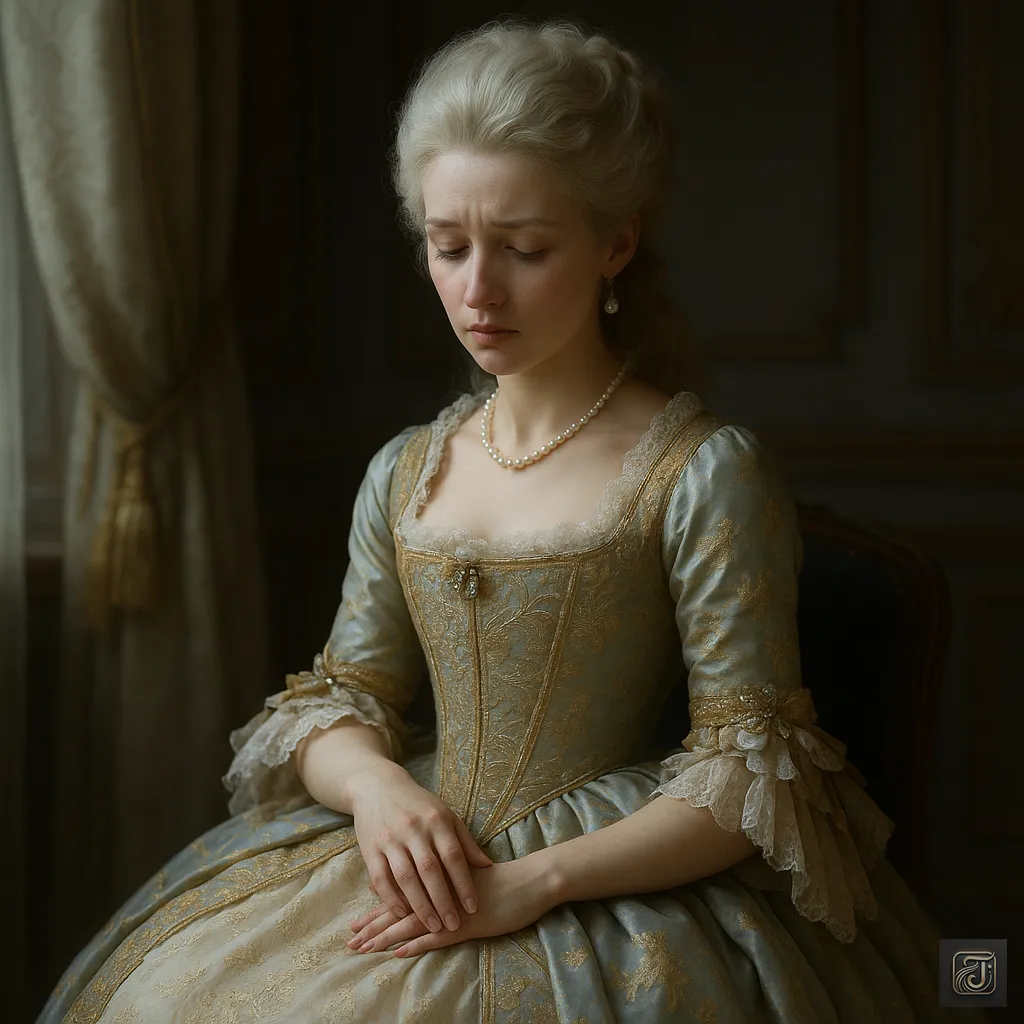
Marie Antoinette:
“I suppose… I’m no longer the Austrian princess…”
As her trembling fingers adjusted the new French gown around her shoulders,
Marie Antoinette whispered the words to herself.
Gone were the silks of Vienna, the warmth of her childhood court.
In their place: formality, expectation… and unfamiliar eyes.
Soon after, she arrived at the grand palace of Versailles—
a glittering world of opulence and intrigue.
There, for the first time, she met Louis-Auguste, the Dauphin of France.
The man who would one day become Louis XVI.
But in that first meeting—
There was no spark.
No flutter of affection.
No fairy tale.
There was only duty.
And the silent understanding that this was a life already decided for her.
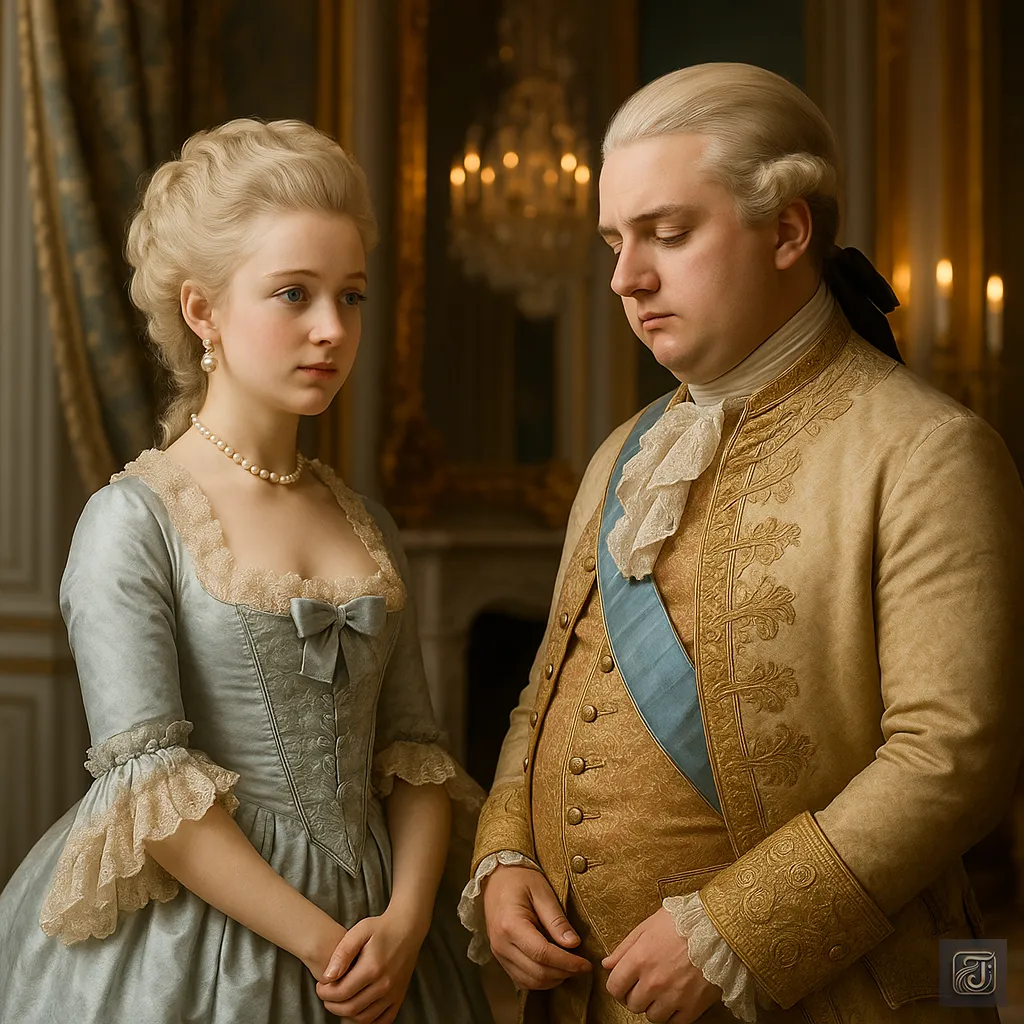
The Crown Prince was a shy young man with a plump figure.
His greatest interest lay in making locks—
He showed no enthusiasm for dancing, court festivities, or the splendor of palace life.

Marie Antoinette:
“Is this man… really going to be my husband?”
A small seed of disappointment began to grow in the young girl’s heart.

Before long, a grand wedding celebration was held.
The French court was filled with voices of joy,
and the people welcomed this “marriage of peace” with open arms.

Citizens:
“The conflict with Austria is over!”
“A new era has begun!”
Cheers echoed through the streets.
But—
Behind that dazzling stage,
a 14-year-old girl whispered quietly in her heart:
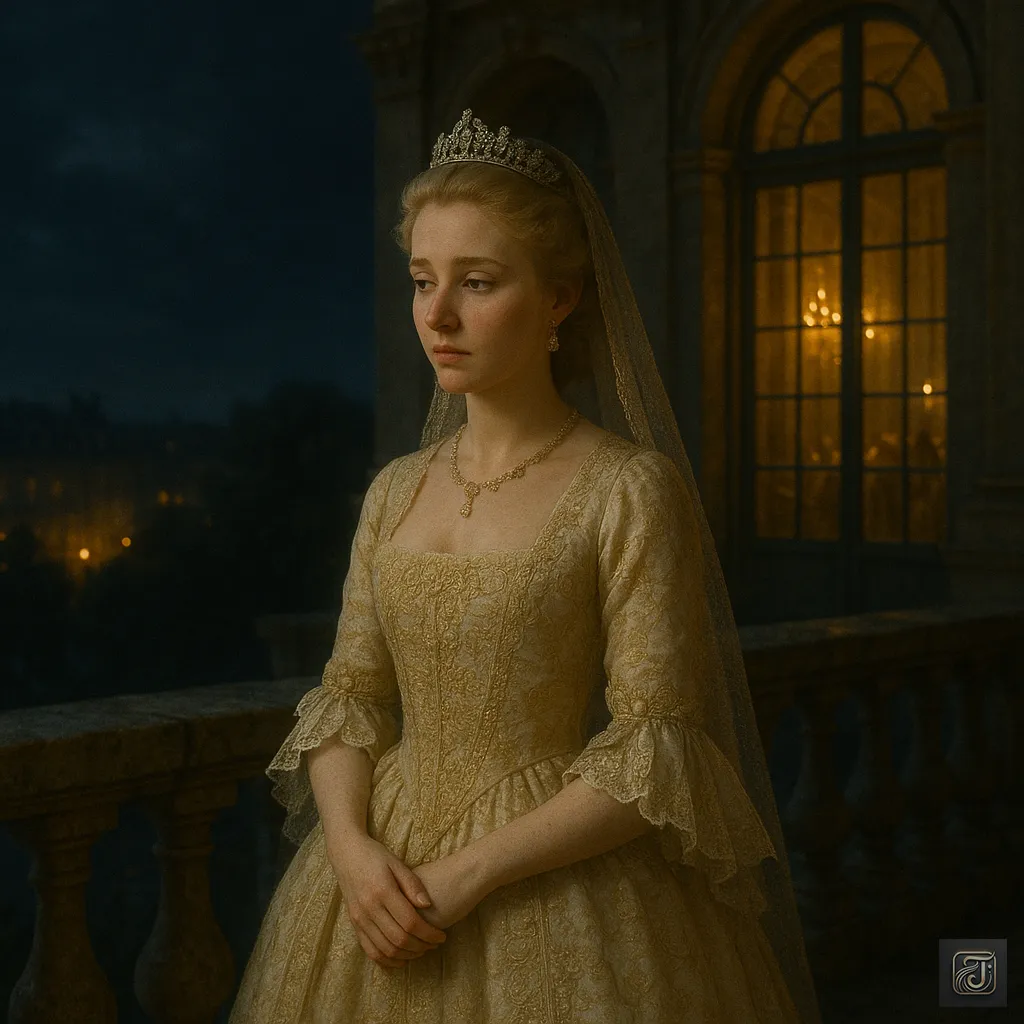
Marie Antoinette:
“Will I… truly find happiness from now on…?”
Unaware of what lay ahead,
The gears of fate began to turn—quietly, yet irreversibly.
Chapter 3: A Loveless Marriage
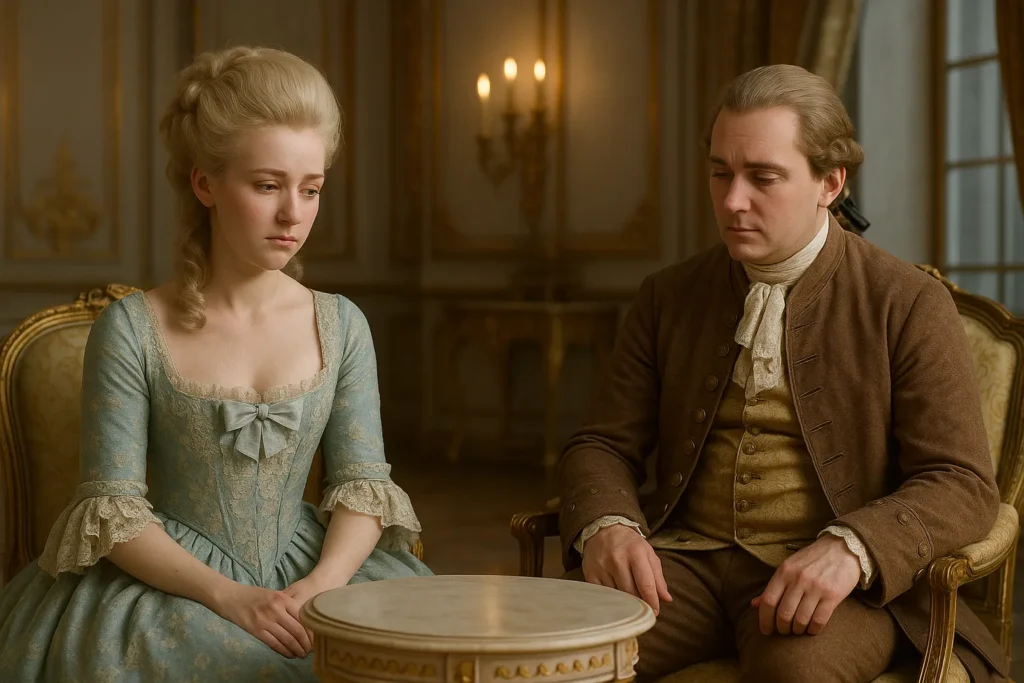
The beginning of married life—
It should have been a time filled with hope and joy.
But for Marie Antoinette, it was quite the opposite.
Her husband, Louis-Auguste.
He was, indeed, sincere.
But his personality was extremely reserved and introverted.
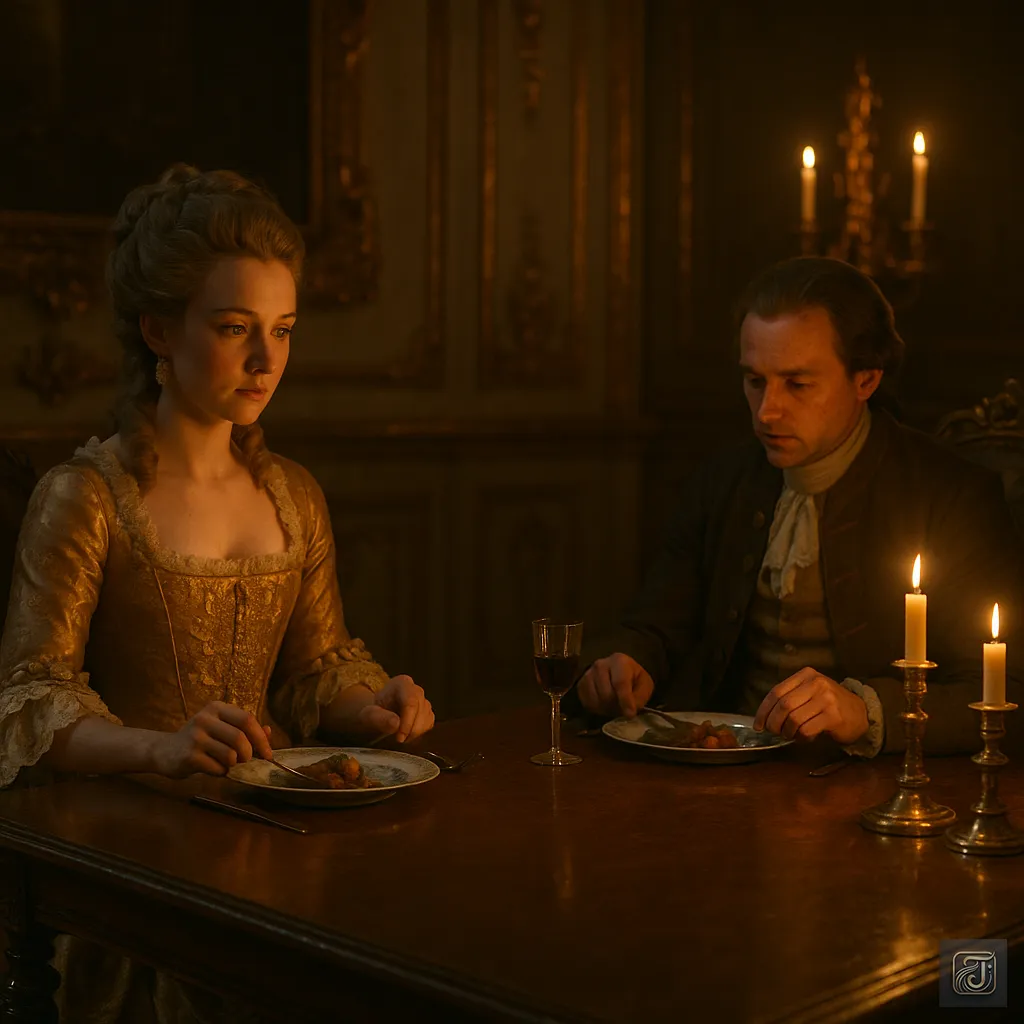
A few days into their married life,
the crown prince and princess were finally sharing a private meal together.
But—
The room was engulfed in silence.
Even the faint clink of a silver fork against a plate echoed unnaturally loud.
Across from her, Louis-Auguste sat hunched slightly forward, quietly cutting his food.
Marie Antoinette:
“…Do you like the meal?”
Antoinette gathered her courage and asked gently.
Louis XVI:
“…Ah, yes… It’s very good.”
He replied, barely above a whisper.
And then—silence again.
Marie Antoinette:
(How am I supposed to bridge this gap…?)
Another shadow crept quietly across the girl’s heart.
And above all—
He was obsessed with making locks.
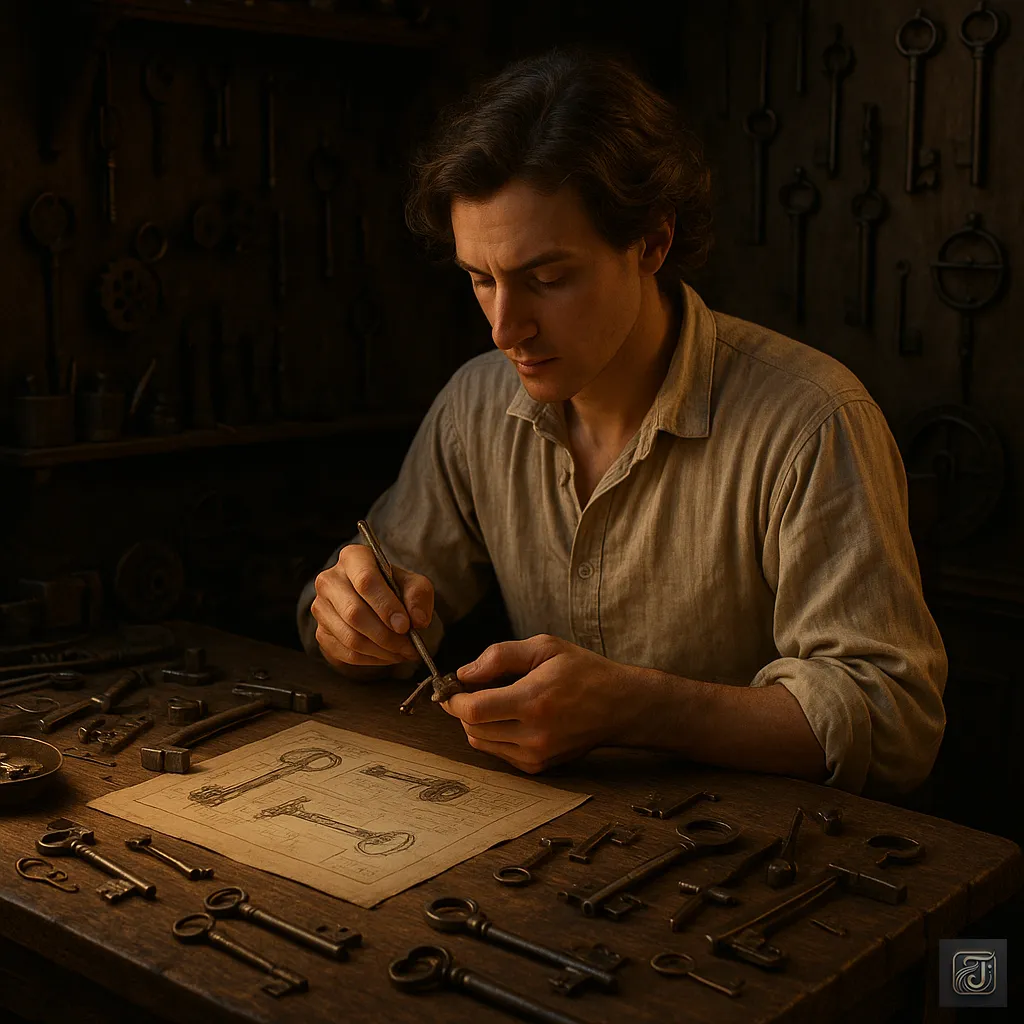
Within the vast halls of Versailles,
there was a small chamber set aside—Louis’s personal workshop.
There, the young dauphin would spend hours each day,
lost in the intricate design and repair of locks.
But behind that hunched back, bent over brass gears and tiny screws,
was the silent confession of a man who simply didn’t know—
How to be a husband, or a king.
Though now heir to the French throne,
Louis XVI was painfully shy, awkward in company,
and utterly unsure of how to connect with his new young queen.
Click… clack…
The soft sound of metal pieces sliding into place was the only thing that filled the room.
Louis XVI’s thoughts:
(…How am I supposed to speak to her… to Antoinette…?)
He searched for the words,
But his hands never stopped moving.
In this small mechanical world,
He found the only space he truly understood—
The only place where he felt safe.
But the deeper he retreated into that solitude,
the wider the distance between him and his queen grew.
And tragically—
He was the only one who didn’t realize it.

Marie Antoinette:
“Why…?”
“Why does my husband show so little interest in me…?”
Marie Antoinette whispered to herself as she wandered alone through the endless corridors of the palace.
She was only fourteen.
Still just a girl, yearning for someone to reach out.
For someone to speak kindly.
To see her.
But when night fell, Louis-Auguste shut himself away in his workshop—
His world made of locks and keys, not hearts.
He never came to the grand balls.
He never came to her.
And so, under the glow of chandeliers that lit a hall meant for dancing,
The young Dauphine stood in silence—
waiting.
Not for a partner to dance with,
But for time to pass.
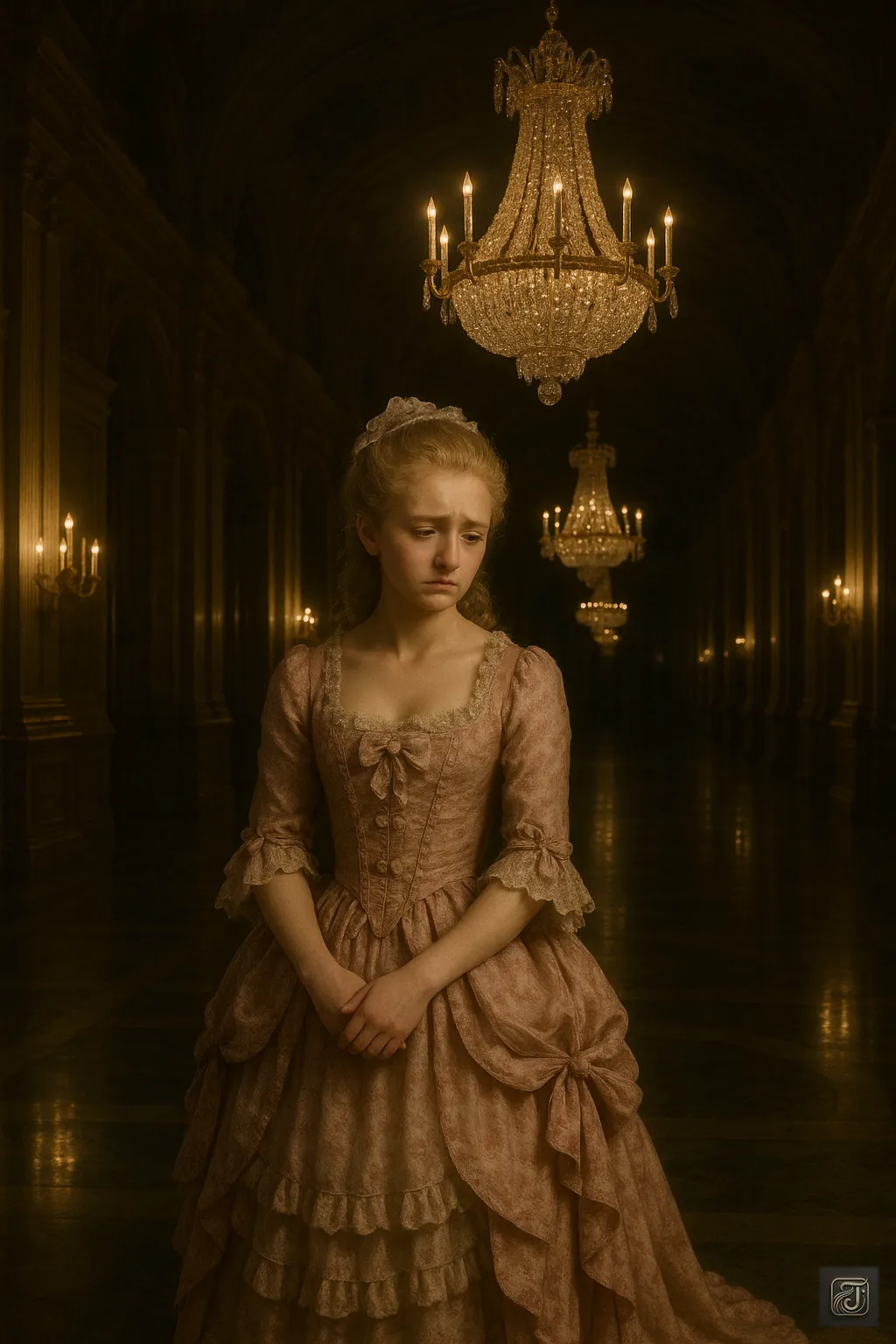
Marie Antoinette:
“I am… the Dauphine of France…”
“So why do I feel so utterly alone…?”
A quiet, creeping shadow fell over her heart—
gentle at first, but unmistakably real.
And yet, loneliness was not the only weight she bore.
There was another burden pressing down on her young shoulders—
a duty whispered in every hallway, echoed in every glance:
To bear an heir.
That was the true expectation of a Dauphine.
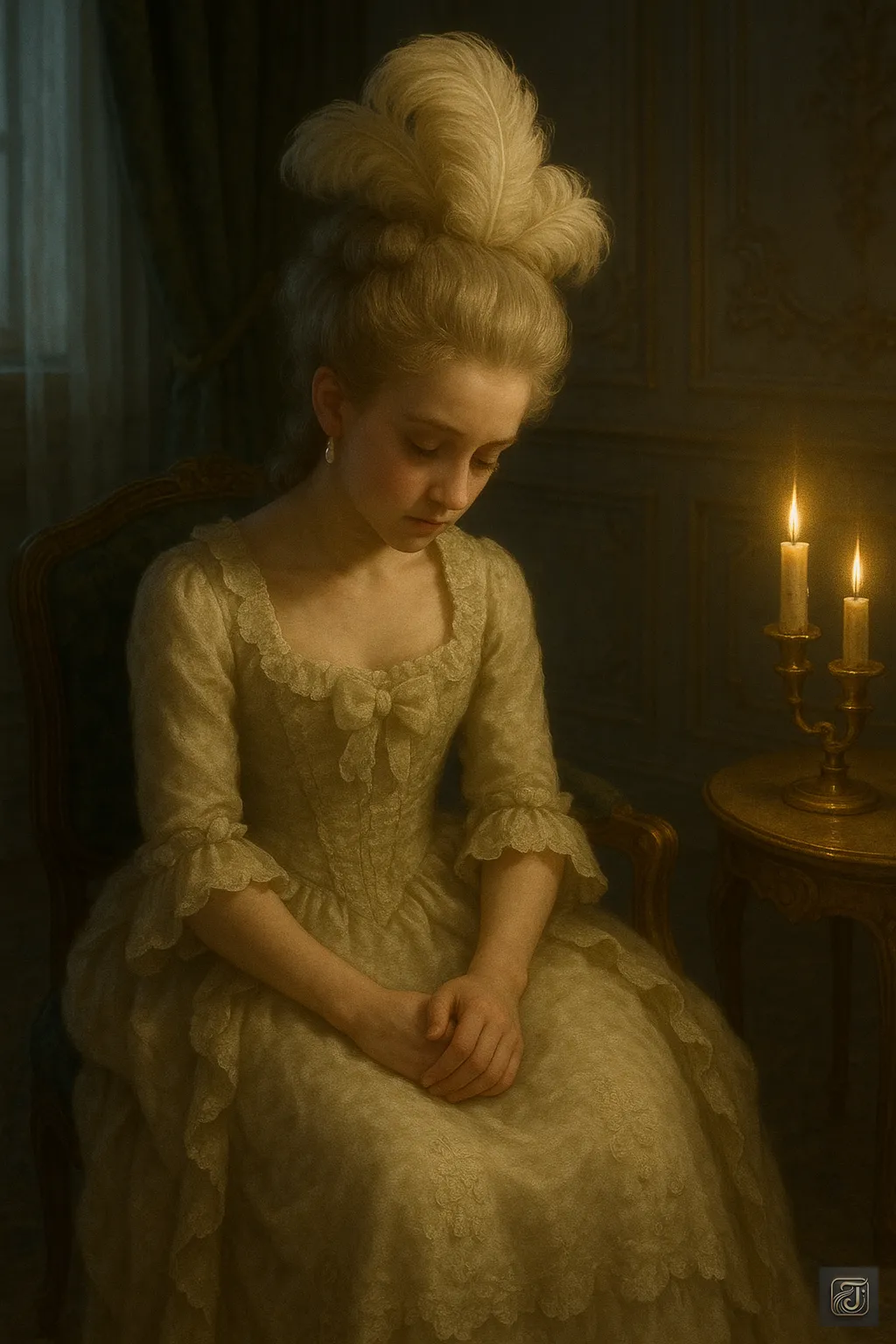
Marie Antoinette:
“I’m only 14…”
“How am I supposed to fulfill such a duty…?”
The young girl’s heart trembled with fear.

To make matters worse, Marie Antoinette came under the rule of a strict and domineering lady-in-waiting—Madame de Noailles.
Nicknamed: “Madame Etiquette.”
She was a tyrant when it came to court manners.
Who may speak first,
Who is allowed to tie a ribbon during dressing,
No movement permitted while the king is eating—
Every gesture was monitored,
And even the slightest mistake was criticized.
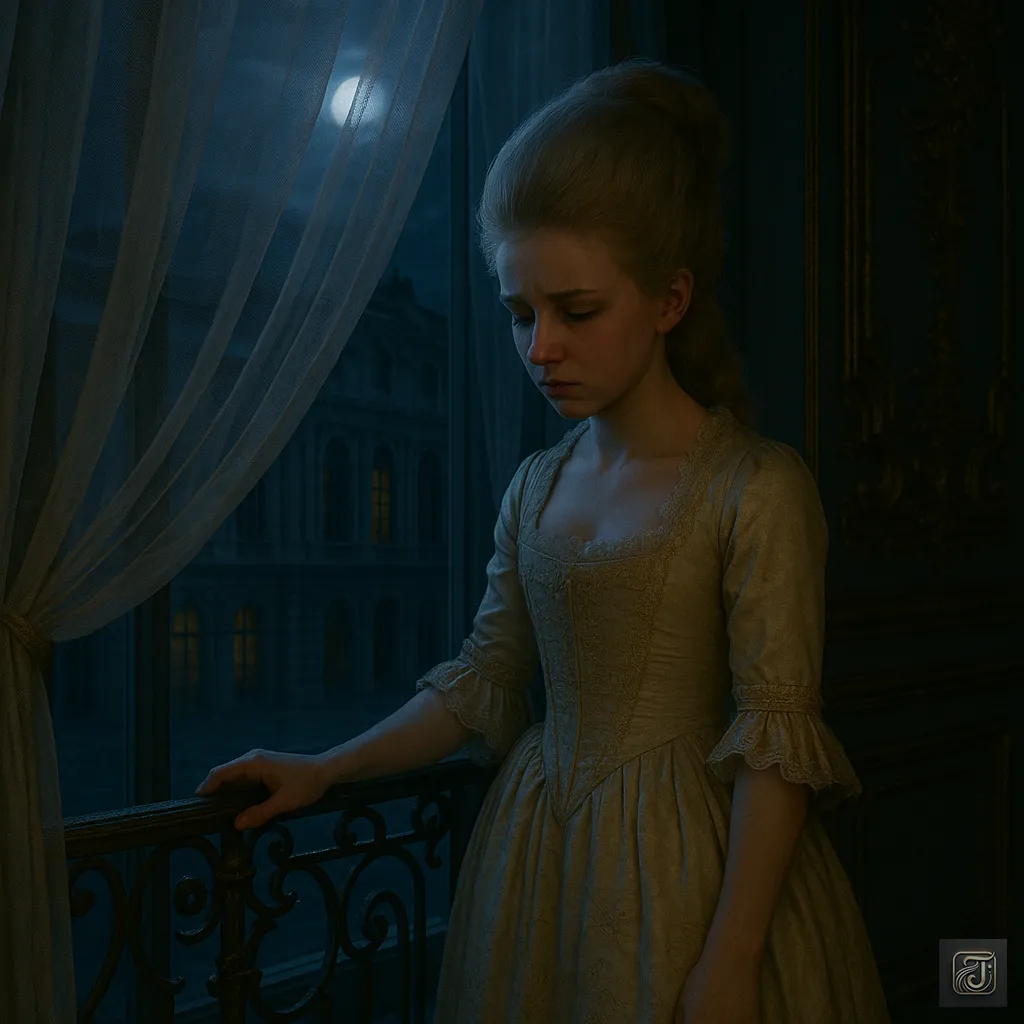
Marie Antoinette:
“Is this… truly a royal court?”
“It feels more like a prison…”
Marie Antoinette began to feel increasingly suffocated.
The Palace of Versailles was stunning.
But within its golden halls,
She herself felt like a songbird trapped in a gilded cage—
on display, but never free.
And amid such days of isolation,
A seed quietly began to sprout in her heart:
a longing to escape from reality.
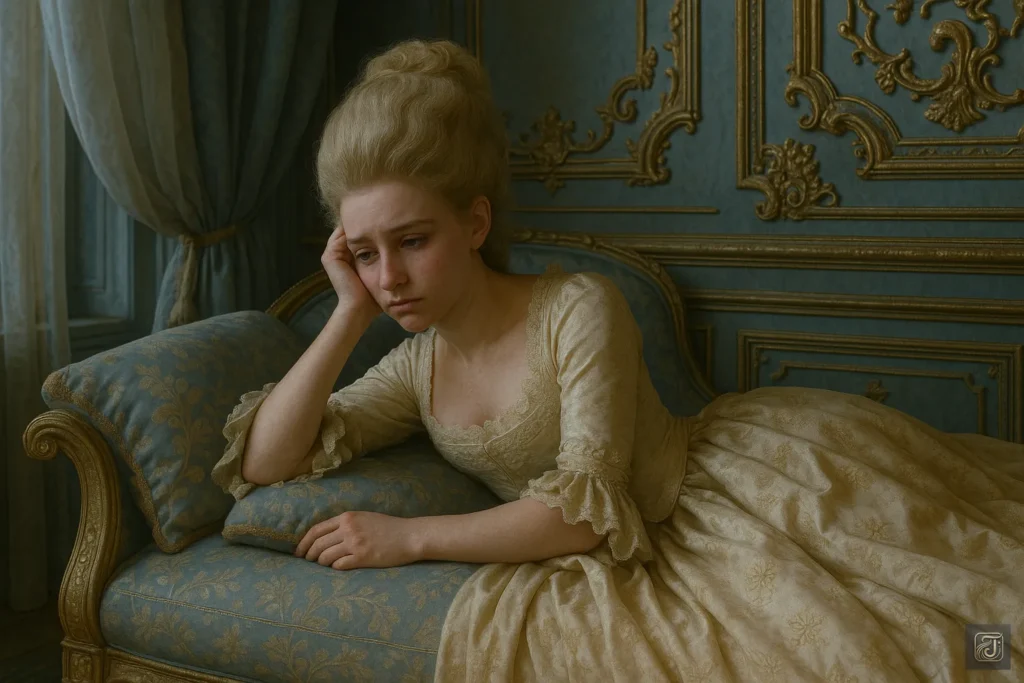
Marie Antoinette:
“This isn’t the kind of marriage I dreamed of.”
“I know that.”
“This is a union for diplomacy—there’s no love in it.”
“But even if love is impossible,
just a little freedom… that’s all I want.”
That quiet yearning eventually led her
to the masked balls of the night,
and to secret escapes at the Petit Trianon.
Yet those small rebellions—
that search for solace—
would soon mark the beginning
of a new and devastating chapter in her life.
Chapter 4: Escape and Masquerade — The Encounter with Fersen
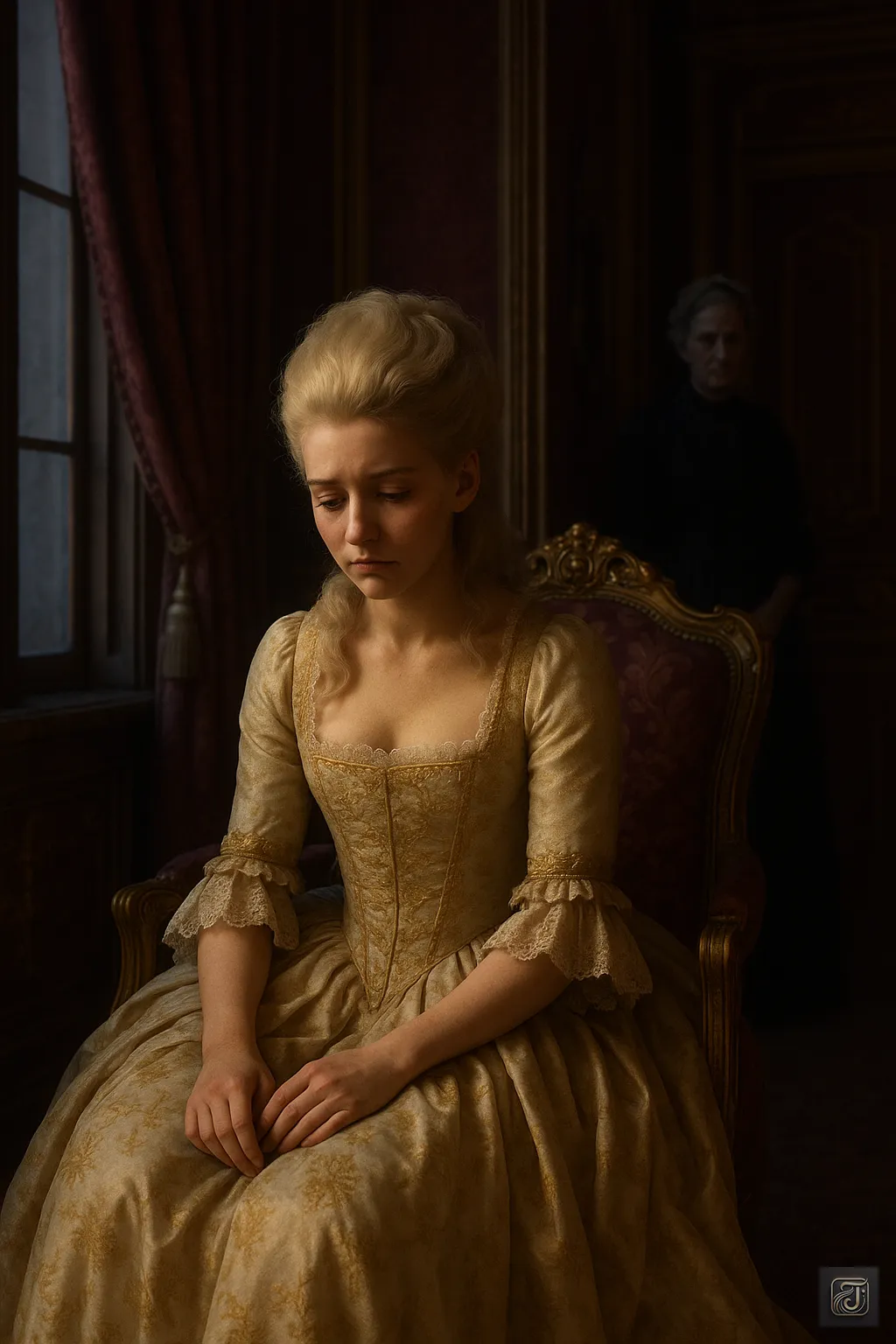
Marie Antoinette:
“I can’t breathe like this—”
That was Marie Antoinette’s daily reality at Versailles.
Her husband remained shut away in his workshop,
lost in the world of locks and mechanisms.
Madame Etiquette, ever watchful, continued to press her iron rules and rigid protocol.
What should have been a dazzling court life
felt more like a suffocating prison
to the young queen.

Marie Antoinette:
“If only for one night… I want to breathe freely.”
With that longing in her heart, Marie Antoinette began to attend
the secret masked balls held under the cover of night.
Behind a mask, rank and title no longer mattered.
She could forget she was a queen—
and simply be a woman—dancing, laughing,
and speaking without fear or duty.
The murmur of the crowd, the flickering candlelight,
The lilting strains of music…
For the first time in a long while, her eyes sparkled beneath the mask.
And then, one fateful evening—
A young man appeared before her.

His name was—Hans Axel von Fersen.
A Swedish nobleman and military officer,
he was a refined gentleman who had traveled through the courts of Europe.
Tall, graceful, and articulate—
His presence was unlike any of the French nobles Marie Antoinette had ever known.
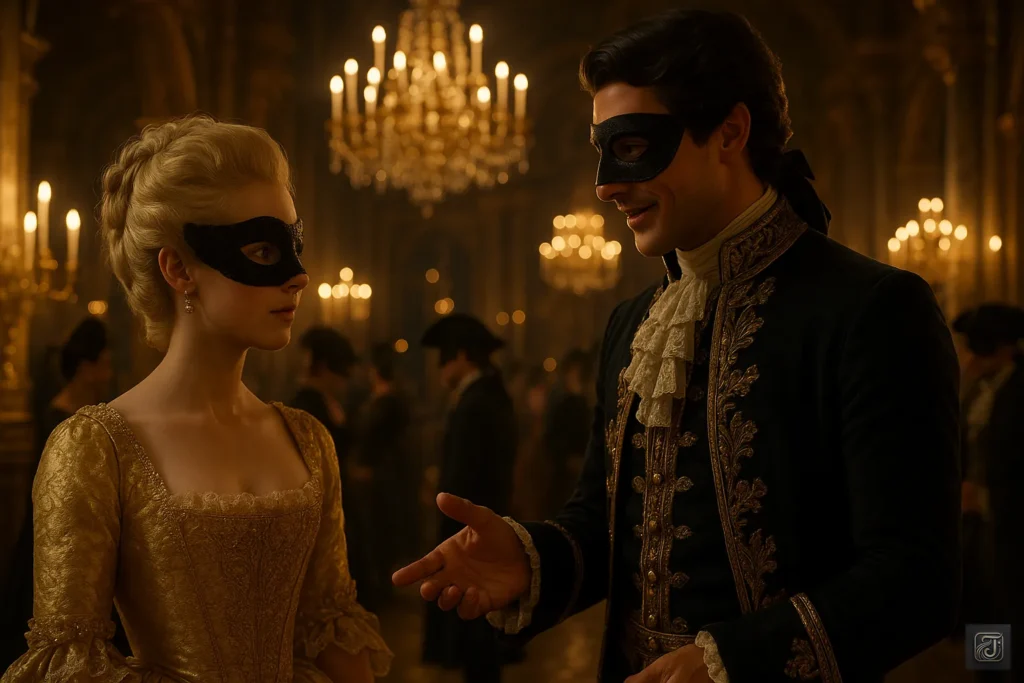
Marie Antoinette:
“And you… Where are you from?”
She asked through her mask, her voice soft and curious.
Fersen smiled gently.
Fersen:
“A traveler, merely passing through.”
“But tonight, I would gladly dance for the sake of this beautiful lady.”
The music swelled, and the two began to dance.
Step by step, gliding with elegance—
Marie Antoinette could no longer contain the flutter in her chest.
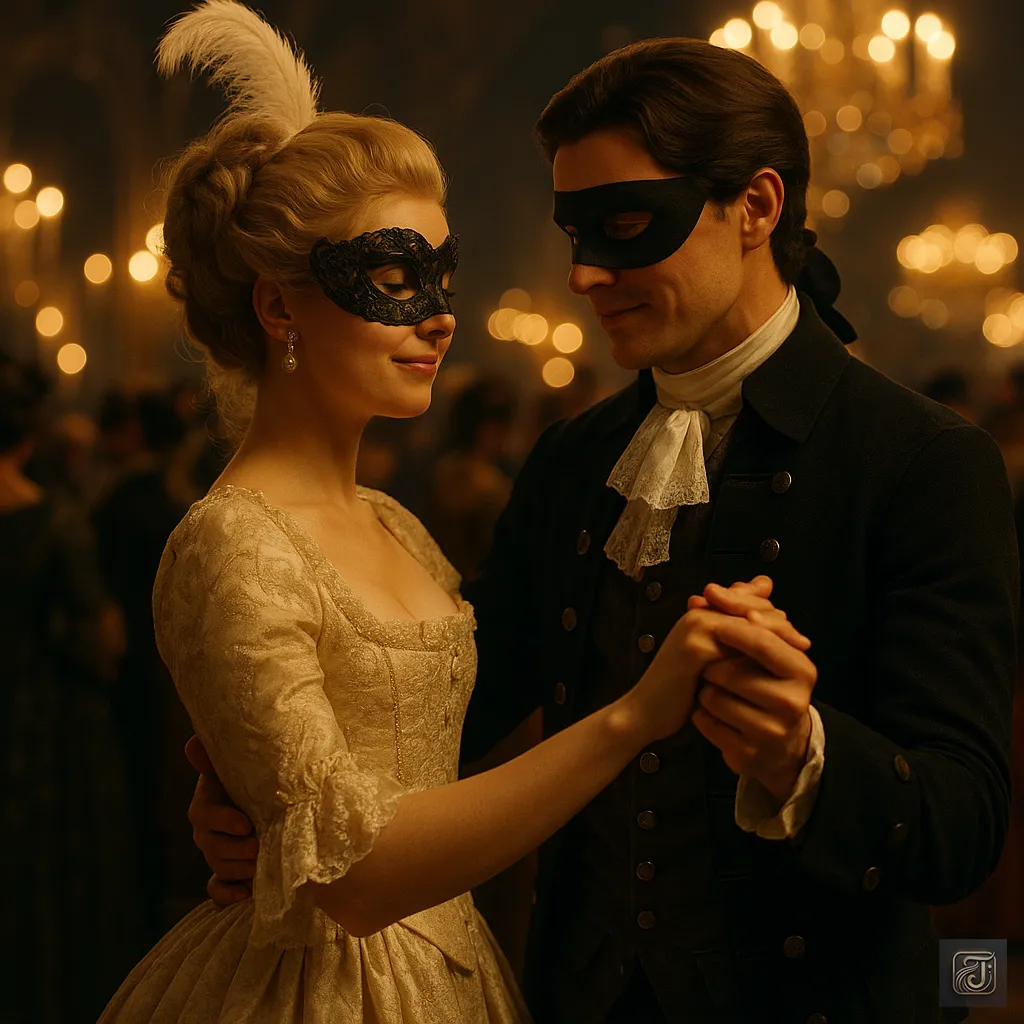
Marie Antoinette:
“Ah… so this is what they call true excitement…”
It was a feeling she had never experienced with her husband, Louis-Auguste.
The pleasant conversation,
The gentle gaze,
And more than anything—
“The joy of being seen not as a tool of diplomacy,
But as a woman—a person.”
As dawn broke over the masquerade ball,
They removed their masks and finally exchanged names.

Marie Antoinette:
“You are… Her Majesty the Queen?”
Fersen was momentarily surprised,
but his expression remained calm.
“Regardless of who you are, I hold deep respect for you as a person.”
Those words made Marie Antoinette’s heart burn even brighter.
And so, their destinies became intertwined.
Yet—neither of them knew that this encounter
would soon blossom into a forbidden love,
and lead Marie Antoinette further down the path of ruin.
Chapter 5: A Queen’s Freedom — To the Petit Trianon

In 1774—King Louis XV passed away.
Her young husband, Louis-Auguste, officially ascended the throne as King Louis XVI.
And at just eighteen years old, Marie Antoinette became Queen of France.
However, even with the crown upon his head,
Louis XVI remained the same reserved, awkward man he had always been.
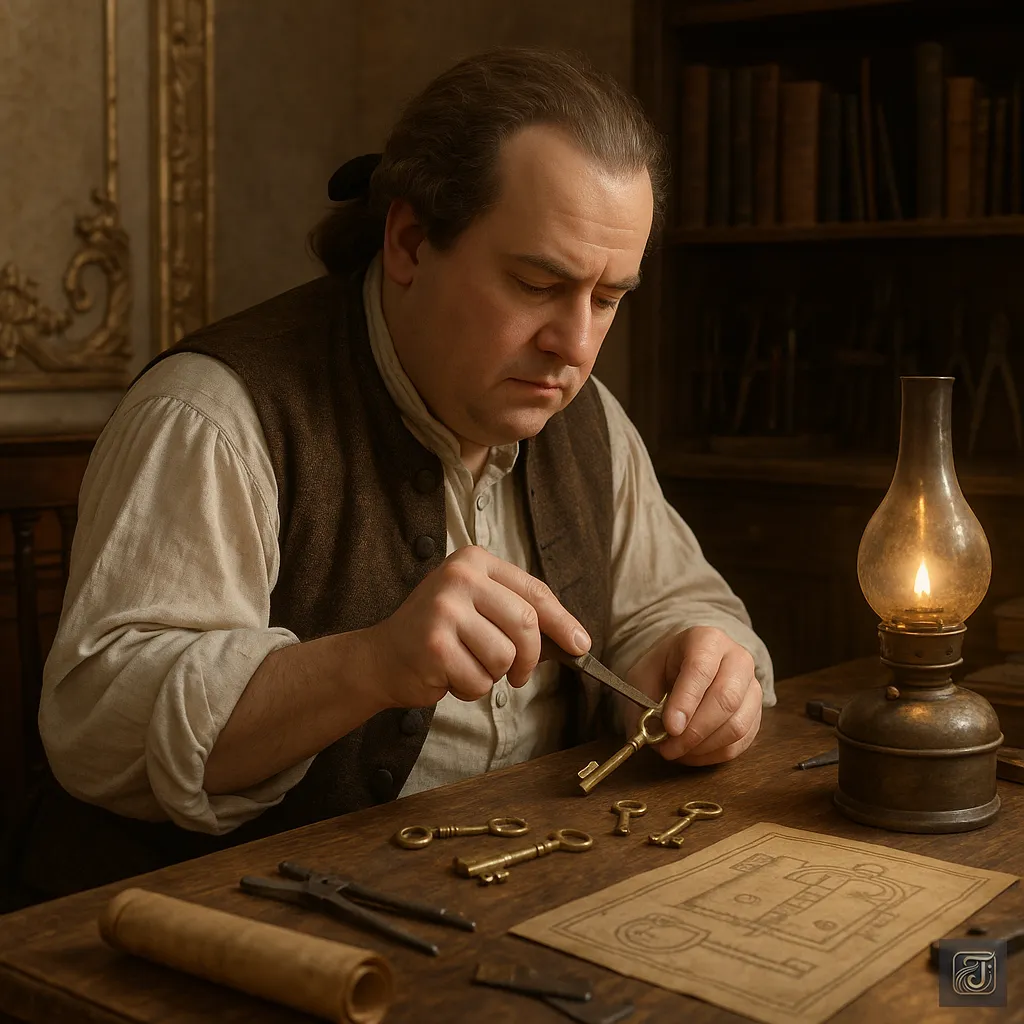
He showed little interest in affairs of state.
Even as king, he remained absorbed in his daily routine of lock-making.
Meanwhile, inside the palace, jealousy and gossip toward Marie Antoinette only grew louder.
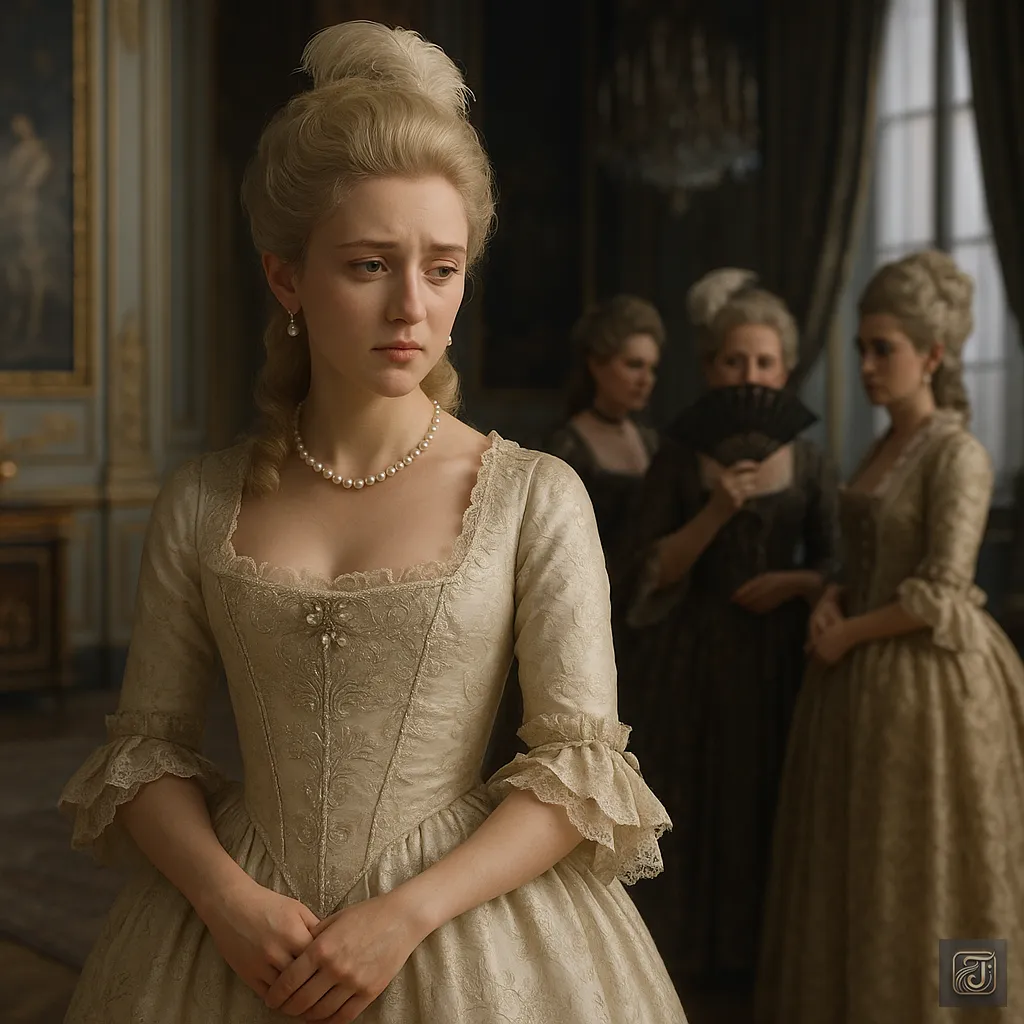
Rumar:
“The Austrian woman.”
“The extravagant queen.”
Such whispers began to echo more and more throughout Versailles.
Marie Antoinette’s sense of isolation only deepened.

Marie Antoinette:
“I have no place where I truly belong—”
It was in that moment of emptiness that something caught her heart—

The Petit Trianon.
A small palace once built by Louis XV for his beloved mistress, Madame de Pompadour.
Tucked away deep within the gardens of Versailles, it stood quietly—
a place that had now been granted to the queen
as her own private sanctuary of freedom.
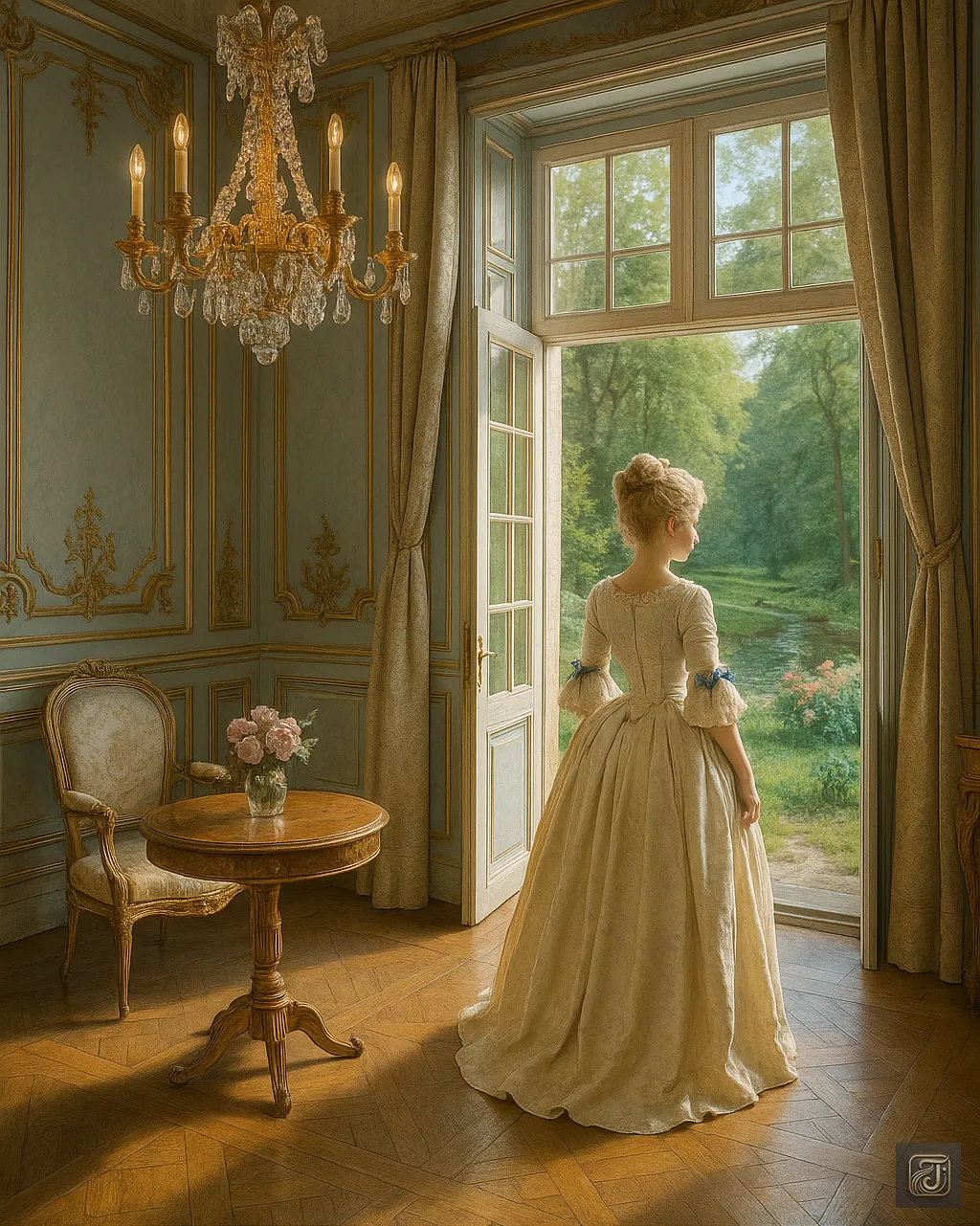
Marie Antoinette:
“Here, there are no court constraints, no watchful eyes of Madame Etiquette.”
Marie Antoinette was captivated.
The interiors were lavishly renovated,
adorned with exquisite Rococo-style decorations,
Each corner reflecting her taste and longing for freedom.
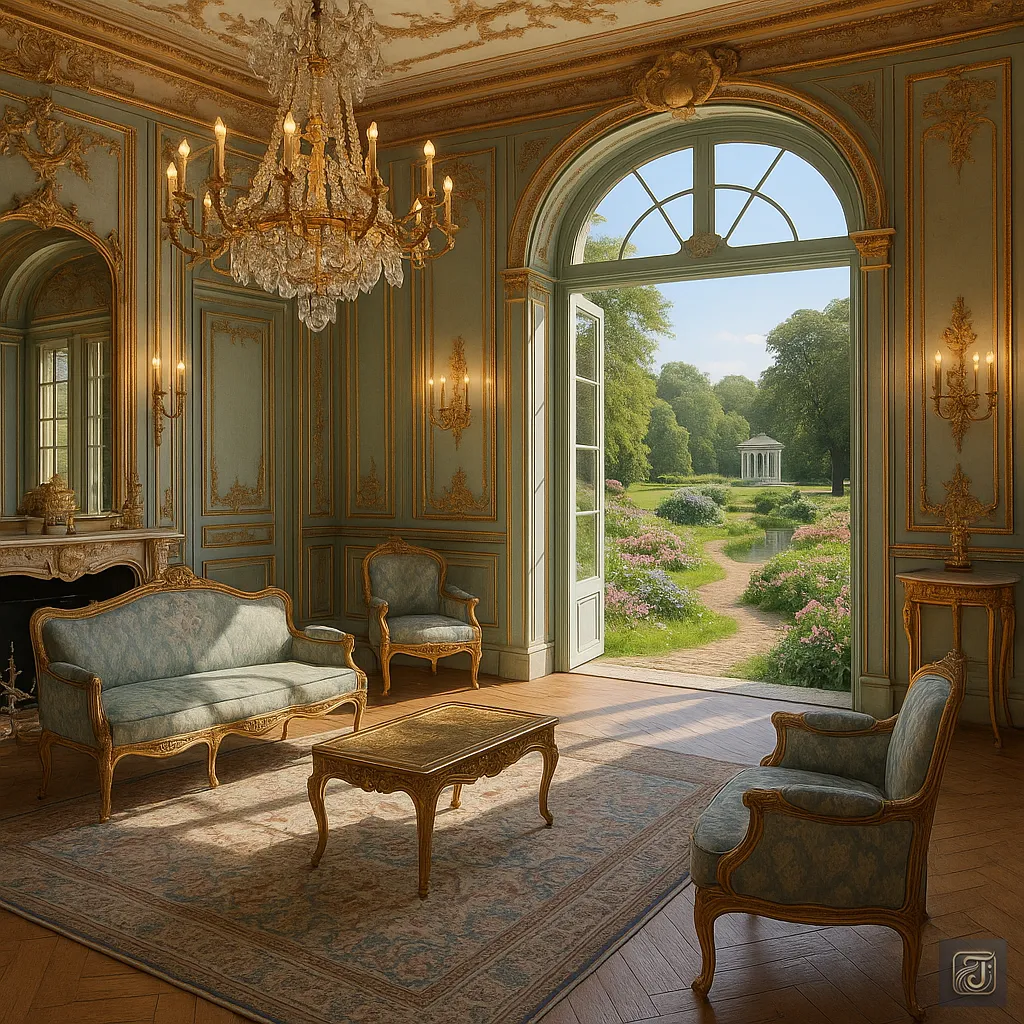
The gardens, too, were redesigned in the English natural style,
transformed into an “ideal pastoral landscape” with flowing streams and blooming flowers.
However—
The cost, of course, came from the royal treasury—meaning, the people’s taxes.
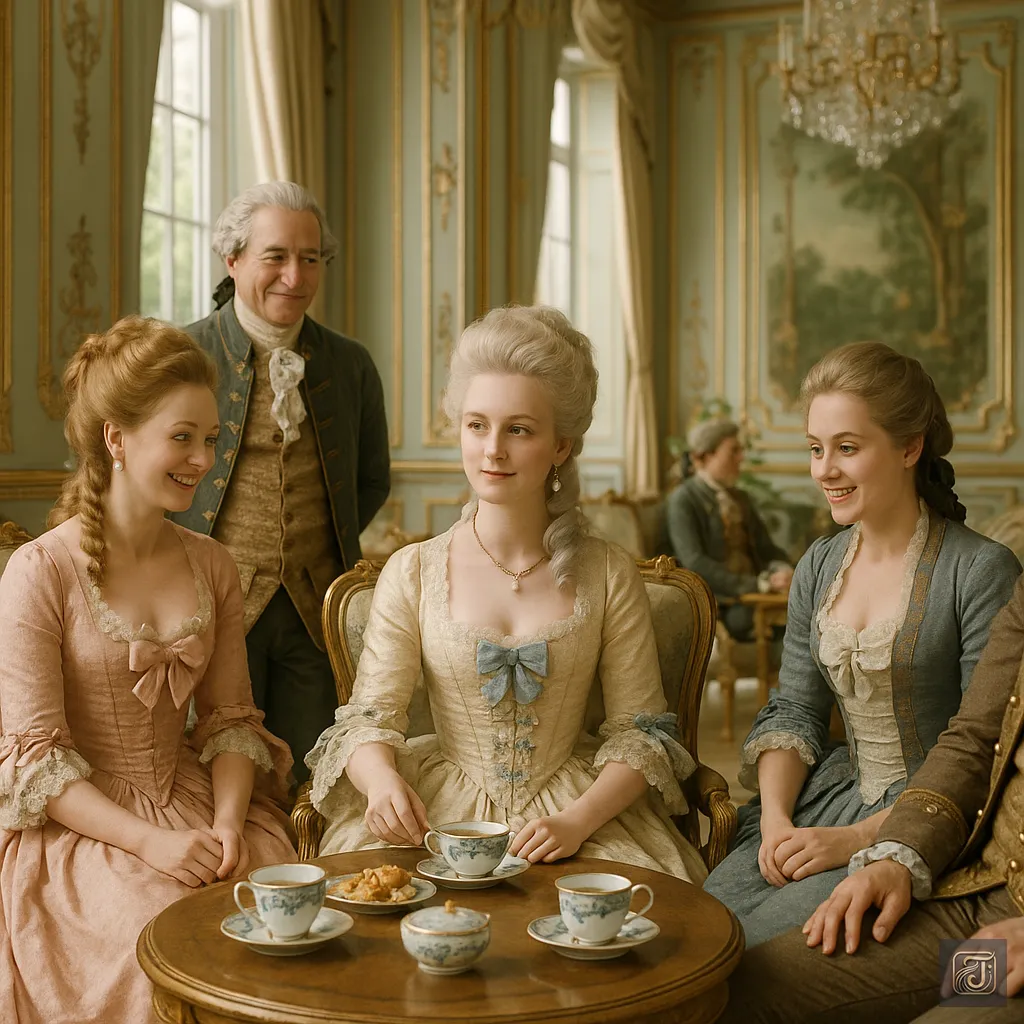
Marie Antoinette invited only a select group of close nobles to the retreat.
The strict rules of the royal court were disregarded entirely.
Anyone she didn’t like was simply banned from entering.

Marie Antoinette:
“Ah… this is my own little kingdom of freedom…”
There, she wore simple clothes,
sometimes even dressed as a peasant woman, indulging in idyllic, pastoral play.
But outside the palace walls, rumors began to spread.

Rumors:
“The Queen locks herself away in Petit Trianon, living in luxury.”
“She’s squandering our taxes for her own amusement.”
And yet, her husband, Louis XVI, remained indifferent to her actions.
Meanwhile—
The presence of Fersen, the man she met at the masked ball,
grew larger in her heart with each passing day.
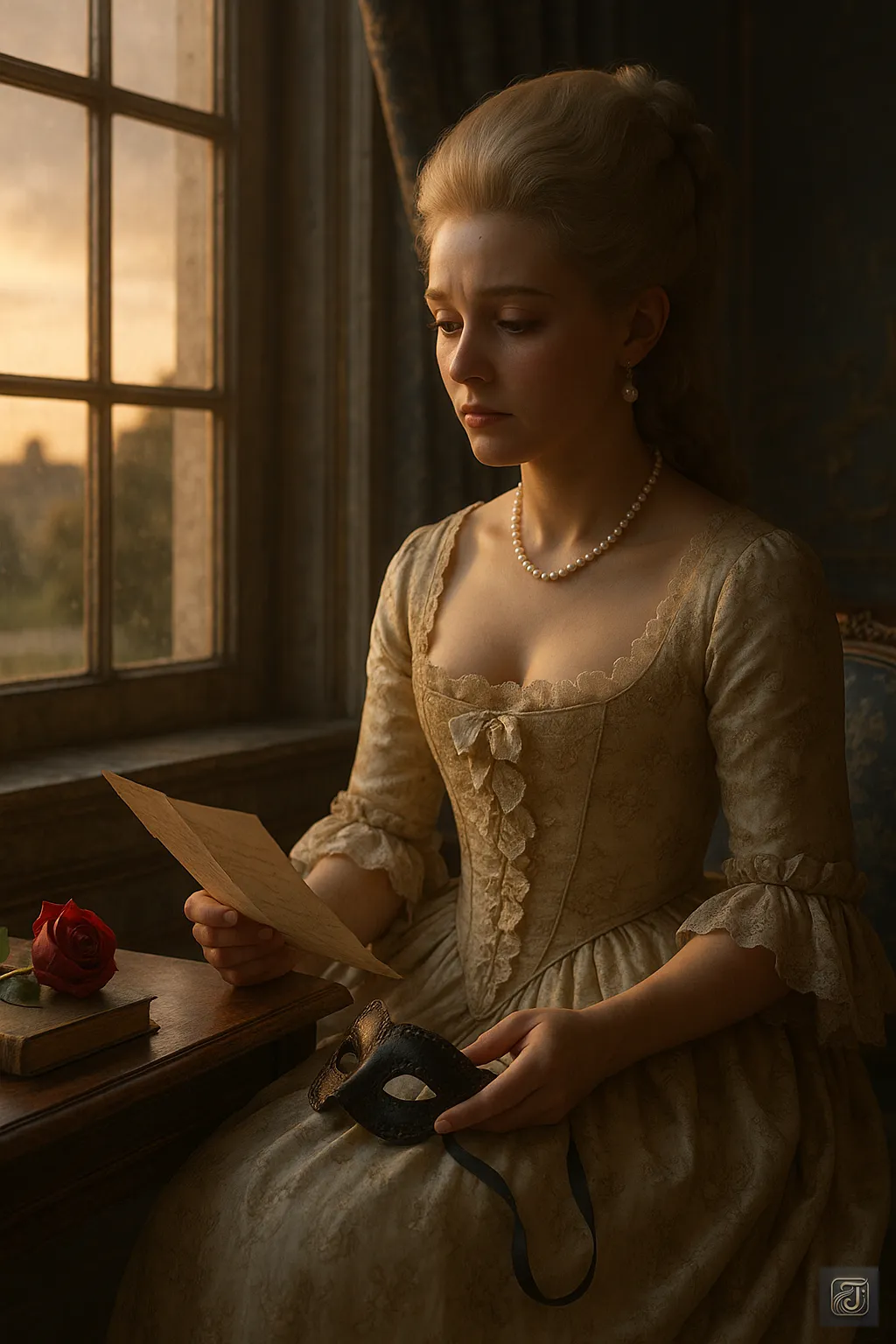
Marie Antoinette:
“Duty as a queen?”
“Pride as the king’s wife?”
“More than any of that… I just want to live my own life.”
But the price of that freedom
was quietly piling up—
In the form of the people’s growing resentment.
Chapter 6: Luxury, Gambling, and the Duchess of Polignac

Having secured her paradise in Petit Trianon,
Marie Antoinette finally had a place where she could feel truly free.
But that freedom would soon spiral into unchecked extravagance and growing dependency.
And during this time,
one woman appeared—
Someone the Queen would come to trust with all her heart.
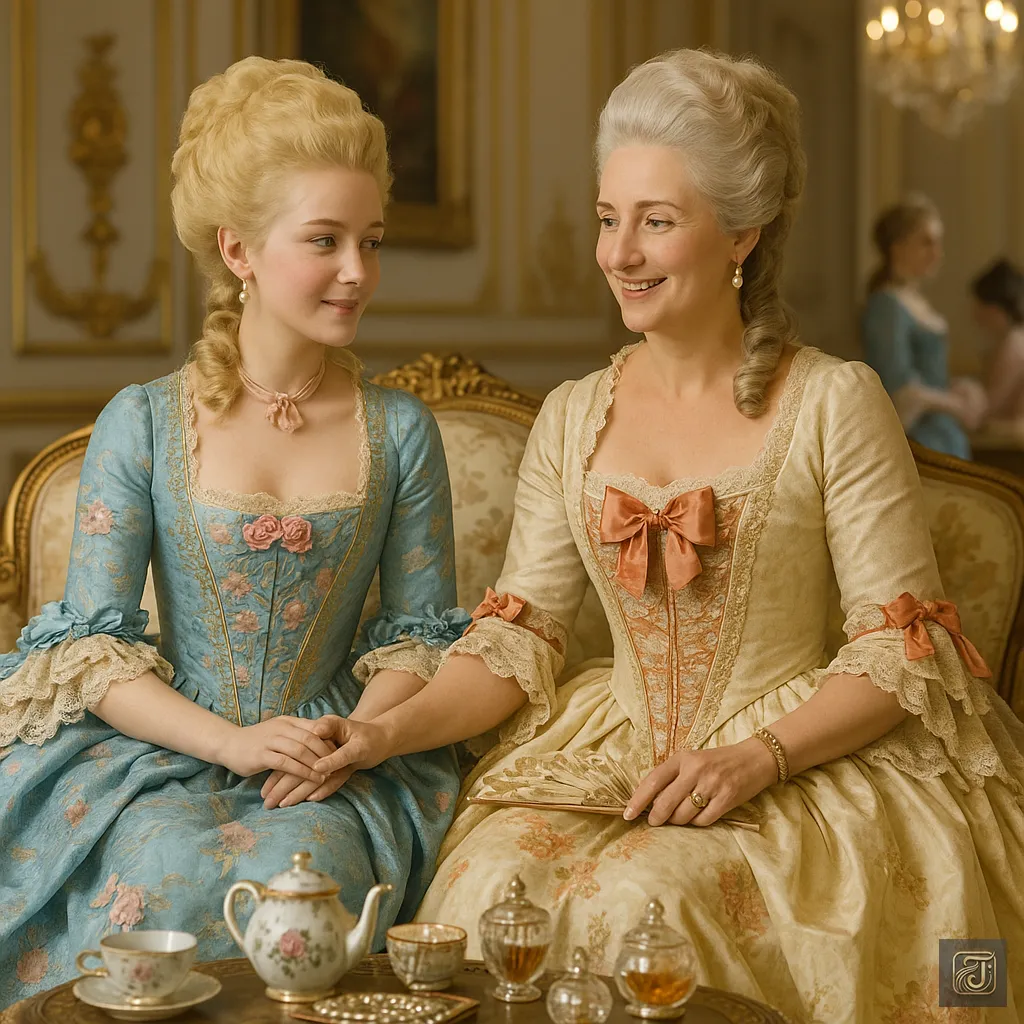
Her name was—Yolande de Polignac, the Marquise de Polignac.
She was intelligent, beautiful, and a radiant figure in the social circles of Versailles.
But above all, she possessed a rare gift—
the ability to pamper Marie Antoinette in exactly the way the Queen craved.

Madame de Polignac:
“At least when you’re with me, forget all those duties.”
With each soft whisper from Madame de Polignac,
Marie Antoinette found herself more and more drawn in.
Before long—
“If it’s for Madame de Polignac, I’ll give her anything she desires ❤”
—such was the relationship they came to share.
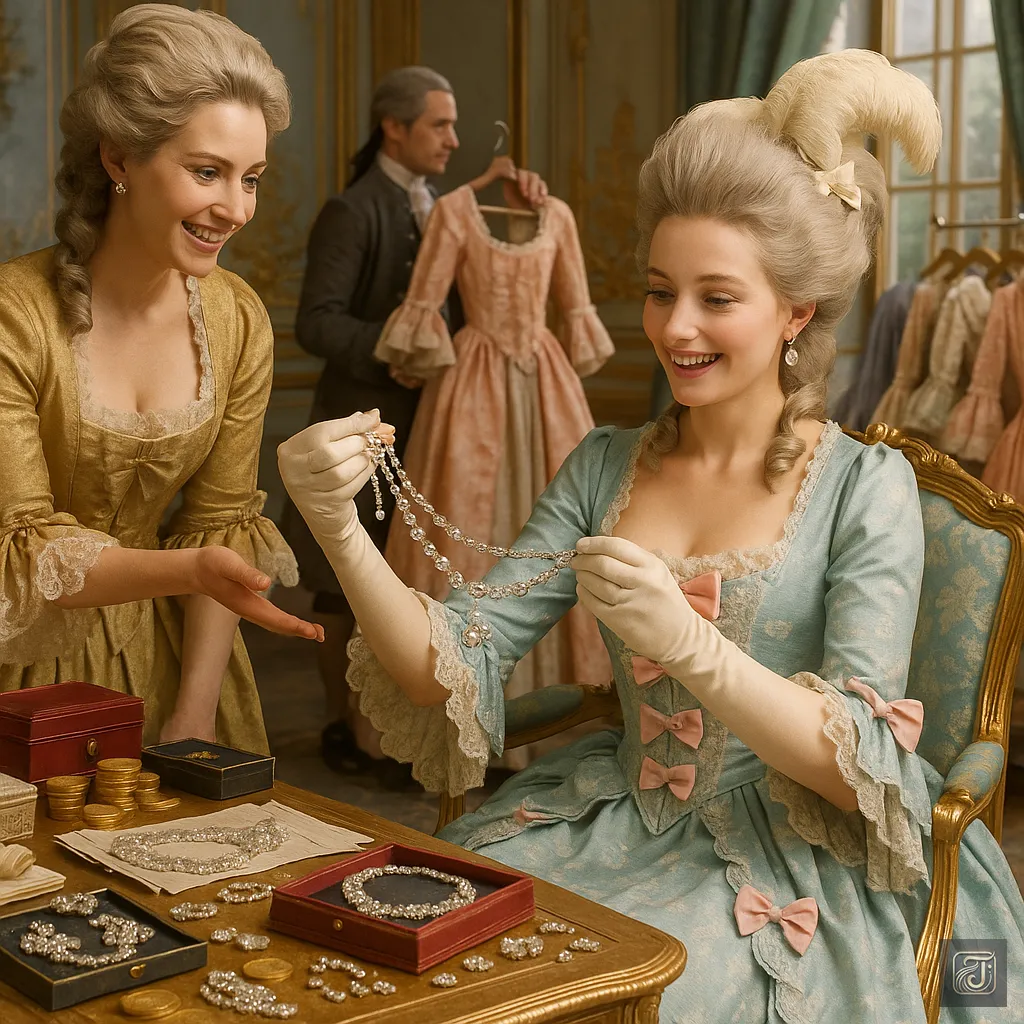
Madame de Polignac:
“I want more beautiful dresses.”
Marie Antoinette:
“Of course! I’ll have them all prepared for you ❤”
Madame de Polignac:
“I want a new carriage, too.”
Marie Antoinette:
“I’ll have one made right away ❤”
And so it began—
Expenses for dresses, carriages, jewelry…
An enormous sum was poured into her desires, one after another.
Naturally, it all came from the taxes collected from the people.
But that wasn’t the end of it—
Madame de Polignac introduced the queen to a new form of amusement.

Madame de Polignac:
“Gambling is so much fun, you know ❤”
At first, Marie Antoinette was hesitant.
But once she tasted the thrill—she was hooked.
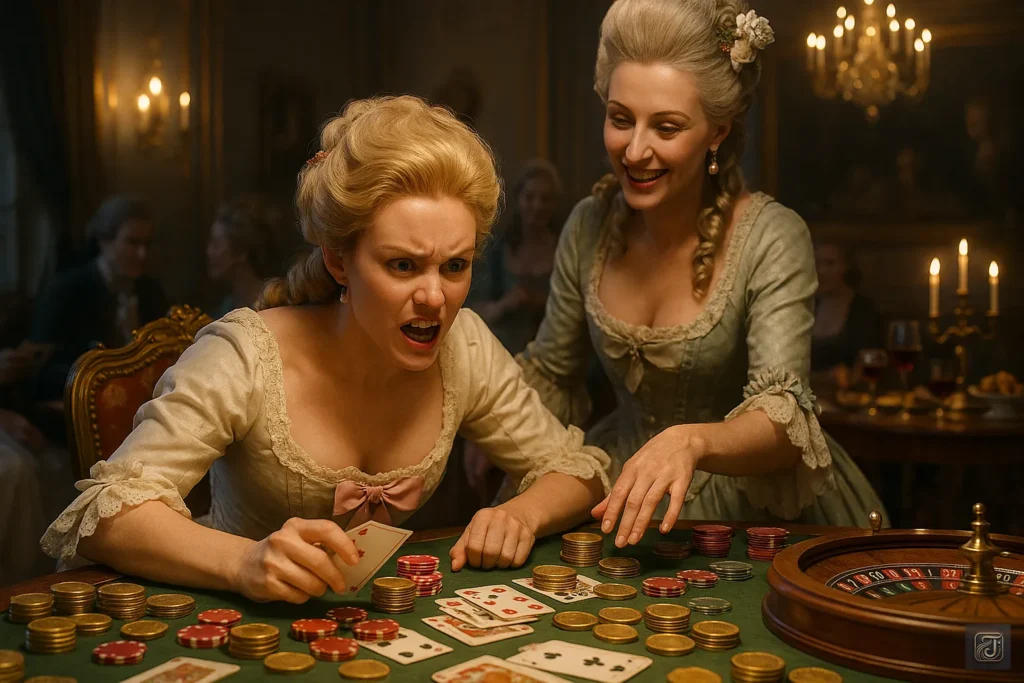
Marie Antoinette:
“Just one more round…!”
“I have to win this time…!!”
When she won, she threw lavish parties.
When she lost, she only raised the stakes, hoping to win it all back.
And of course, as the losses piled up—
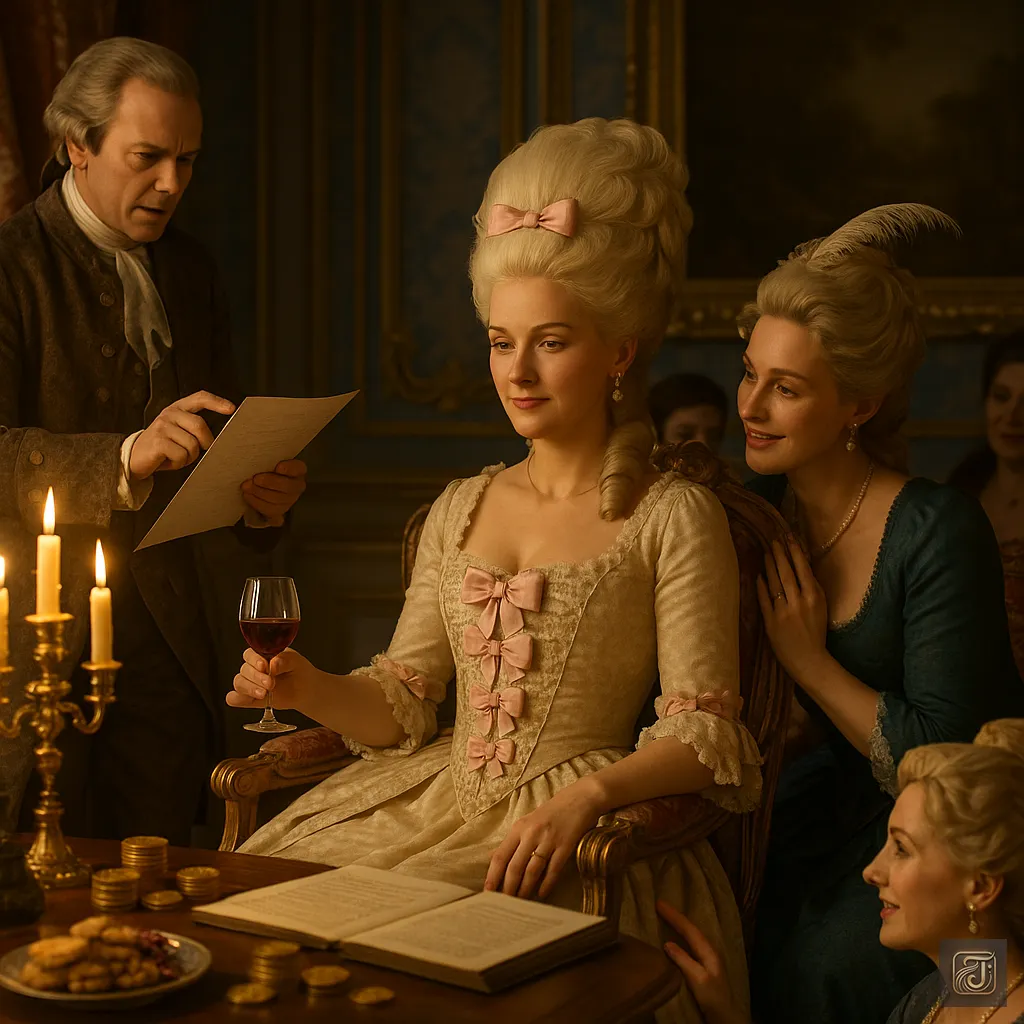
Marie Antoinette:
“Let’s raise the taxes again.”
And so, the queen’s extravagance became a bottomless pit.
Meanwhile, outside the walls of Versailles—

Citizens:
“We can’t even afford bread, and yet the queen owns hundreds of dresses!”
“If she has money for new jewels, why can’t she spare flour for the people?!”
The people’s anger was smoldering—growing, spreading, and ready to ignite.
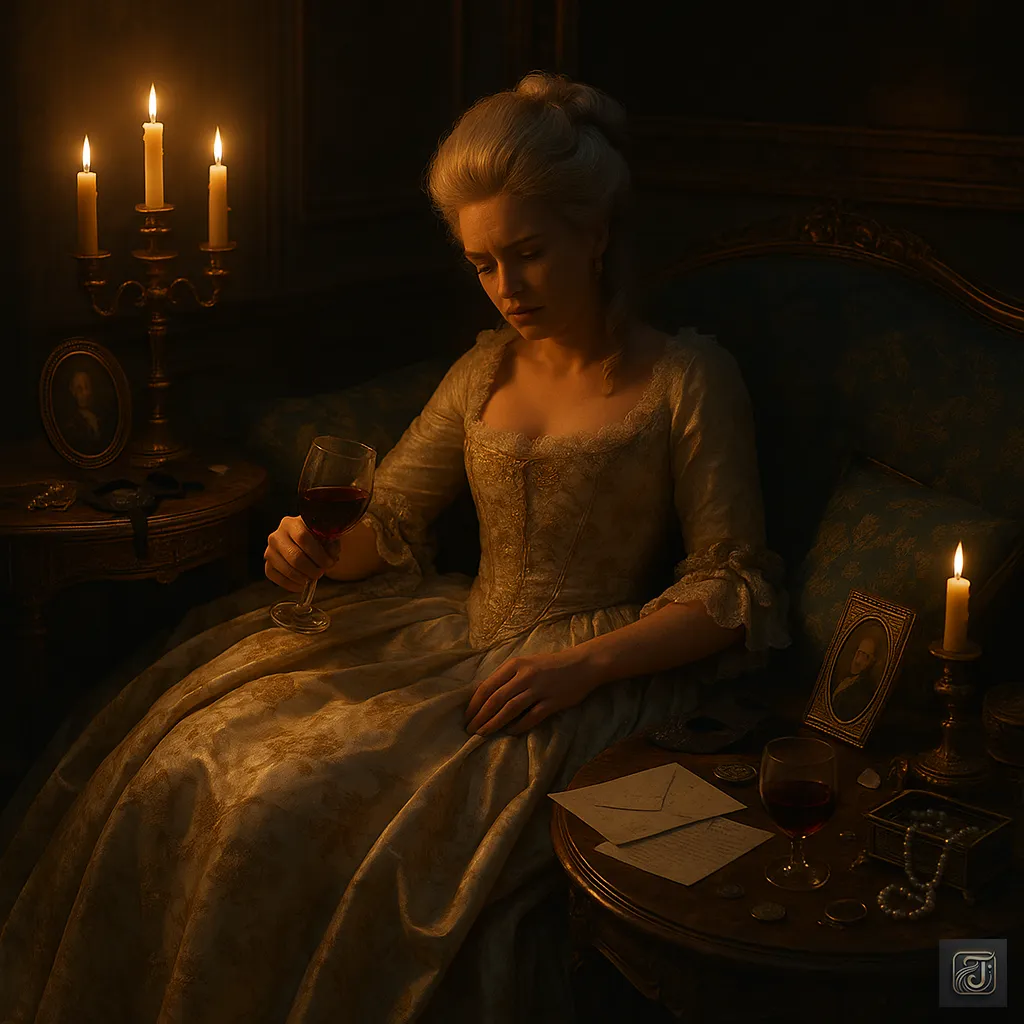
But the voices of the starving masses never reached Marie Antoinette, cloistered within the walls of the palace.
Worse still, her sole emotional refuge—Count Fersen—departed to fight in the American War of Independence.
His absence left a gaping void in her heart, and her loneliness only deepened.
To drown that ache, Marie Antoinette sank ever deeper into the comforts of luxury and pleasure—
dresses, jewels, games, and endless soirées.
But this “lavish escape” would soon turn against her—
turning the Queen herself into a symbol of hatred in the eyes of the people.
Chapter 7: The Man She Loved – Fersen, and the Fall into Despair
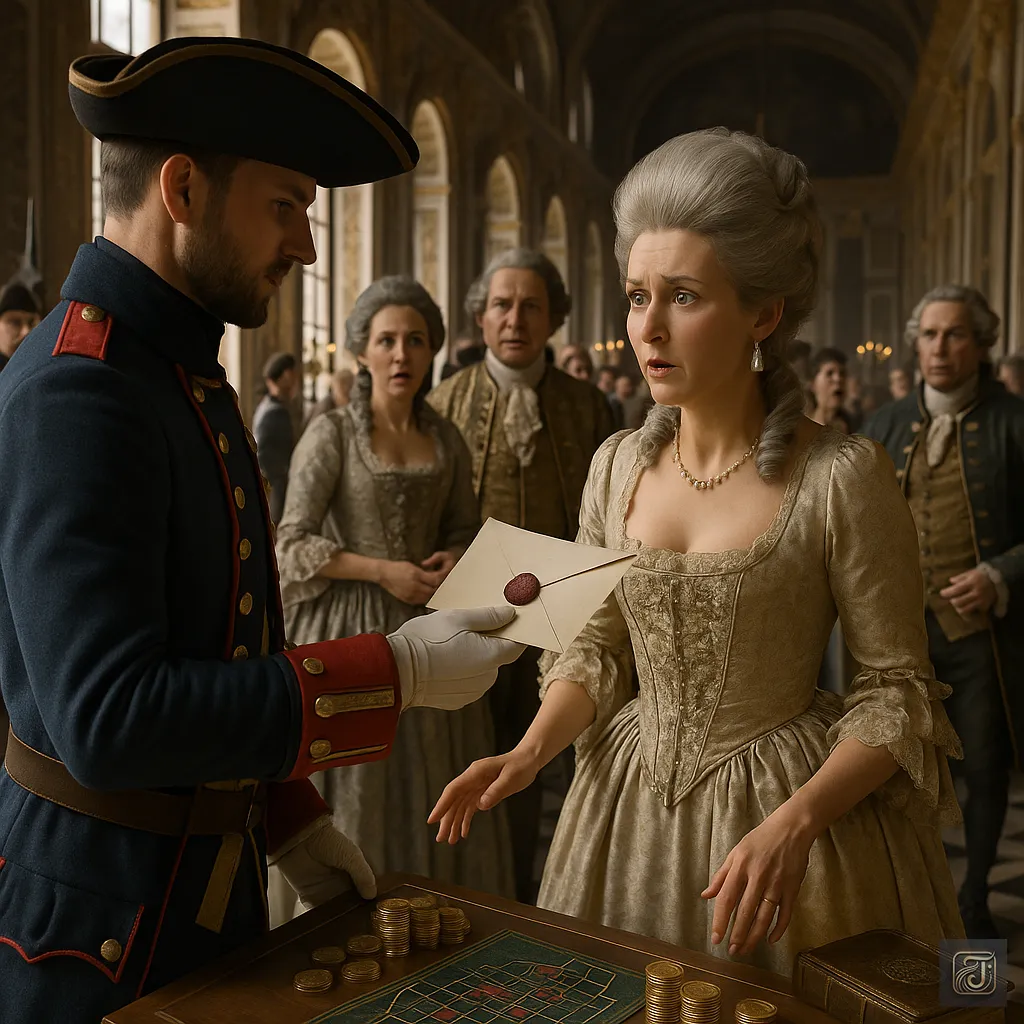
1778.
A joyful whisper swept through the halls of Versailles—
Hans Axel von Fersen had returned.
After serving in the American War of Independence,
He had finally come back to France.
Upon hearing the news, Marie Antoinette’s heart fluttered with anticipation.
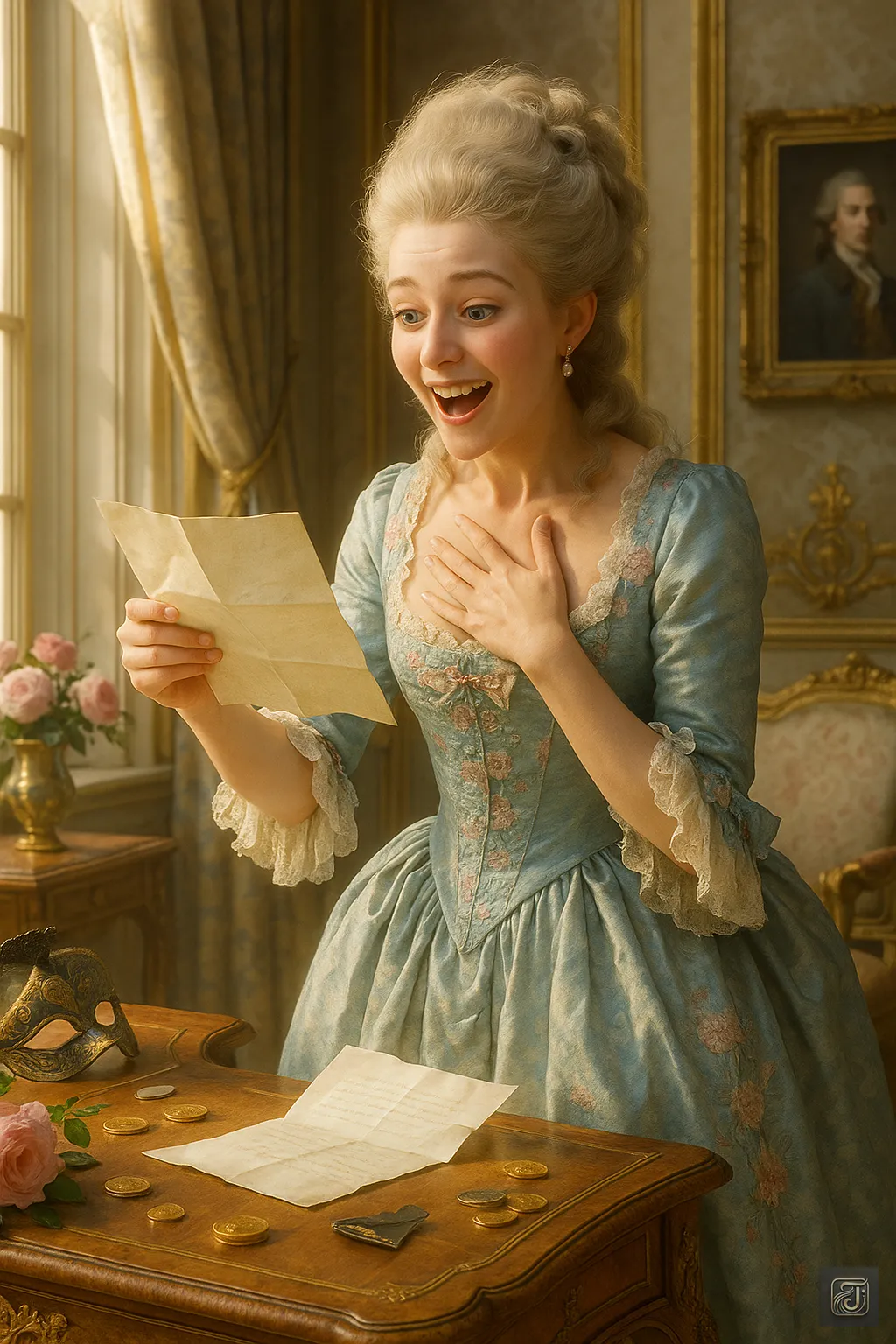
Marie Antoinette:
“At last… you’ve finally returned.”
Since the night they met at the masquerade,
Fersen had become an irreplaceable presence in her life.
The things her husband never gave her—
understanding, respect, the thrill of being seen—
Fersen gave her all of it.
And yet, it was a love that could never be.

Marie Antoinette:
“As queen, I cannot love him in the eyes of the world—”
Even so,
Fersen stayed by Marie Antoinette’s side.
Sometimes they exchanged warm, quiet words.
Other times, he watched from afar, silently worrying for her.
His presence became her emotional anchor—
her one refuge in a life of obligation and isolation.
But that fragile happiness…
was destined to shatter all too easily.
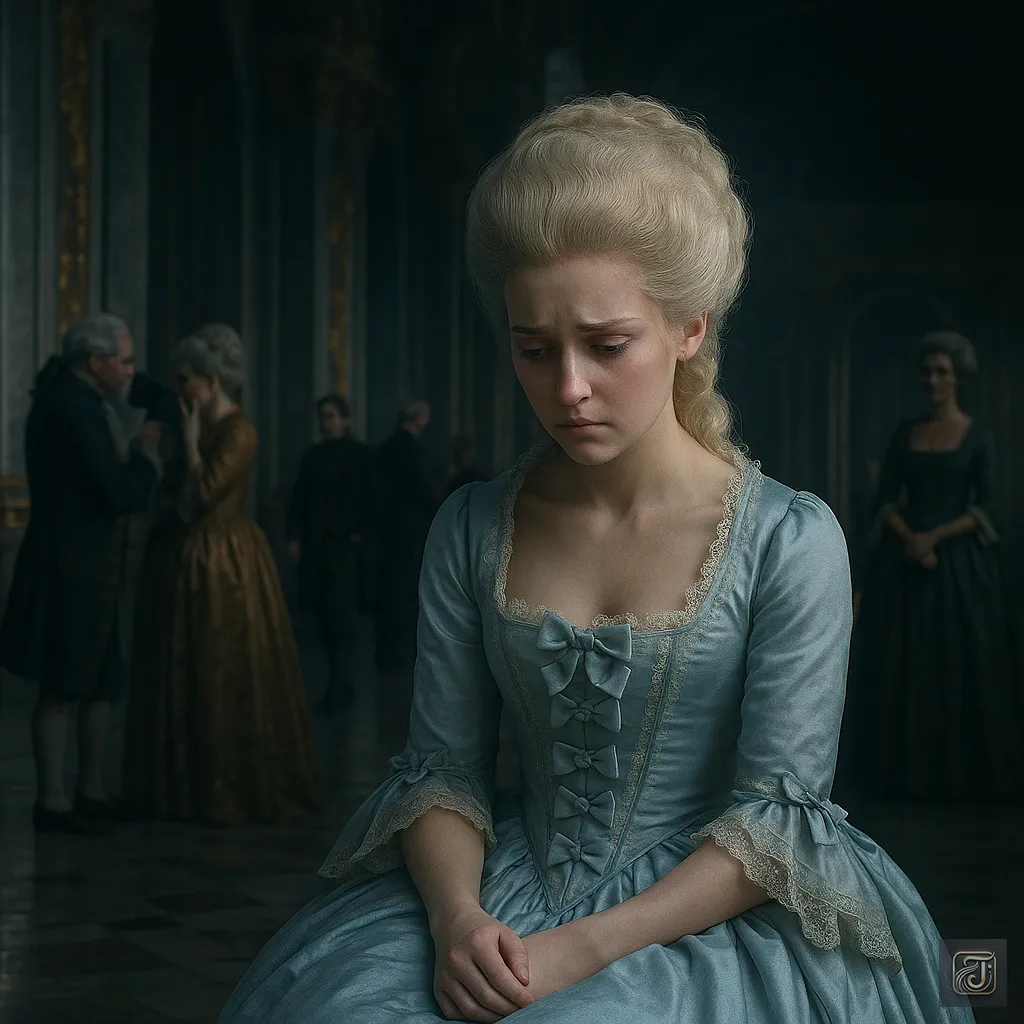
The royal finances were on the brink of collapse.
Even the nobles of the court gradually began to distance themselves from the queen.
Meanwhile, the anger of the people only continued to grow.

Citizens:
“When we’re starving, the queen is said to be playing at Petit Trianon!”
“She’s a woman of excess! Raising taxes while living in luxury…!”
Amidst such outcries,
Marie Antoinette grew ever more attached to Fersen.

Marie Antoinette:
“If I’m with you, I can forget everything… even just for a moment.”
But fate was not finished testing the queen.
Fersen had duties waiting for him—
military service and diplomatic missions in his homeland, Sweden.
He had to leave France once again.
The day she received the news,
Marie Antoinette was struck silent.

Marie Antoinette:
“Why…?”
“Why now… when I need you the most?”
Fersen gently took her hand and spoke with calm resolve.
Fersen:
“My Queen, I will return.”
“To protect you.”
“No matter what becomes of this country—”
Marie Antoinette’s lips trembled as she tried to reply.

Marie Antoinette:
“Fersen… don’t go…”
But her voice broke,
the words caught in her throat and never made it out.
Tears welled up in her eyes,
and before she could stop herself, she buried her face against his chest.
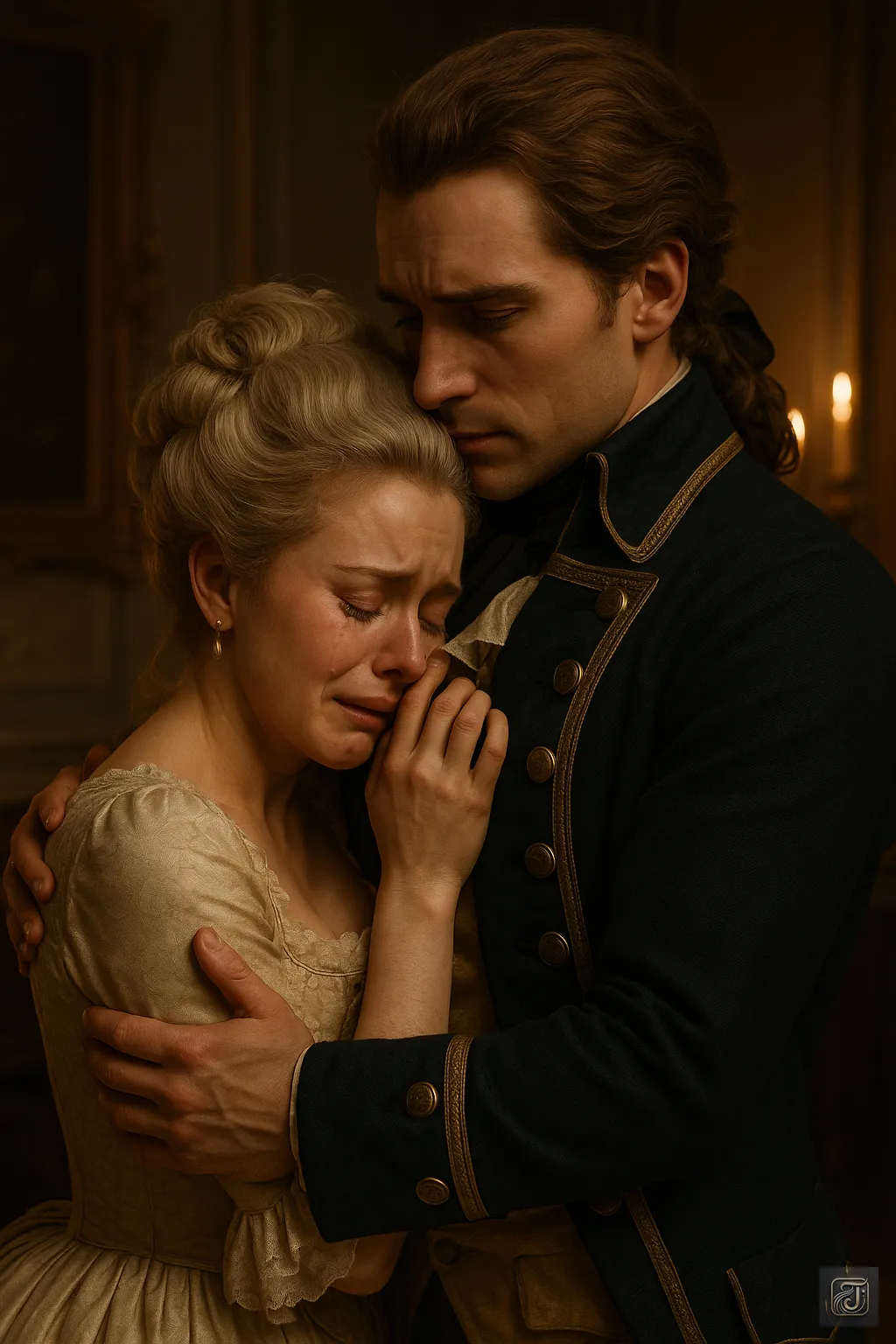
Marie Antoinette:
“I had… no one but you—”
Fersen’s lips trembled, as if he wished to say something.
But the words were swallowed,
And in silence, he gently released her hand.
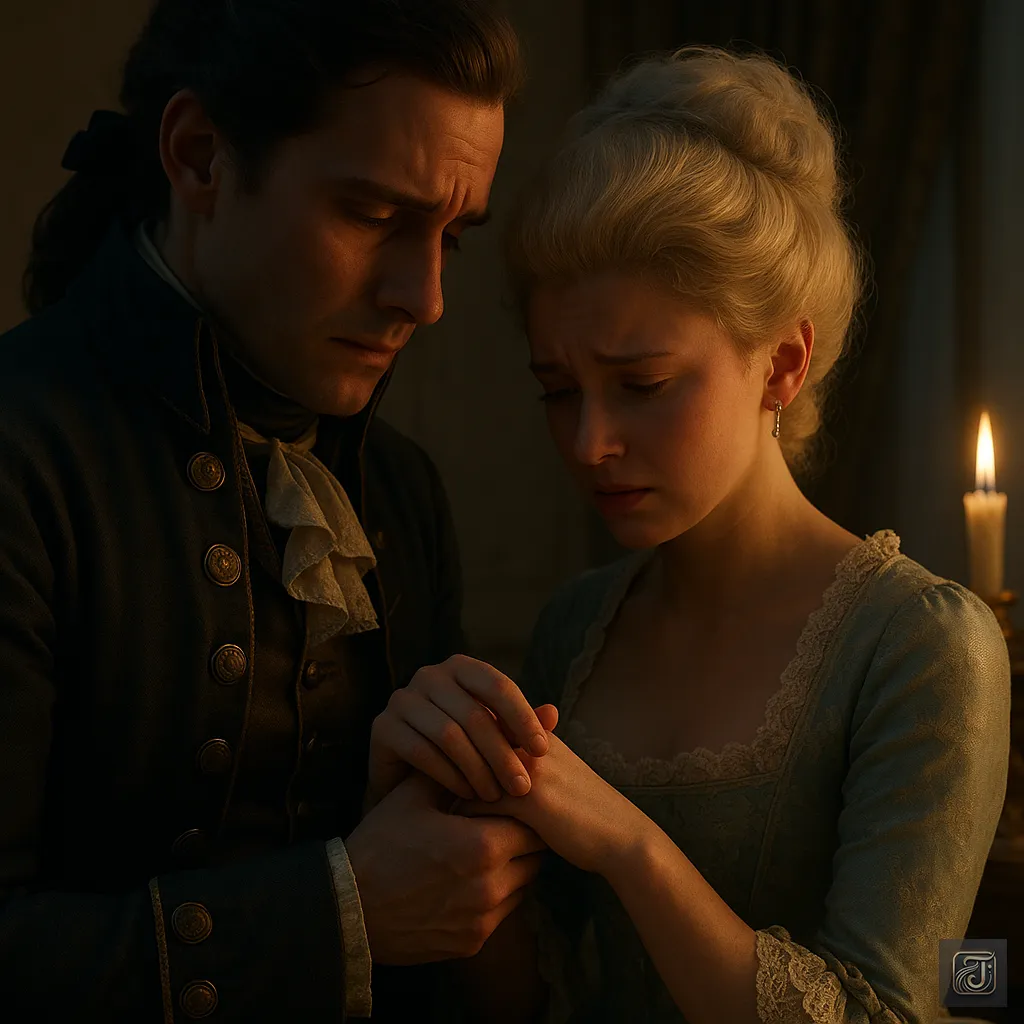
Fersen:
“I promise you—no matter what.”
Leaving behind only those words,
Fersen disappeared into the darkness of the night.
The queen collapsed where she stood,
her shoulders trembling as she struggled to stifle her sobs.
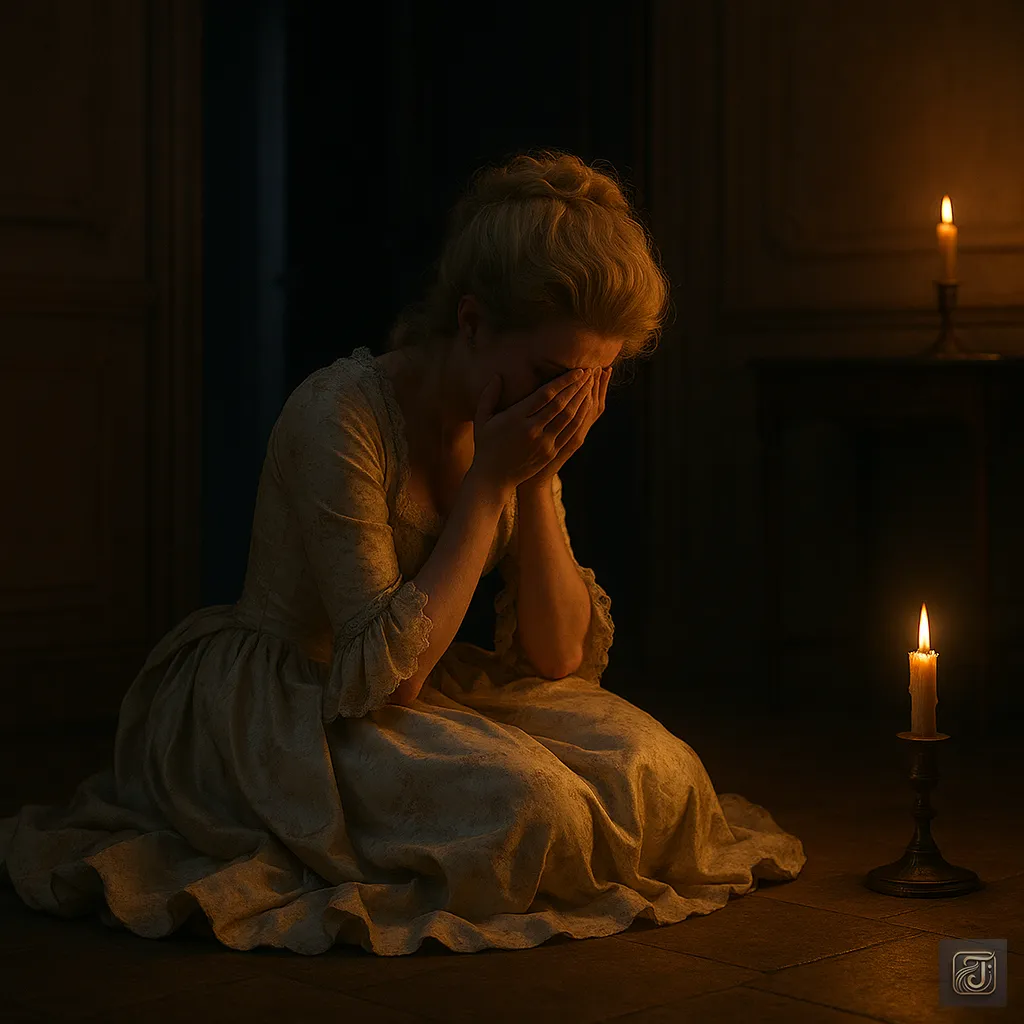
In that moment—
She truly lost her one and only pillar of support.
The queen’s heart was swallowed by a hollow darkness.
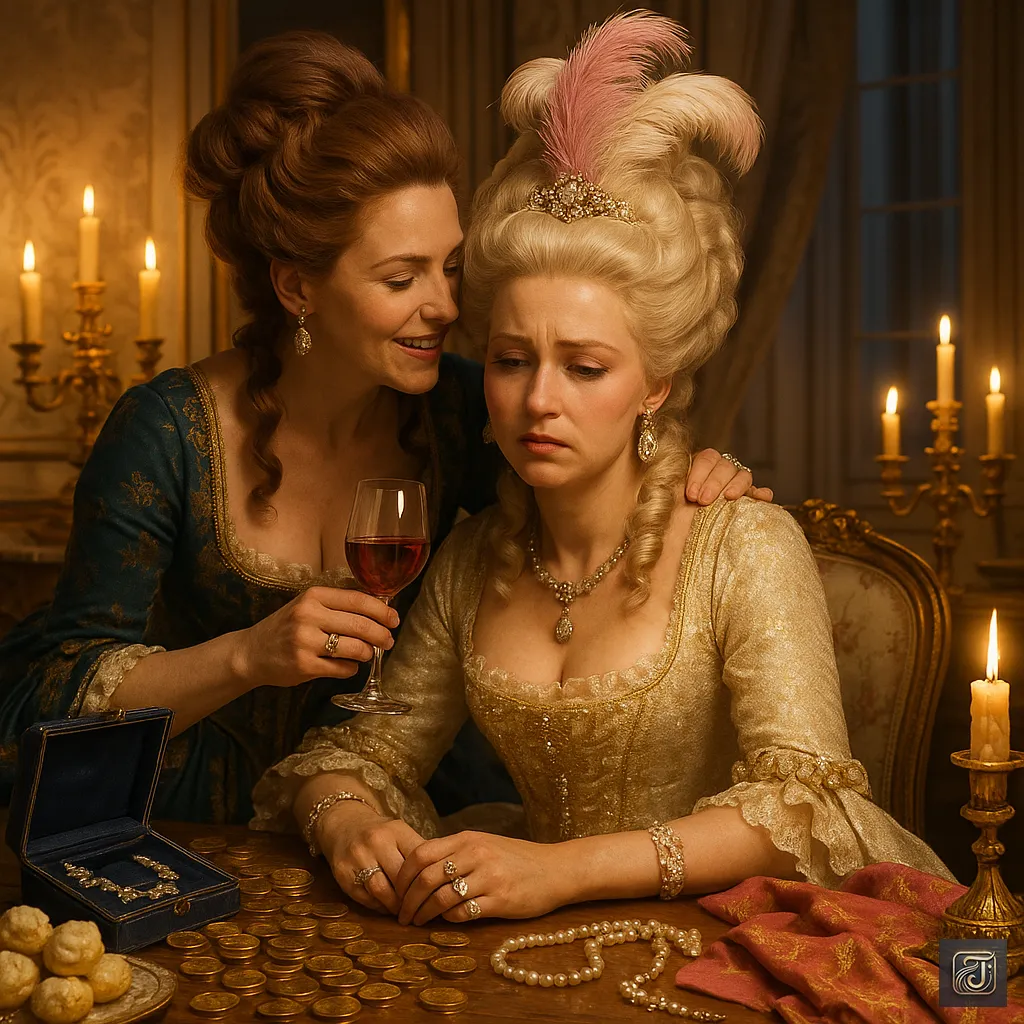
To fill the growing void in her heart—
Marie Antoinette clung even more desperately to Madame de Polignac.
Her days of indulgence and excess accelerated without pause.
But outside the gilded gates of Versailles,
the anger of the people had reached its breaking point.
And yet, Marie Antoinette remained unaware—
Unaware that these tremors were the early signs of a wave called “Revolution” that was about to swallow her whole.
Chapter 8: The Affair of the Diamond Necklace
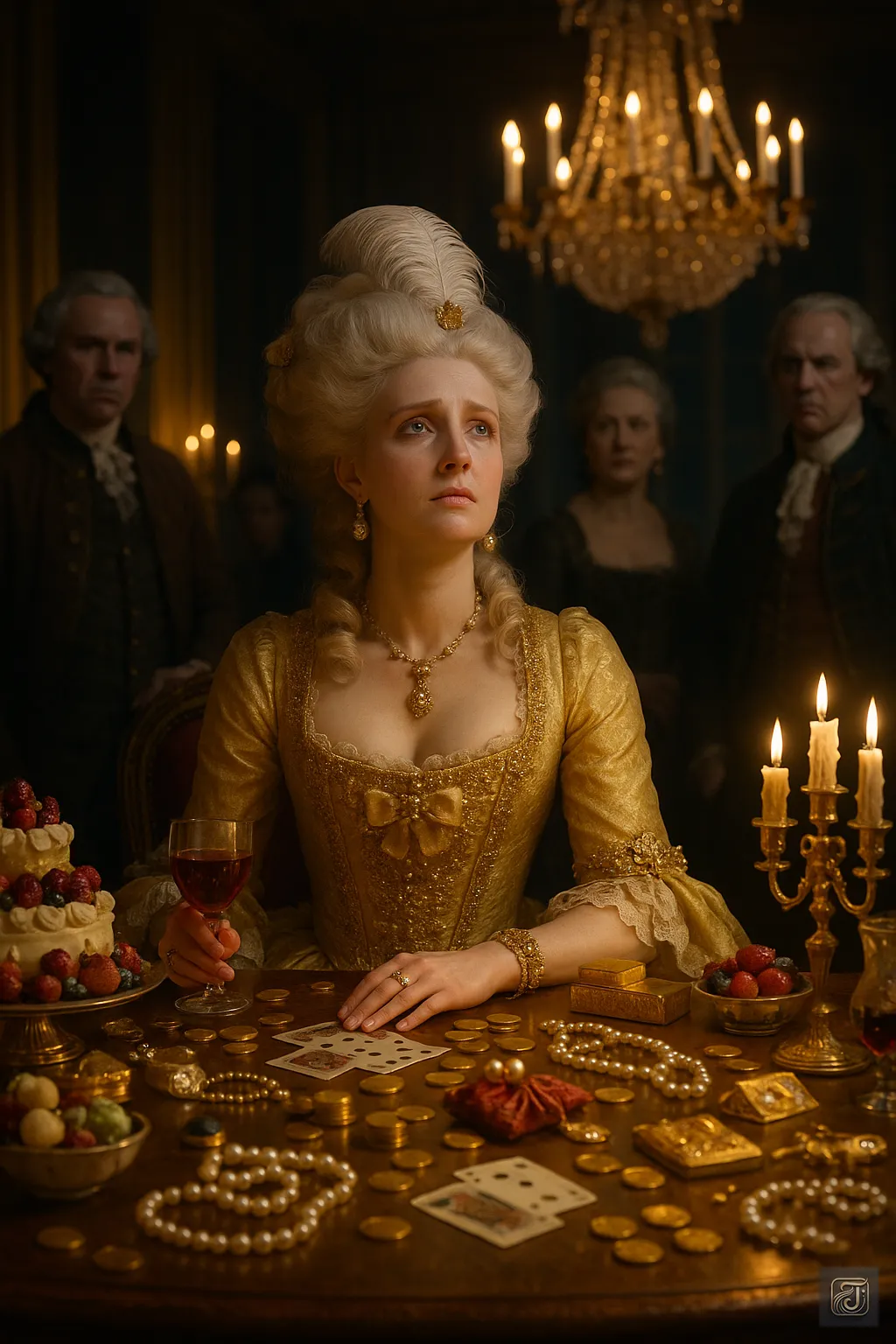
1785.
The air around Queen Marie Antoinette was growing colder with every passing day.
Fersen had returned to his distant homeland of Sweden,
and with him, the queen’s emotional anchor was gone.
In an attempt to fill the void of loneliness,
Marie Antoinette plunged deeper into luxury and pleasure.
The fury of the people was on the verge of erupting.
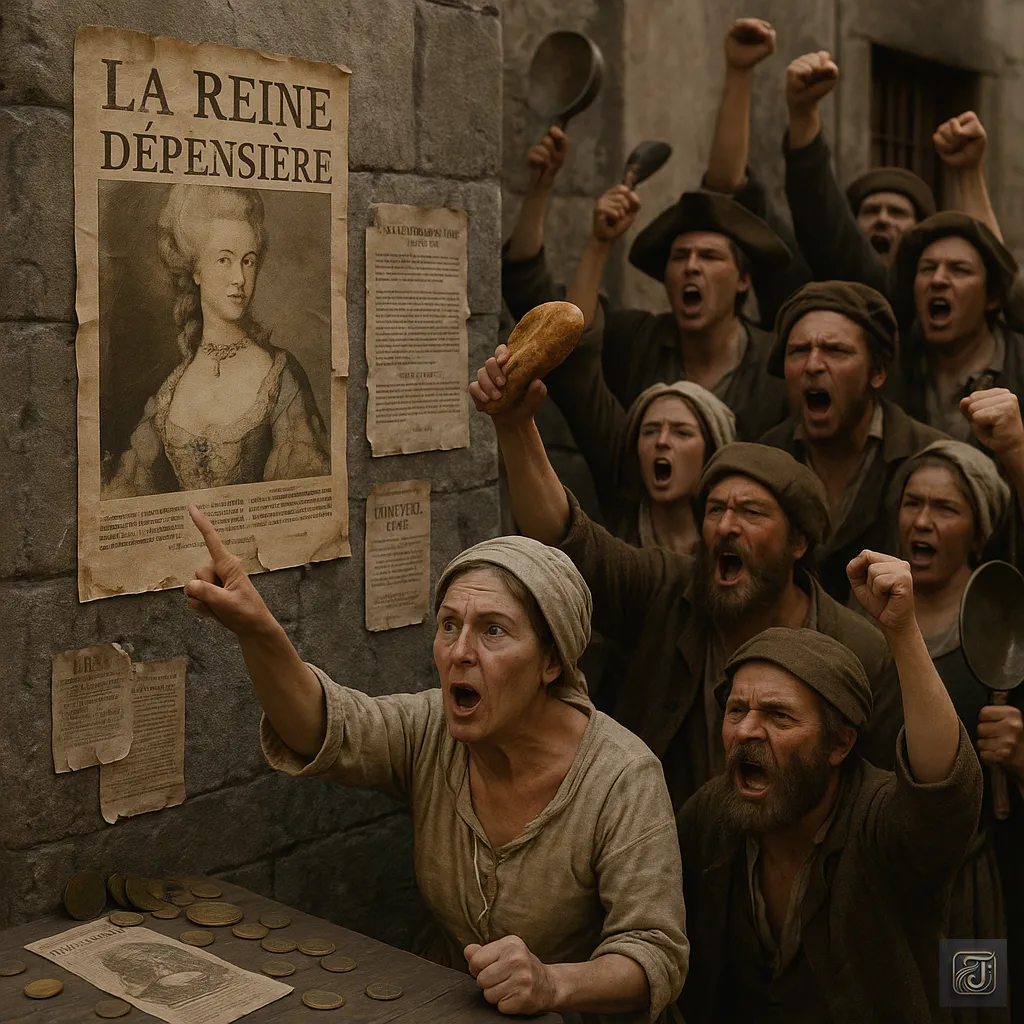
Citizens:
“We can’t even afford bread!”
“And the queen pours gold into her jewelry!”
It was at that moment that a scandal erupted—
One that would shake the very foundations of the royal court.
The Affair of the Diamond Necklace
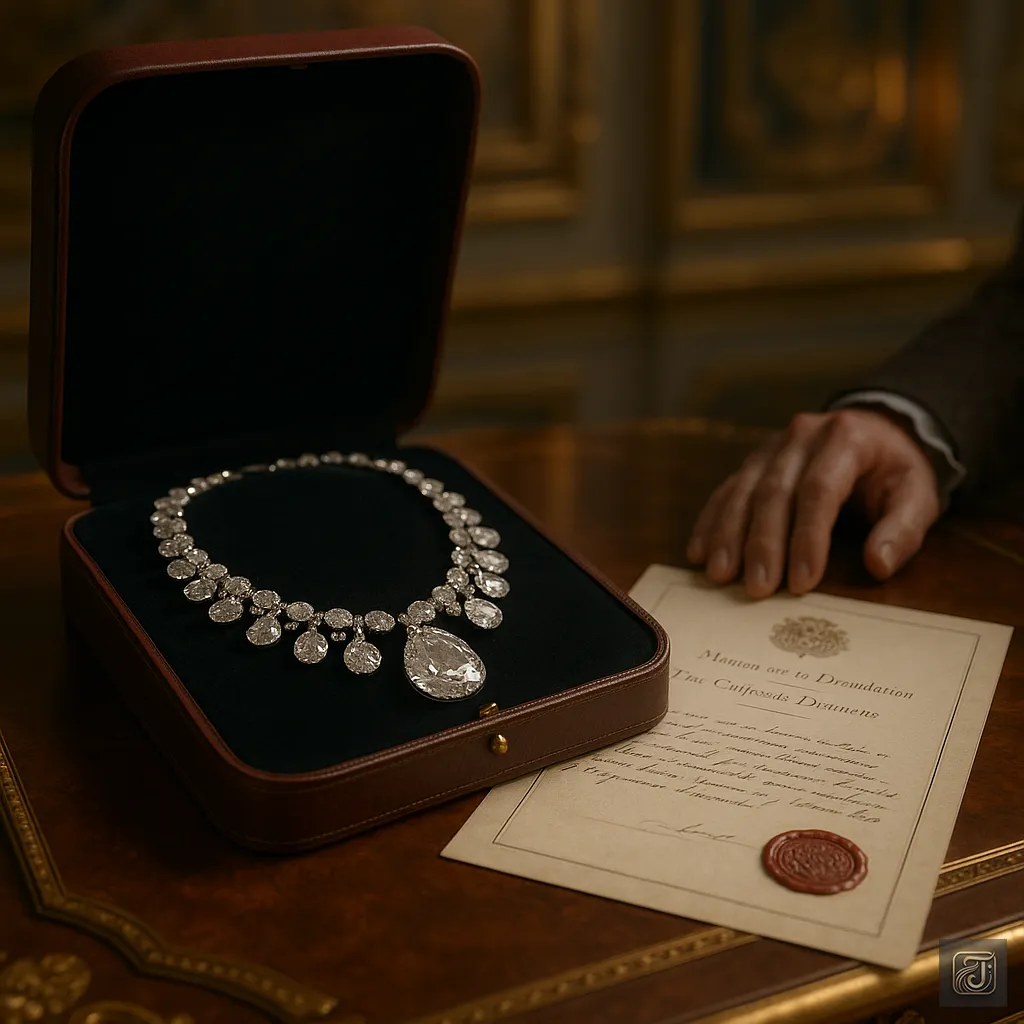
It all began with a massive diamond necklace—
weighing nearly 2,000 carats.
Originally commissioned by Louis XV for his mistress, Madame de Pompadour,
The necklace had no purpose left after the king’s sudden death.
And so, the extravagant piece—laden with jewels—remained unsold, suspended in limbo,
Waiting for a buyer worthy of its dazzling price.
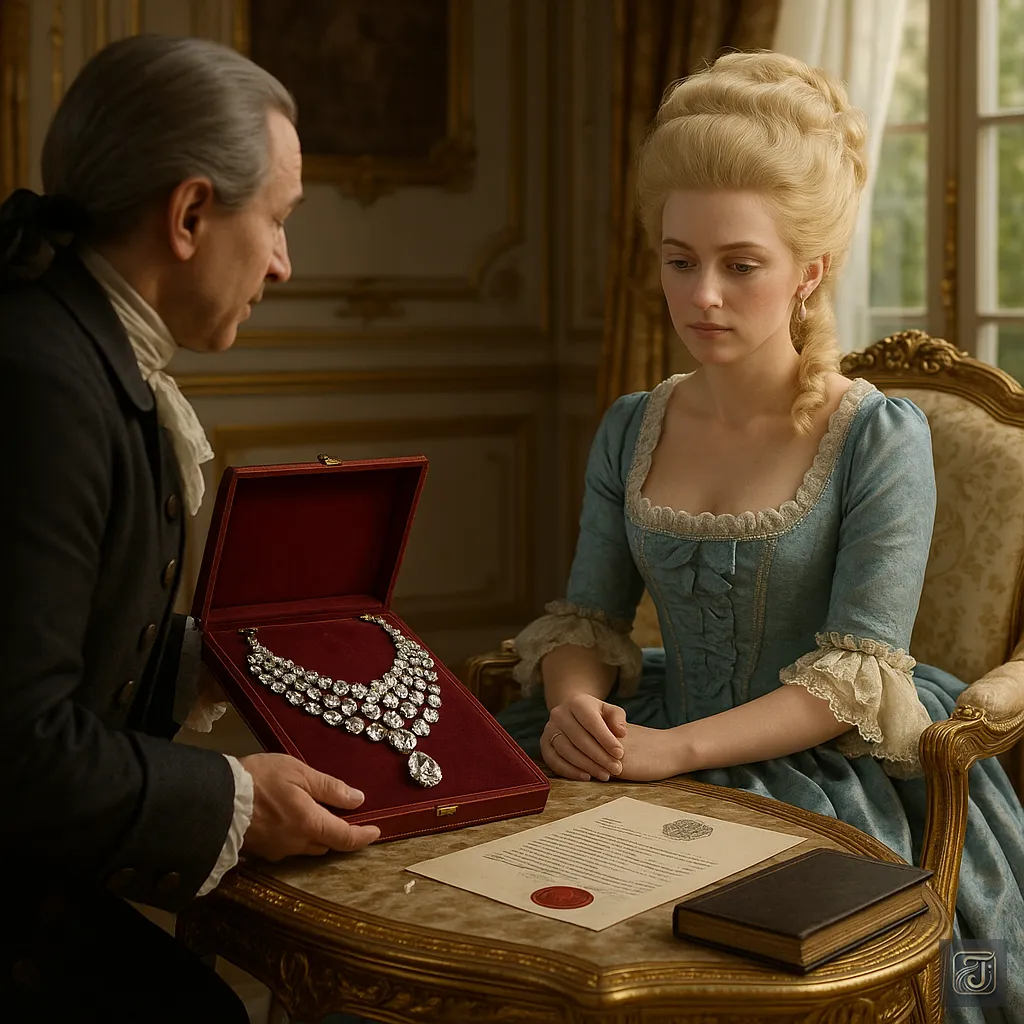
The jeweler:
“Only Her Majesty the Queen could possibly afford such a treasure…”
With that belief, the jewelers approached Marie Antoinette.
But the queen flatly refused to buy it.
Her reason was simple: the price was outrageous.
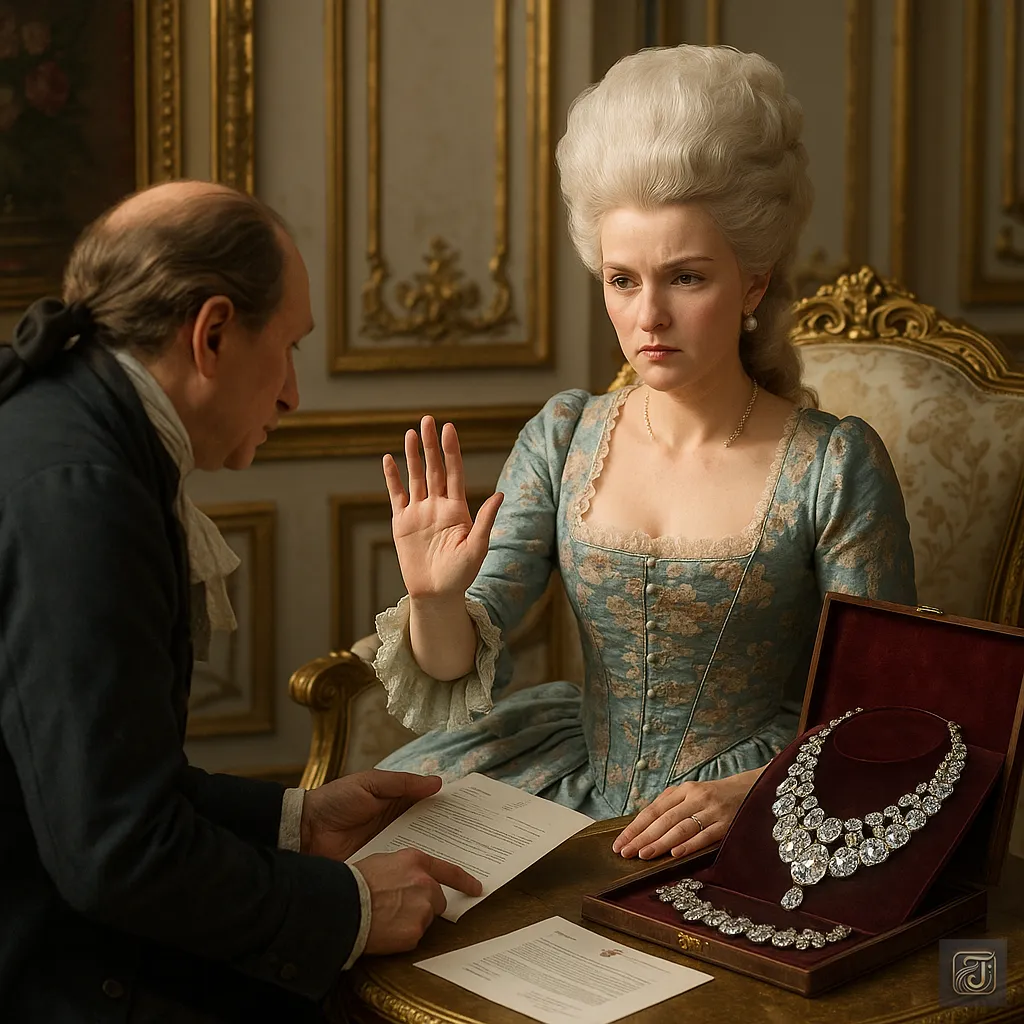
Marie Antoinette:
“I can’t possibly buy this.”
“It’s far too expensive.”
The diamond necklace, crafted without a hint of compromise in its beauty,
had ended up costing more than a warship.
Once again rejected, the desperate jewelers were left wringing their hands,
wondering who on earth could afford such a thing.
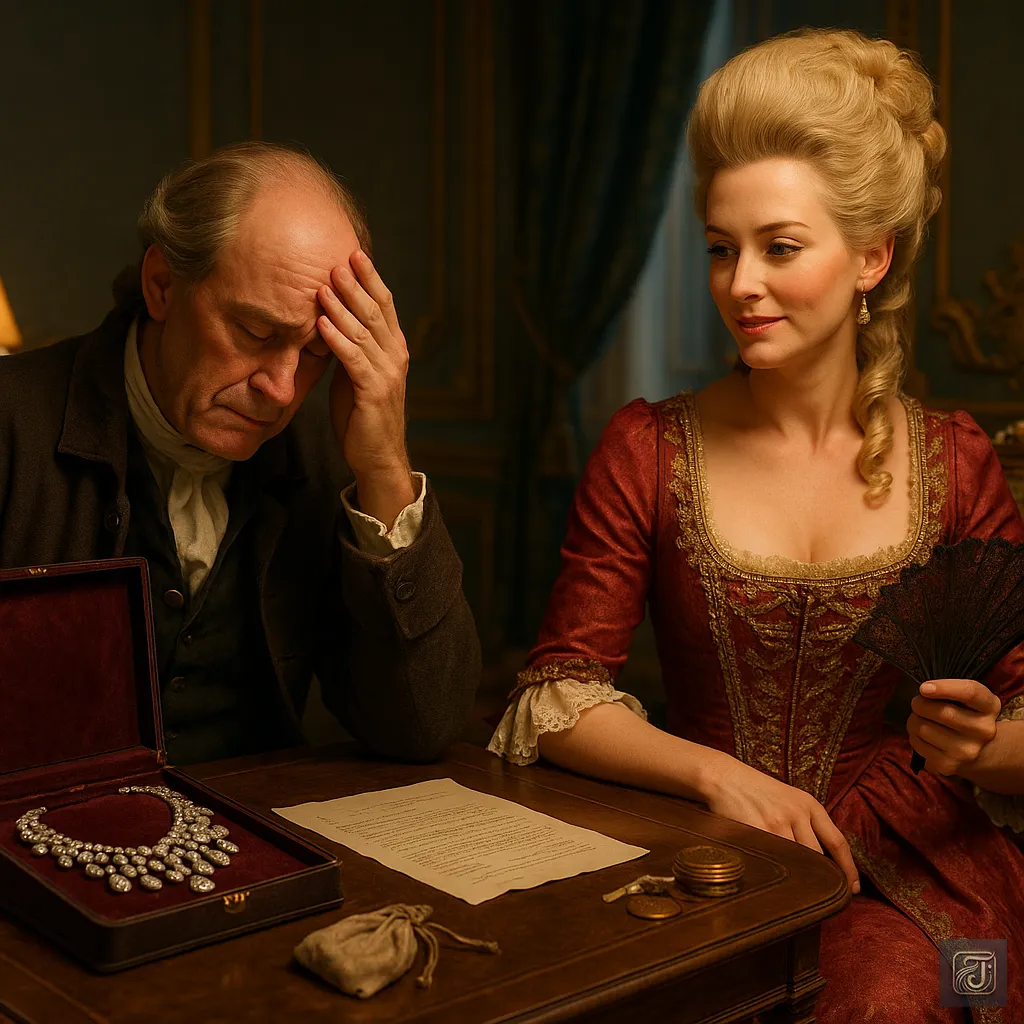
At that moment, a cunning and ambitious woman made her move—
Jeanne de la Motte, a self-styled countess with grand ambitions.
Meanwhile…
Cardinal Louis de Rohan was still tormented by the Queen’s past disdain,
desperately seeking a way to regain her favor.
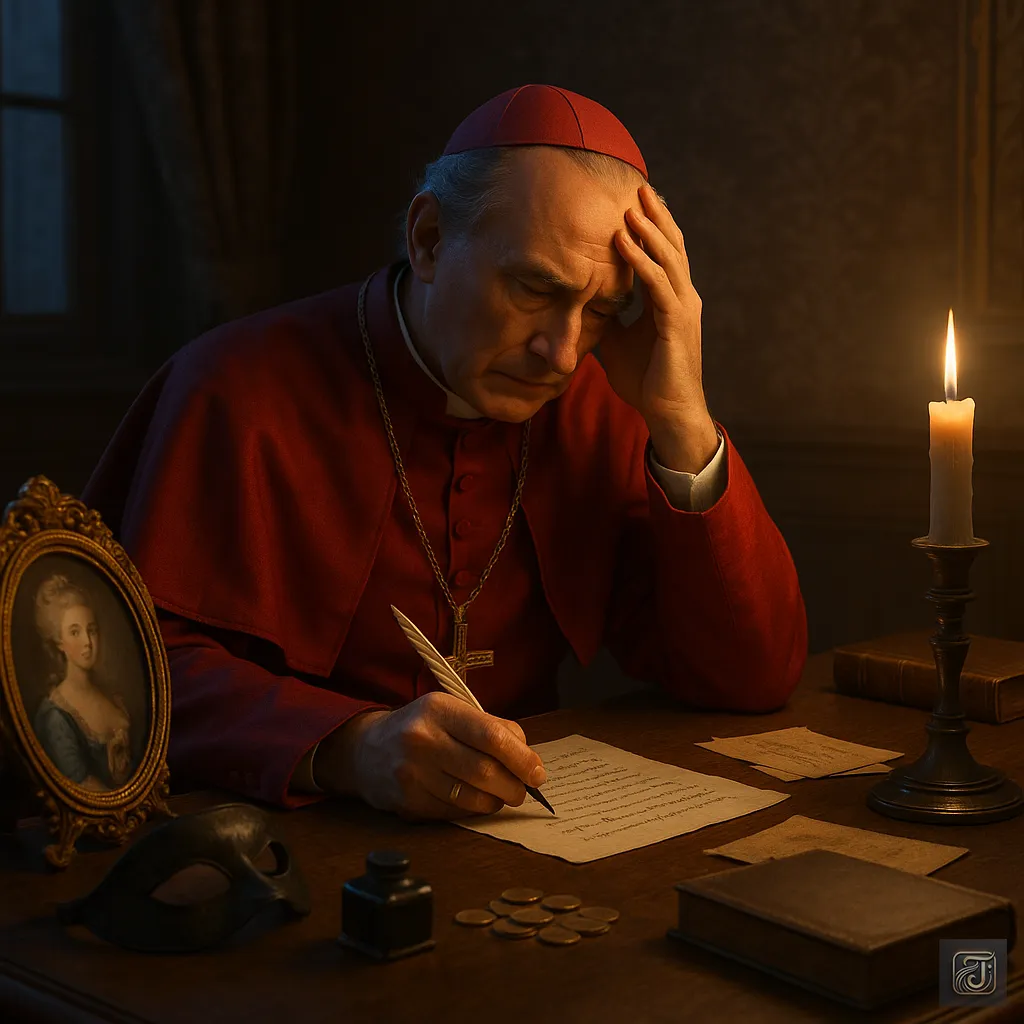
Louis de Rohan:
“I want to regain the Queen’s favor—”
Sensing an opportunity, Jeanne skillfully approached him.

Jeanne de la Motte:
“I am close to Her Majesty.”
“She has asked me to entrust you with the matter of the necklace ❤.”
She even presented letters bearing a forged royal signature.
Jeanne de la Motte:
“Her Majesty requests that you temporarily cover the cost of the necklace.”
“She will repay you in installments, I assure you—personally.”
Louis de Rohan:
“This is it! The Queen trusts me! I can regain my place at court!”
And so, a transaction that had absolutely nothing to do with the Queen herself was set into motion.
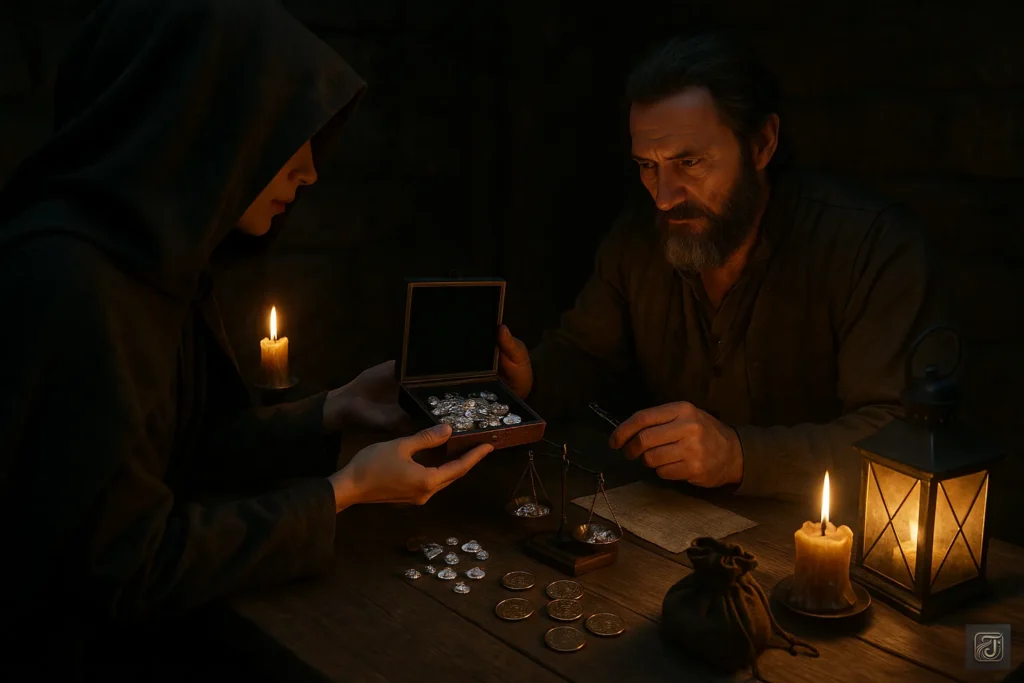
The necklace ended up in Jeanne’s hands and was smuggled out of the country.
To cover their tracks, the diamonds were dismantled and sold off piece by piece—a flawless concealment.
But—of course—
No payment was ever made.
Growing suspicious, the jewelers finally approached Marie Antoinette directly to demand answers.
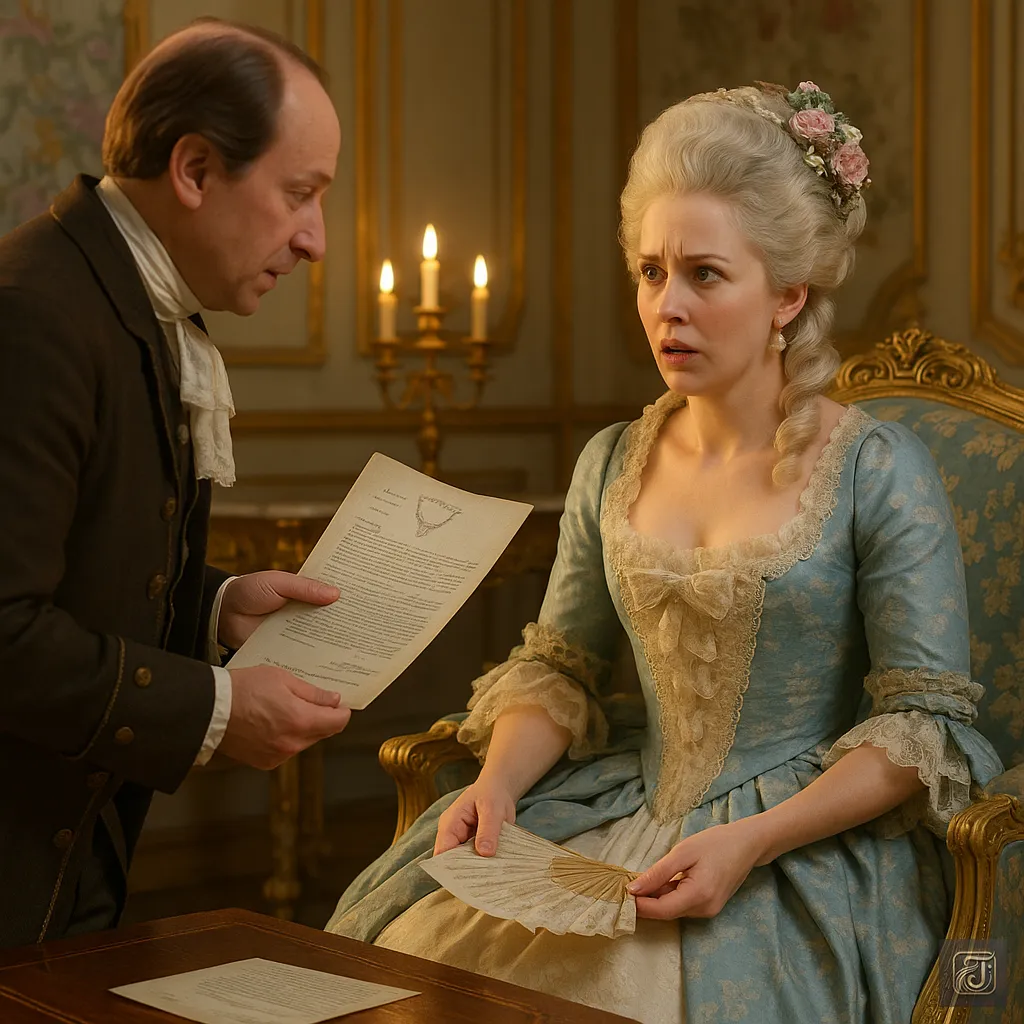
The jewelers:
“Your Majesty, the payment for the necklace is still pending…”
Marie Antoinette was stunned.
Marie Antoinette:
“What are you talking about!?
I never requested such a thing!!”
The jeweler:
“But… here is your signature, clear as day…”
At that moment, Louis XVI, who had been silently observing, spoke:
Louis XVI:
“Show me that letter.”
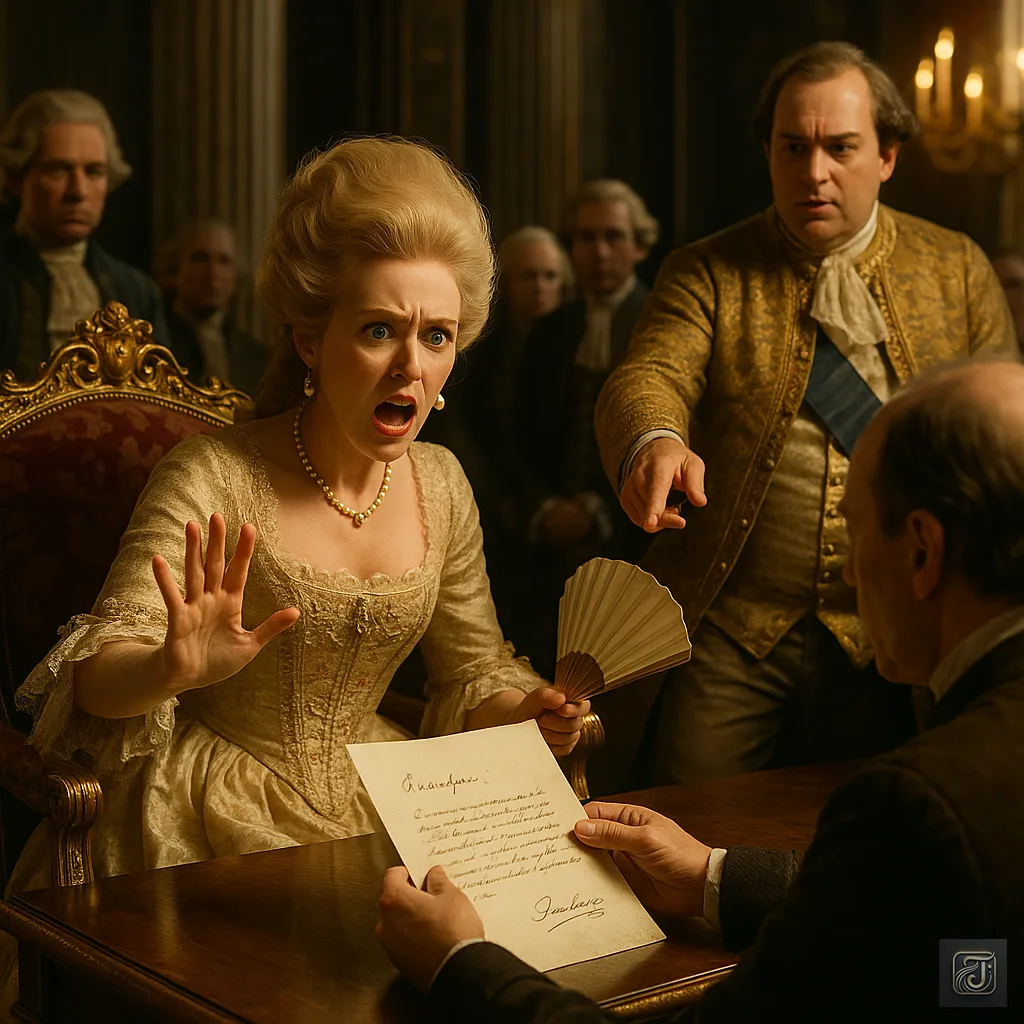
Louis XVI:
“This is not Her Majesty’s signature. It’s a forgery.”
Marie Antoinette:
“Of course it is. I never signed any such letter!”
The signature read:
*”Queen Marie Antoinette.”*
However, everyone within the royal court knew—Marie Antoinette **never** signed documents that way.
She always used simply:
*”Marie Antoinette.”*
It was an unmistakable red flag.
With this revelation, the deception was laid bare.
At the king’s command, Cardinal de Rohan was arrested.
In court, Rohan pleaded desperately,
Louis de Rohan:
“I only wished to restore Her Majesty’s trust!”
“I was deceived!”
“I truly believed it was her will!”
But the scandal had already taken root—and the court of public opinion had no interest in truth.

Louis de Rohan:
“I was deceived too!”
“Look—right here! This is the Queen’s signature! Who wouldn’t believe it at first glance?”
“I’m a victim in all of this!”
He raised the forged letter high for the court to see, his voice trembling with desperation.
But his protests, no matter how impassioned, only deepened the chaos—because at that moment, the public wasn’t looking for facts.
They were looking for someone to blame.
And the name “Marie Antoinette” was already engraved in their fury.
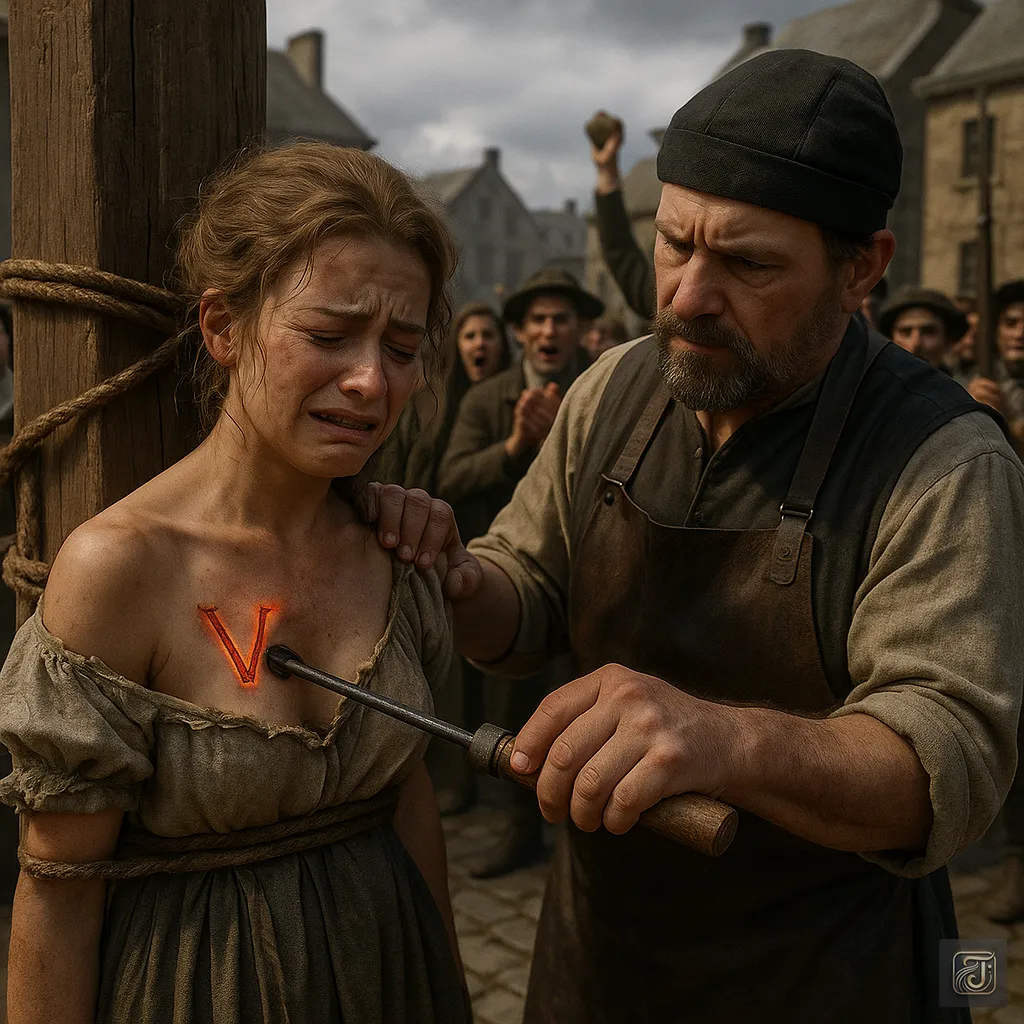
In the end, Rohan was acquitted.
Jeanne was found guilty as a thief.
She was arrested, publicly tried, and sentenced.
Dragged through the streets of Paris,
her shoulder was branded with the letter “V” — Voleuse (thief) —
a punishment meant to humiliate her completely.
Legally, the matter was closed.
The verdict declared: “The Queen was entirely a victim.”
But—
The hearts of the people told a different story.

Citizens:
“Don’t be ridiculous! This is obviously a scheme by the Queen!”
“She’s pinning the blame on a con artist just to save herself!”
“She’s the real mastermind behind it all!”
No one believed the Queen.
Why?
Because—
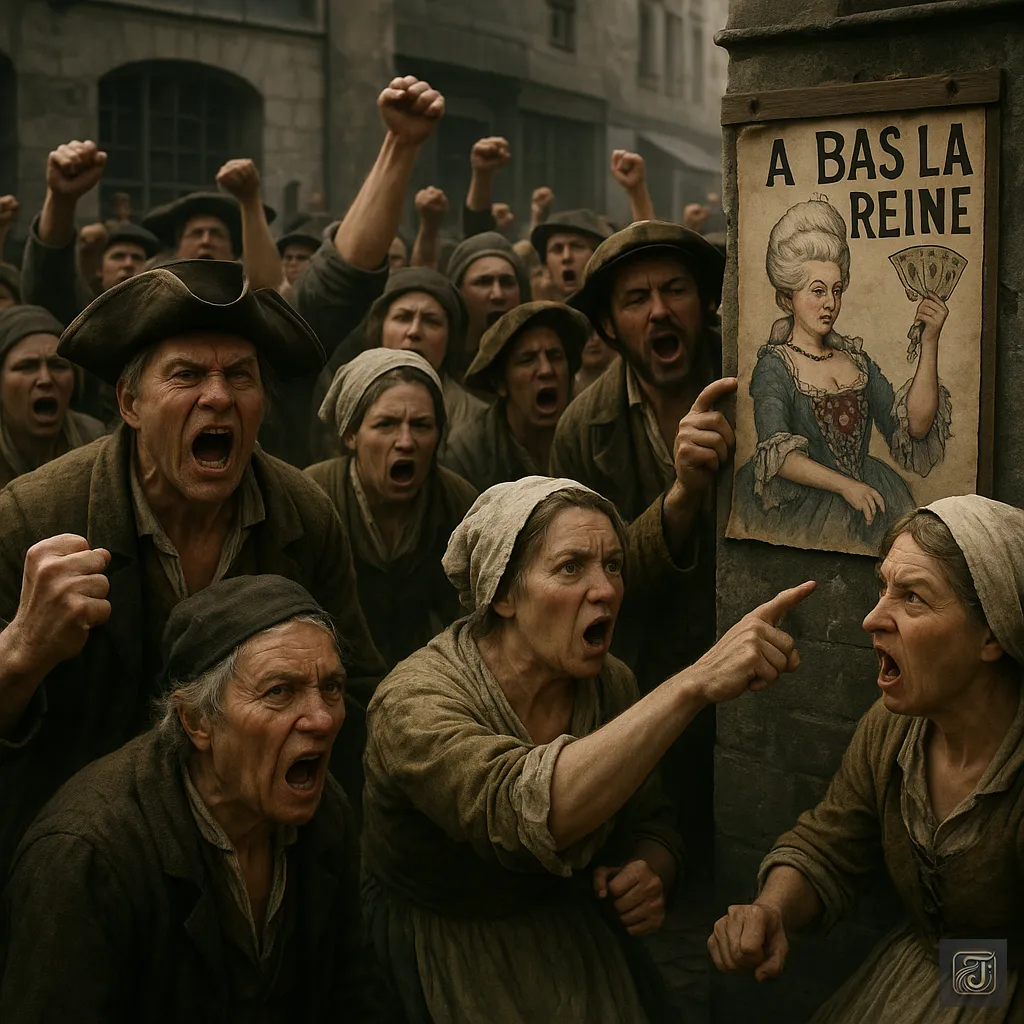
Citizens:
“The Queen has always lived in luxury—everyone knows it!”
“Hundreds of dresses, jewels, gambling… And now she claims she’s innocent?”
“Don’t make me laugh!!”
At this point, the facts no longer mattered.
No matter how much the Queen insisted on her innocence, her past extravagance had already poisoned the public’s perception.
Truth had become irrelevant.
The people chose to believe not what was true,
But what they wanted to be true.
In the squares, the taverns, the lines outside bakeries—
Every corner of Paris buzzed with rumor.

Citizens:
“She’s feeding her desires with our taxes again!!”
“Send her to the guillotine!!”
Outside the golden halls of Versailles,
The hatred toward the Queen ignited into an unstoppable blaze.
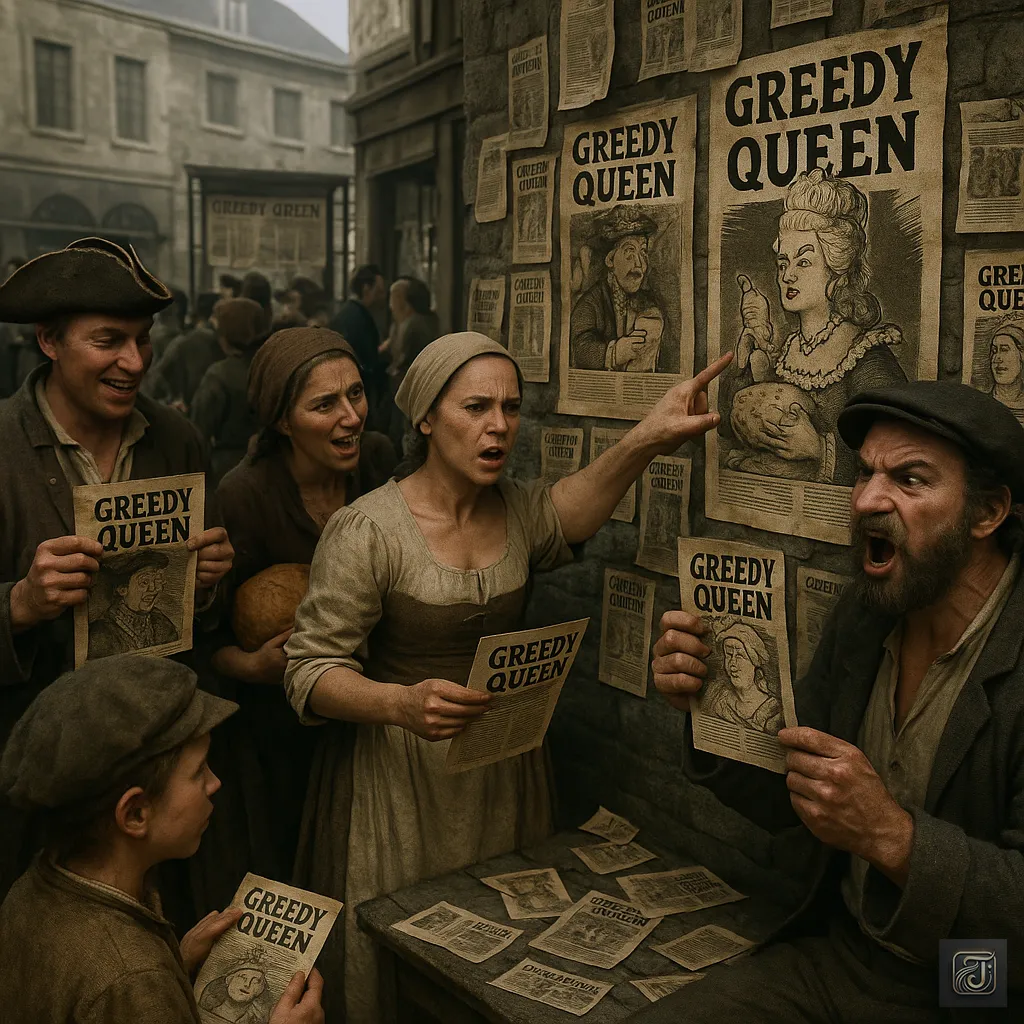
Satirical prints and pamphlets flooded the streets.
Marie Antoinette had become the notorious symbol of the “Greedy Queen.”
No matter how passionately she denied the accusations,
no one would listen anymore.
It was then that Marie Antoinette finally realized—
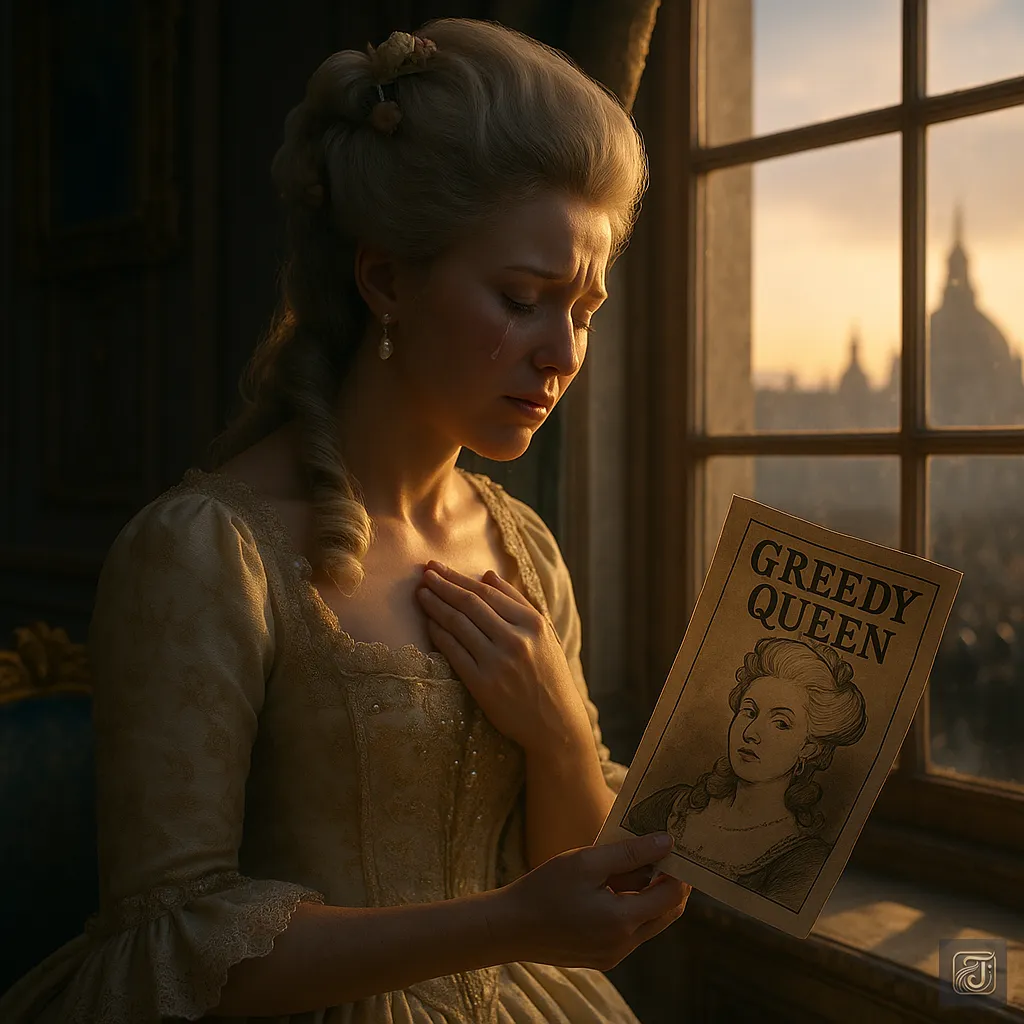
Marie Antoinette:
“I… am hated by the people…”
But it was already too late.
The Diamond Necklace Affair had burned the label “Greedy Queen” into her name — permanently and publicly.
And that anger—
would soon ignite into a fire called Revolution.
Chapter 9: The Eve of Revolution — The National Assembly and the Tennis Court Oath

1789 — Spring.
All across France, a heavy tension filled the air.
Crushing taxes.
Widespread poverty.
Hunger without end.
Cries of despair echoed through the streets, as riots and looting erupted in towns across the nation.

CItizens:
“No bread!!”
“It’s all the Queen’s fault!!”
“Down with the Greedy Queen!!”
After the Diamond Necklace Affair, Marie Antoinette had completely lost the trust of the people.
She had become nothing less than the embodiment of public hatred.
And yet—
Louis XVI still failed to grasp the true gravity of the situation.

Louis XVI:
“My royal authority is absolute.”
“The people will quiet down in time.”
But such an era was already over.
At last, the fury of the people erupted—
not in the streets, but in the political arena.
May 5, 1789.
The Estates-General (États Généraux) was convened.

What was the Estates-General?
The First Estate: the clergy
The Second Estate: the nobility
The Third Estate: the commoners
Each estate sent its representatives to discuss the future of the nation.
However—
This very system was already rotten to the core.

One vote per estate.
Naturally, when the First and Second Estates (who were exempt from taxes) joined forces,
The Third Estate (the tax-burdened commoners) would always lose.
And this time was no different.
The proposal for tax reform
was rejected by a 2-to-1 vote.
At that moment, the fury of the Third Estate erupted.

Citizens:
“Why do we only get one vote?!”
“The people make up the overwhelming majority!”
“This is unjust!!”
June 17th.
The Third Estate declared themselves the:
National Assembly.

Citizens:
“We shall no longer rely on the king.”
“We will draft our own constitution.”
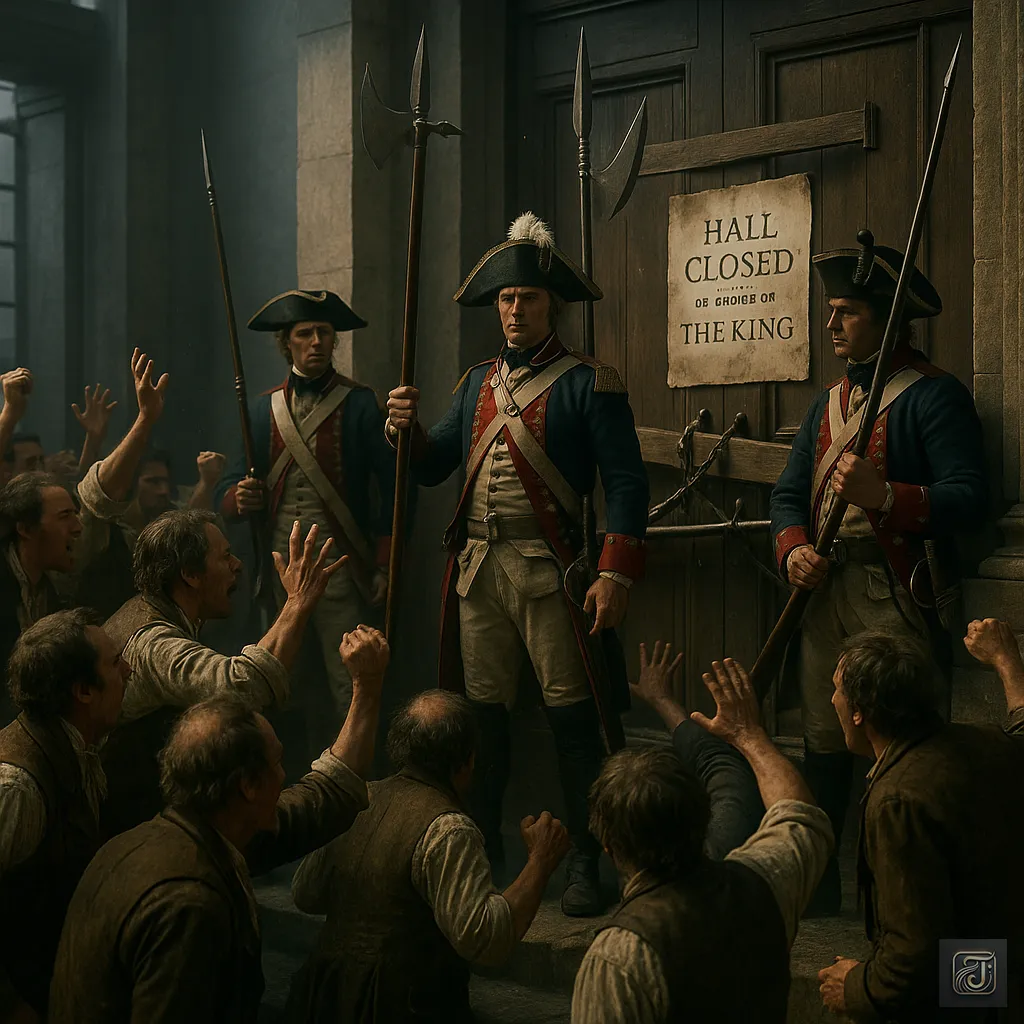
Alarmed by this defiance, Louis XVI ordered the National Assembly’s meeting hall to be sealed off.
But the Third Estate did not back down.
On June 20, they gathered in an indoor tennis court within the Palace of Versailles.
There, they made a vow that would change history—
The Tennis Court Oath.

Citizens:
“We shall never yield!”
“Until a new constitution is established, we shall not disband—no matter what pressure is brought upon us!”
Fists raised, their voices of defiance echoed off the palace walls.
On this day, for the first time, the king’s absolute power truly began to tremble.
But even then, Louis XVI remained obstinate.

Louis XVI:
“If they oppose us, we’ll send in the army!”
“The revolution will never be allowed! We’ll crush them by force!”
This statement only added fuel to the fire.

Citizens:
“The king intends to massacre us! Then we must arm ourselves! Force must be met with force!”
July 14, 1789.
The Storming of the Bastille.

The citizens of Paris swarmed the Bastille prison.
It was also a storehouse of weapons and gunpowder.
They broke down the gates, overpowered the guards—
And finally, the Bastille fell.
It was a symbolic victory of the Revolution.
The people had taken up arms.

CItizens:
“The time has come to face the king’s army!”
“We fight—for our freedom!!”
Upon hearing the news, Versailles was thrown into near-collapse.
Panic swept through the royal court.
Nobles fled abroad one after another.
The palace corridors were left nearly empty.

Marie Antoinette:
“What will become of us…?”
Queen Marie Antoinette whispered, her face pale with fear.
But by then,
No one could stop what was coming.
Chapter 10: Escape from Versailles! — The People’s March of October 6

October 5, 1789 — Paris.
Citizens:
“Give us bread!!”
“Bring out the Queen!!”
Enraged citizens of Paris—especially the women—
Finally took up arms and began marching toward Versailles.
Their number: around 7,000.
Pots, knives, guns, clubs—
They carried whatever they could get their hands on.

CItizens:
“Our children are starving, while that ‘Greedy Queen’ lives in luxury!!”
In the pouring rain,
The furious mob marched through muddy roads,
shouting in rage as they headed for the Palace of Versailles.
That night—
A message of emergency reached Versailles.
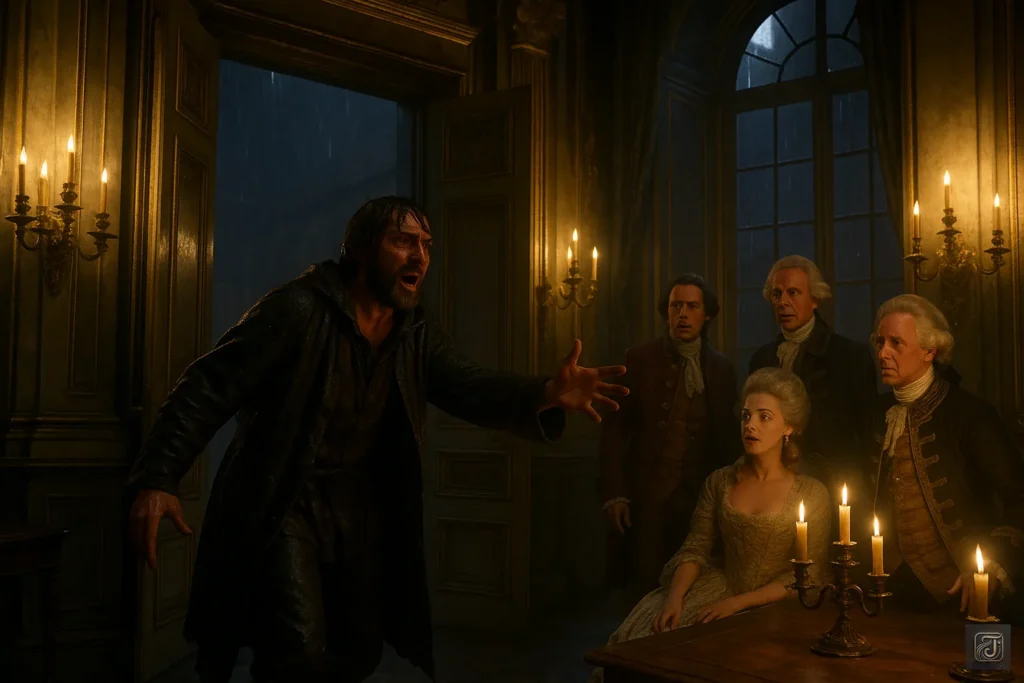
Citizens:
“The citizens of Paris are almost at the palace!!”
“Your Majesty!”
“Your Highness!”
“You must flee at once!!”
A messenger burst into the Queen’s chambers.
Marie Antoinette turned pale and trembled.

Marie Antoinette:
“Where are we supposed to go!?”
At that moment, outside the palace—
The enraged mob was breaking through the gates.
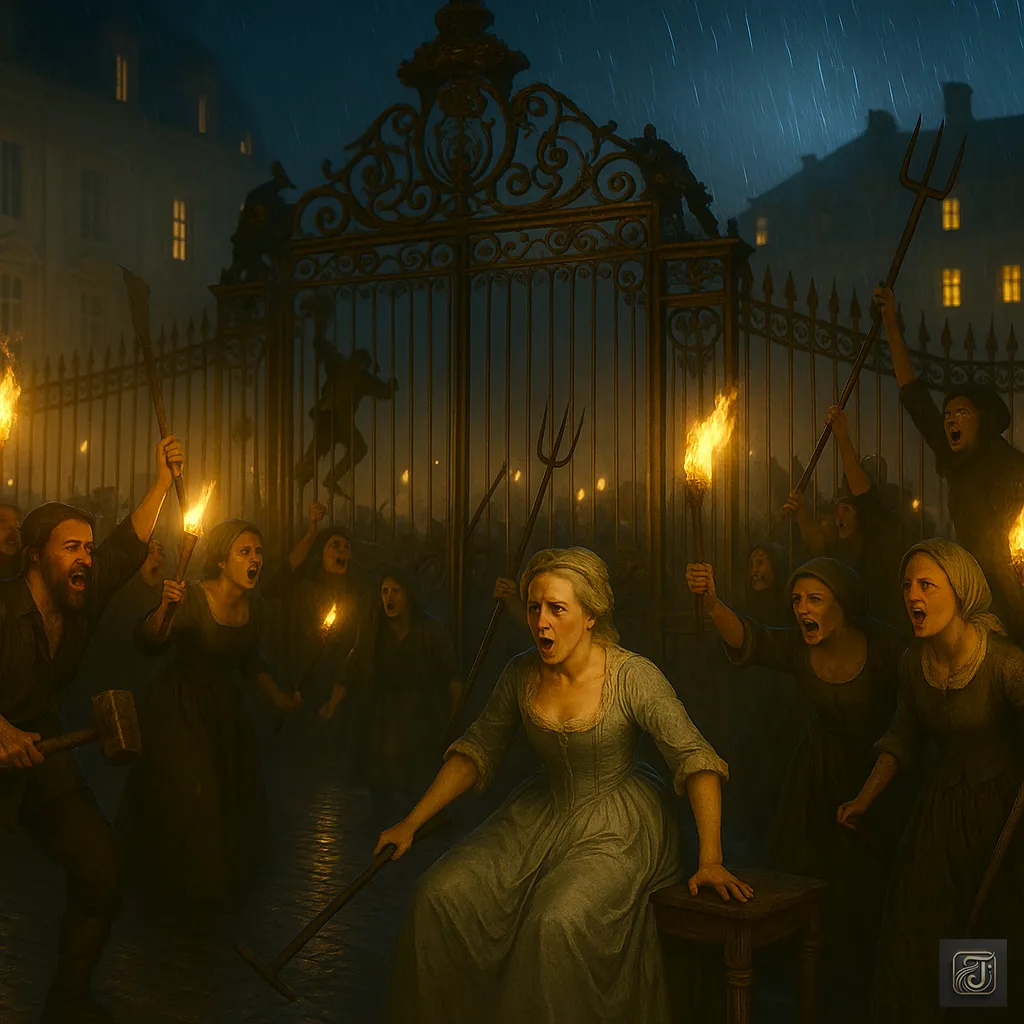
Citizens:
“Drag out the Queen!!”
“Send her to the guillotine!!”
The palace echoed with angry shouts and the screeching of iron doors.
The guards fought desperately to buy time.
In that moment,
The Queen slipped out of her bedroom through a hidden back door.

Servant:
“Hurry!! They’ll kill you if you stay here!!”
Marie Antoinette, barefoot and clutching her gown,
ran frantically down the dark corridor.
Even a moment’s pause could mean being torn apart by the mob.
Behind her, angry voices roared:
“Find the Queen!!”
Her heart felt like it would leap out of her throat.
By the time she finally reached Louis XVI,
her face was pale as death.
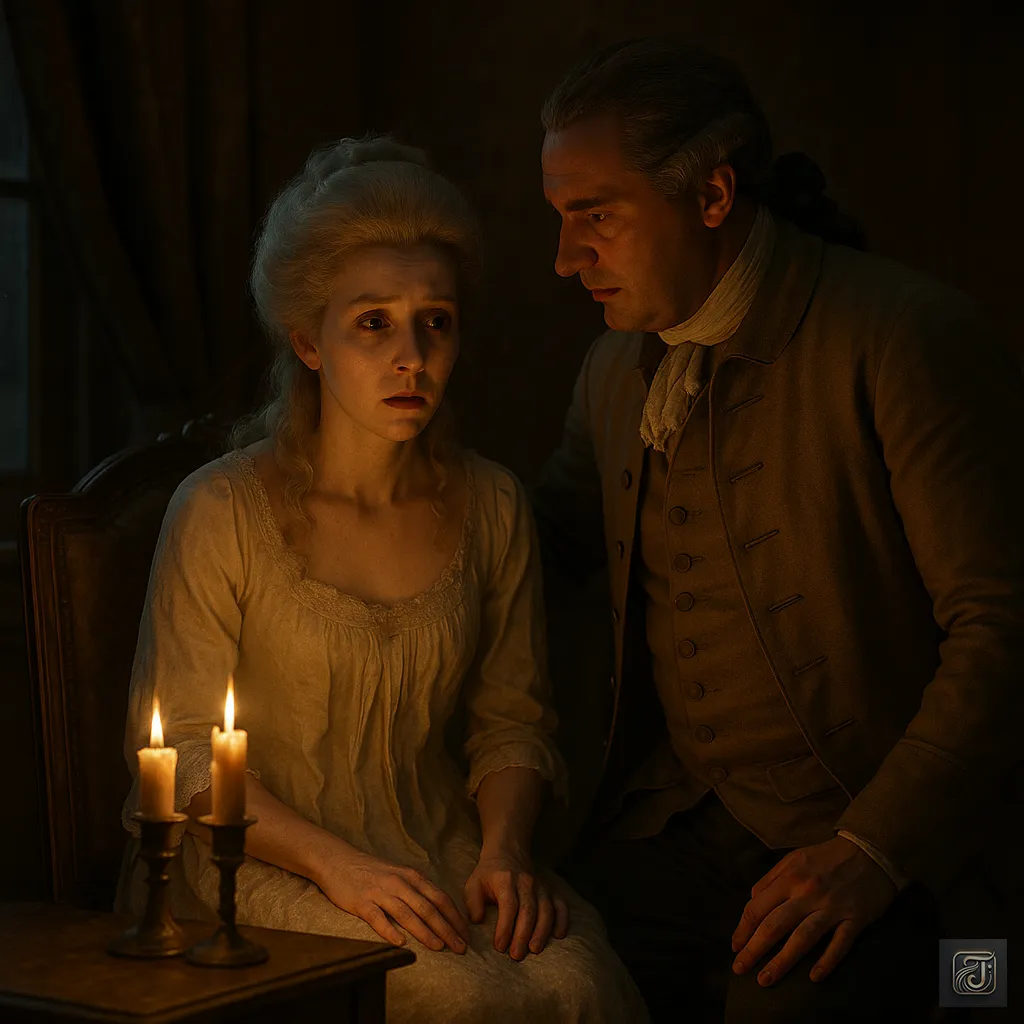
Marie Antoinette:
“What are we to do…?”
“There’s nowhere left for us to run…”
Yet for now, the worst had been avoided.
The royal family, bowing to the demands of the people,
made the decision to move to Paris.
October 6th, at dawn—
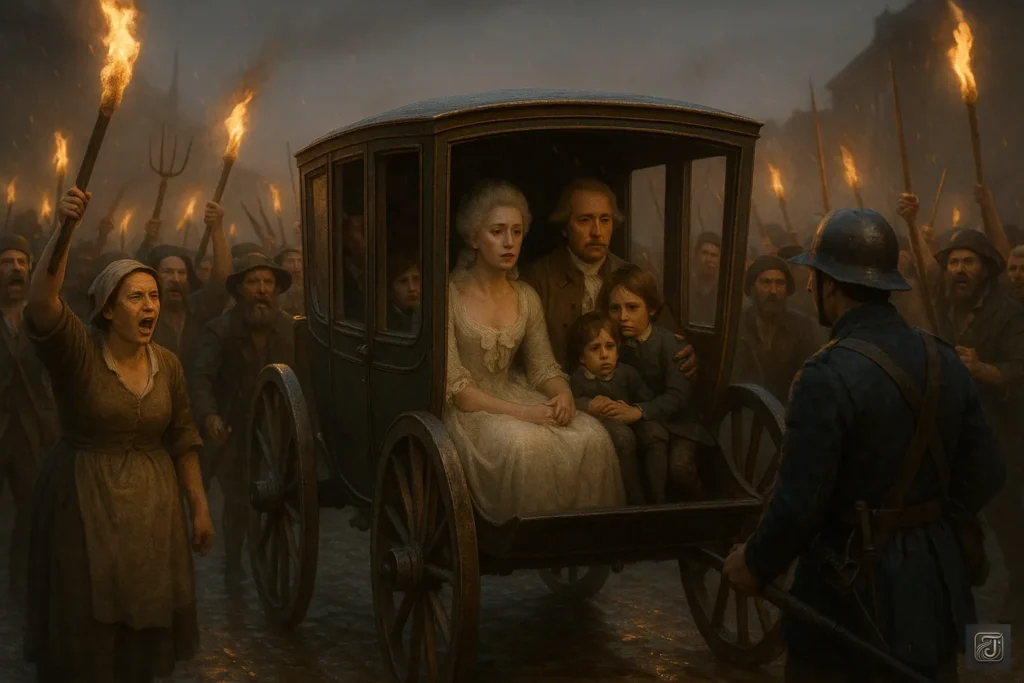
Citizens:
“The royal family—off to Paris!!”
Amid the triumphant cries of the people,
the royal family was loaded into a carriage.
Their destination—
The Tuileries Palace is in the heart of Paris.
But this was no royal residence.
It was a prison in all but name.
The king and queen were no longer sovereigns.
They had become hostages—
delivered into the hands of a revolution.
Inside the carriage,
the queen wept silently.

Marie Antoinette:
“I have… at last… fallen into the hands of *those* people…”
Yet—
This was still
only the prologue to her downfall.
Chapter 11: The Desperate Escape — The Flight to Varennes
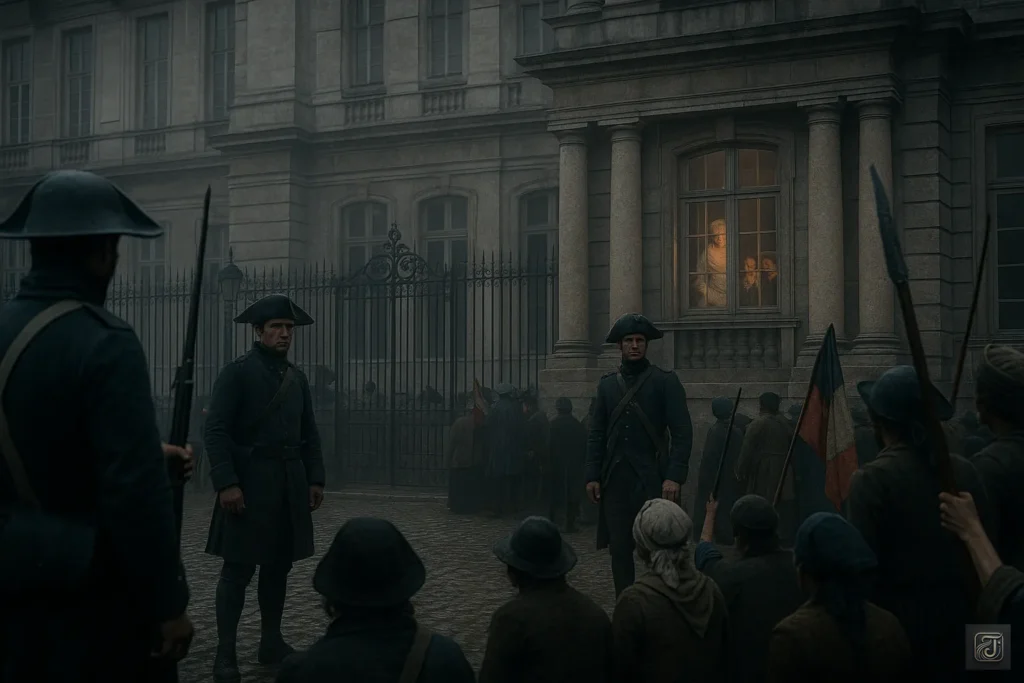
1791
Tuileries Palace.
It had become the guarded residence of the royal family under house arrest.
Their outings were restricted,
and the palace was surrounded by revolutionaries and soldiers.
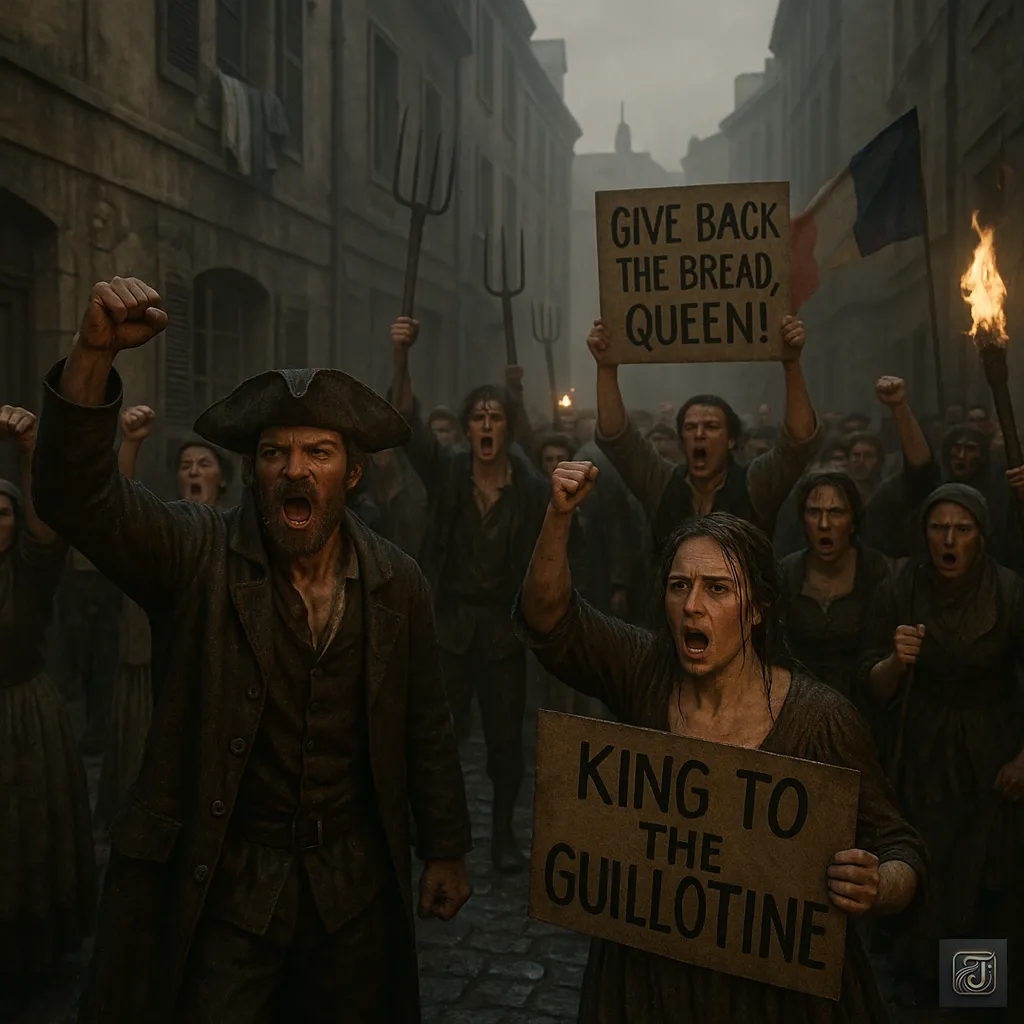
Citizens:
“Queen! Give back our bread!”
“Send the King to the guillotine!”
Day after day,
The streets of Paris echoed with shouts and jeers directed at the royal family.
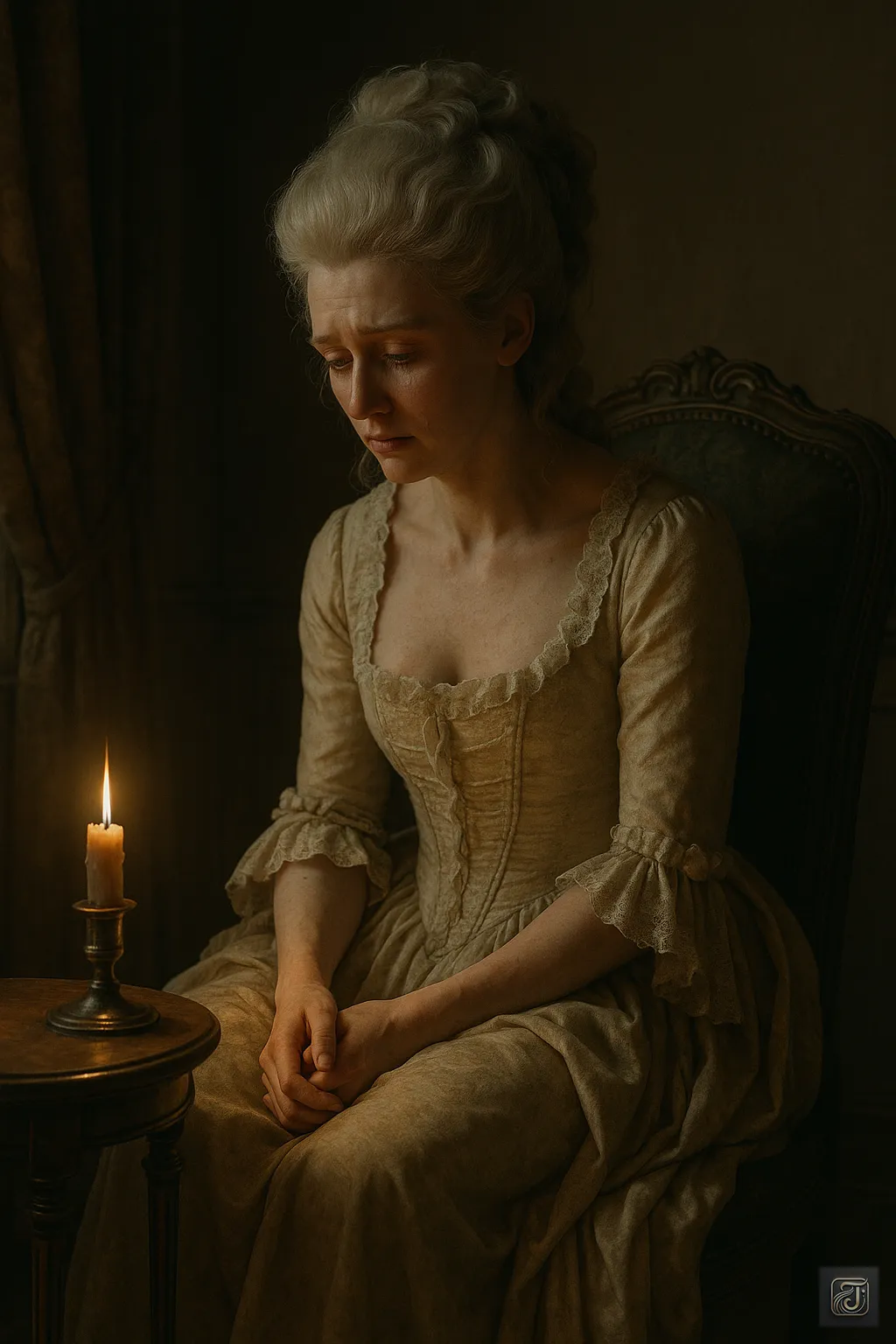
Marie Antoinette:
“…We are no longer free…”
Marie Antoinette was nearly crushed beneath the weight of despair.
Around the same time, a fear swirled in Louis XVI’s heart as well:
“At this rate, the royal family is doomed.”
And yet, at the same time—

Louis XVI:
“Would fleeing not mean abandoning the dignity of the King of France…?”
Pride and fear clashed within him.
Each day, he wavered between fleeing as a man and remaining as a king.
But then—
A glimmer of hope appeared.
Hans Axel von Fersen.
He secretly came to visit the Queen.
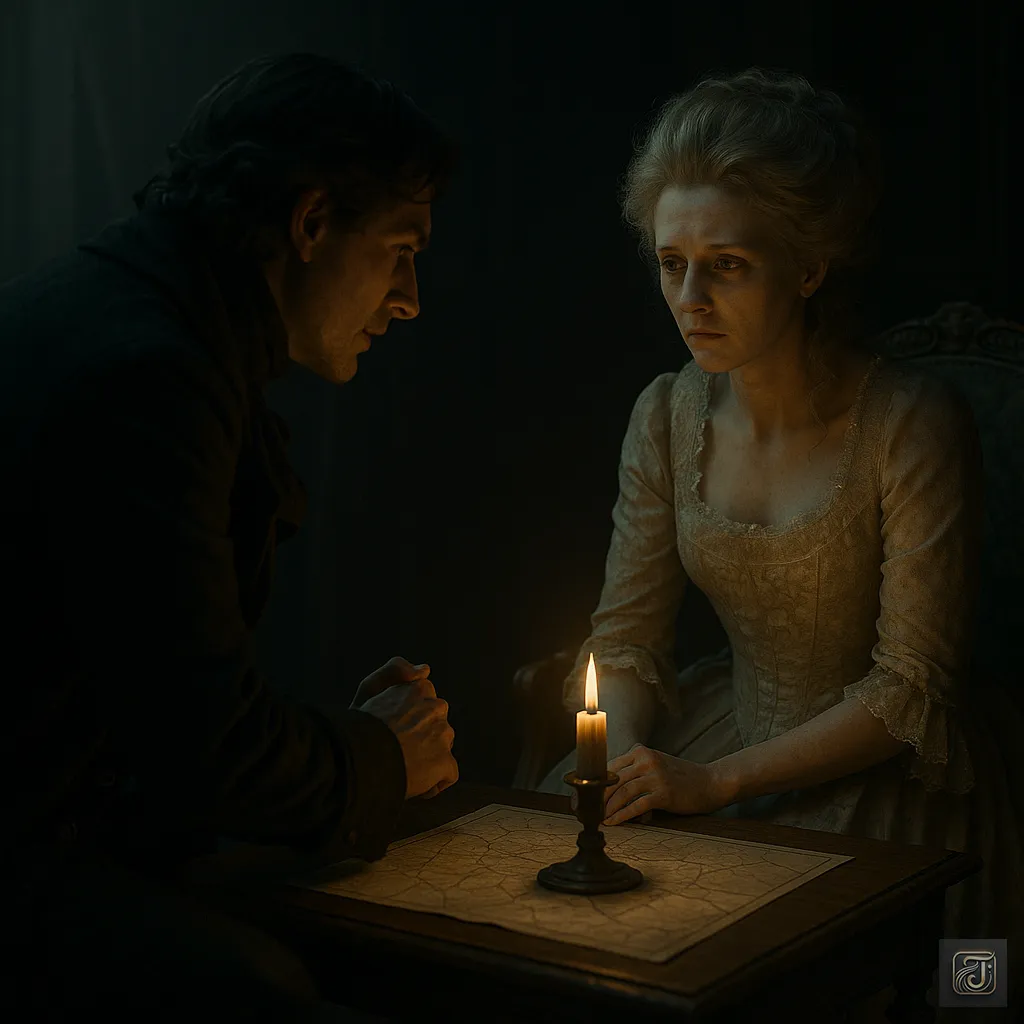
Fersen:
“There’s still time.”
“I’ve prepared an escape plan—”
“If you can reach Varennes near the border, the Austrian army will protect you!”
Fersen’s plan was careful and meticulous:
✅ A discreet, lightweight carriage
✅ A swift and direct route
✅ Simple disguises for mobility
But then—
The Queen’s pride became an obstacle.
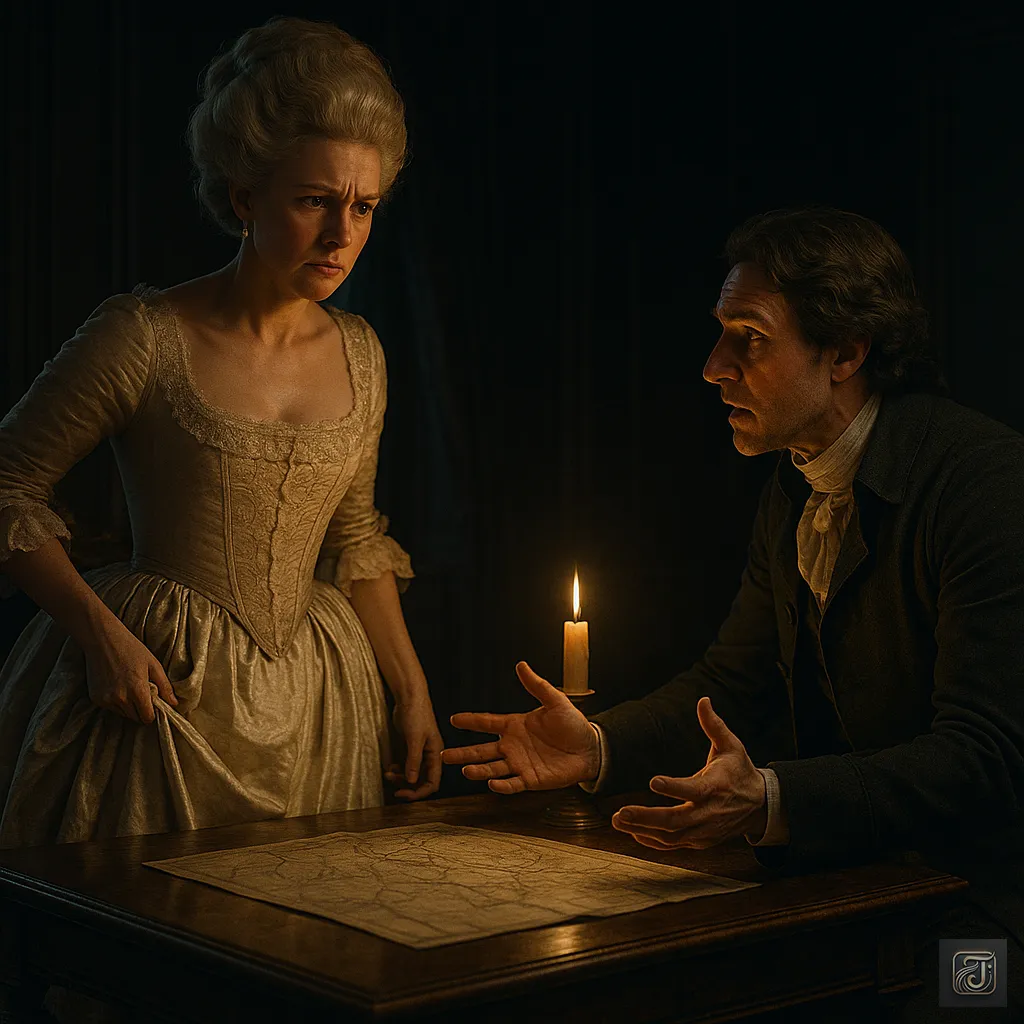
Marie Antoinette:
“I can’t possibly fit all my dresses in such a small carriage.”
“And my dignity as a queen—”
Fersen tried to reason with her.
Fersen:
“Your Majesty, survival must come first!”
“Dresses are the least of our concerns right now!”
But Marie Antoinette wouldn’t listen.
And then—
Even Louis XVI added his voice:

Louis XVI:
“As king, I must not appear undignified in flight.”
In the end, he could not cast aside his pride as a monarch.
And so—
A large, extravagant, and conspicuous carriage was prepared.

Fersen:
“…This will attract far too much attention.”
Fersen felt a deep sense of foreboding stir within him.
And to make matters worse—
The departure was delayed by an entire month in order to prepare the new carriage.
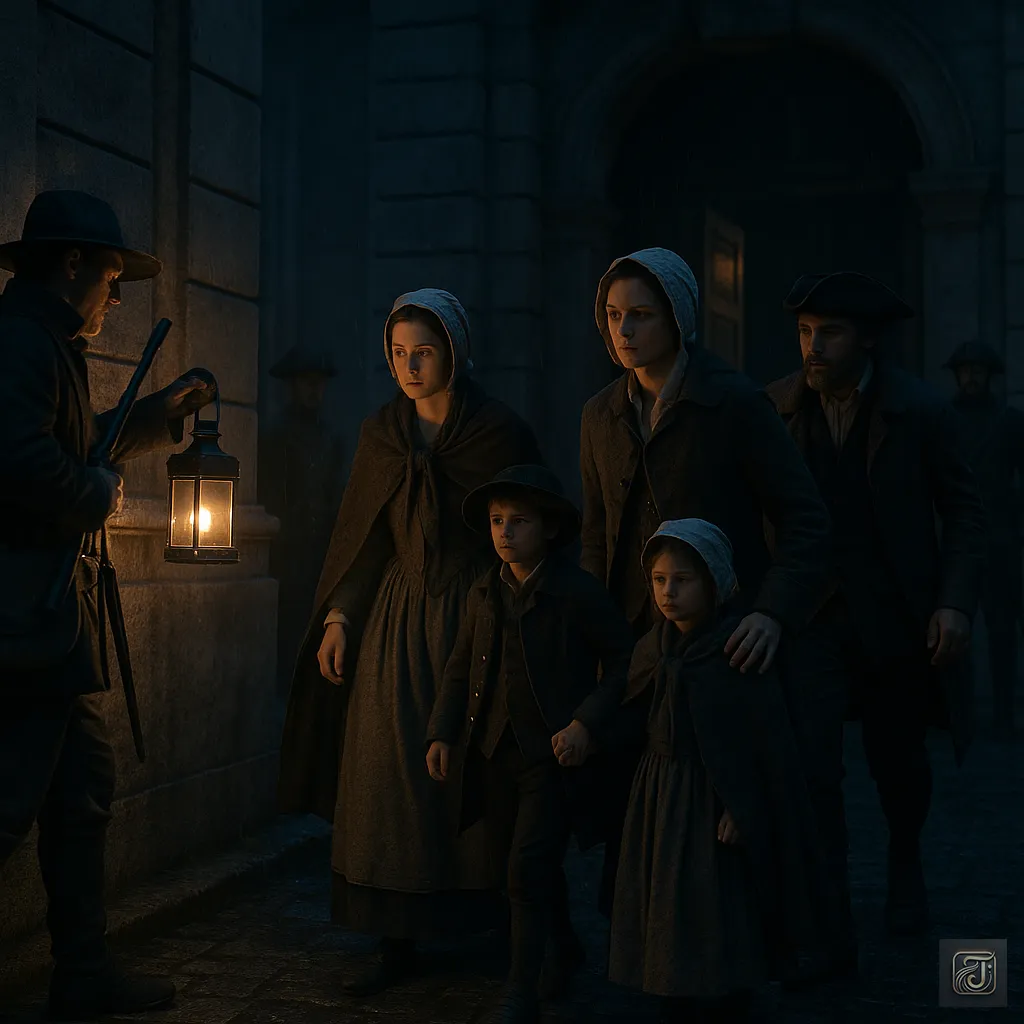
June 20th, nightfall.
At last, the royal family, disguised, slipped out of the Tuileries Palace.
But—
Problems emerged almost immediately.
The enormous carriage was slow and frequently got stuck along the way.
Revolutionary citizens began casting suspicious glances their way.
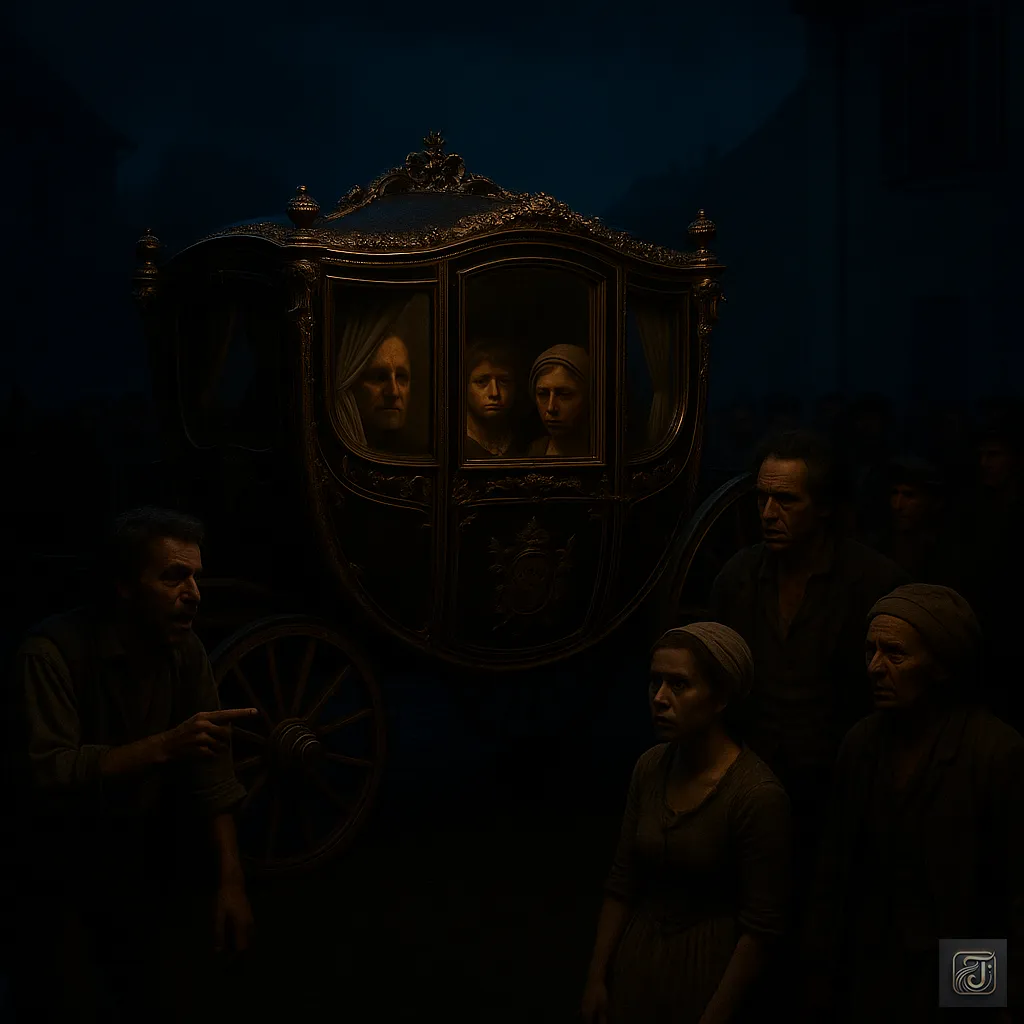
Citizens:
“What’s with that luxurious carriage?”
Furthermore—

Postmaster:
“Isn’t that the royal family!?”
In a small town along the way, a postmaster noticed.
Revolutionary pursuers were dispatched immediately.
At last—
Just before reaching Varennes, the royal family was captured.
In that moment,
Marie Antoinette deeply regretted ignoring Fersen’s advice.
But it was already too late.
On June 25, the royal family was forcibly returned to Paris.
The roadsides were lined with countless citizens.
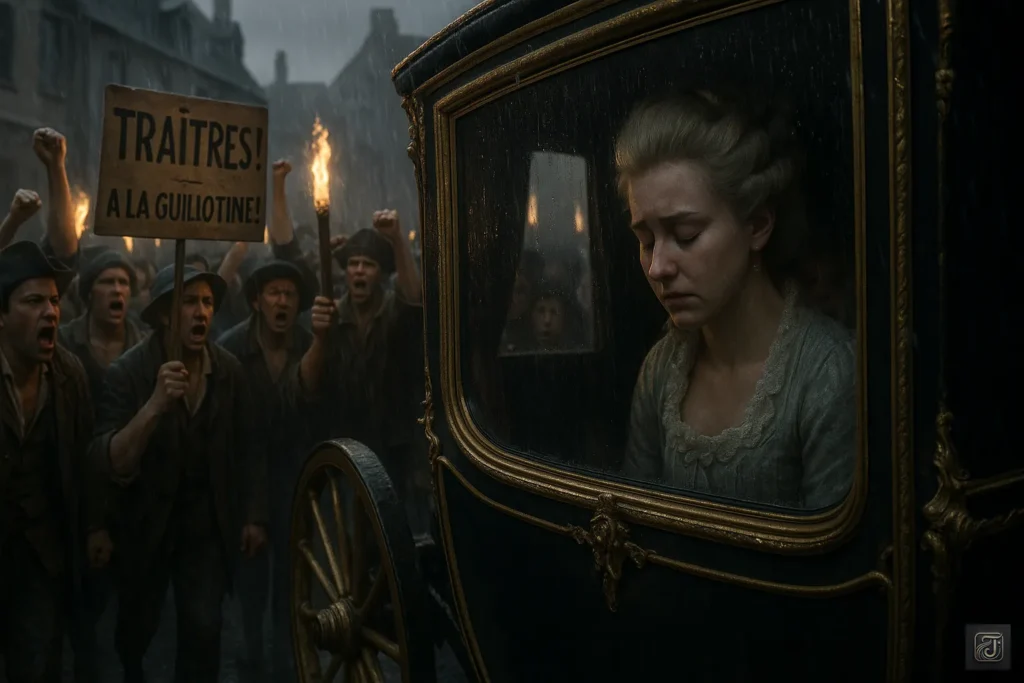
Citizens:
“Traitors!!”
“To the guillotine!!”
Amid the furious shouts,
The queen lowered her head,
fighting back tears.

Marie Antoinette:
“Our trust… is completely gone now—”
The Flight to Varennes.
It dealt a fatal blow to the royal family.
“The king tried to abandon his people and flee.”
When that truth spread throughout the country,
the fall of the monarchy was no longer a question of if, but when.
Chapter 12: The End — The Abolition of the Monarchy and the Guillotine
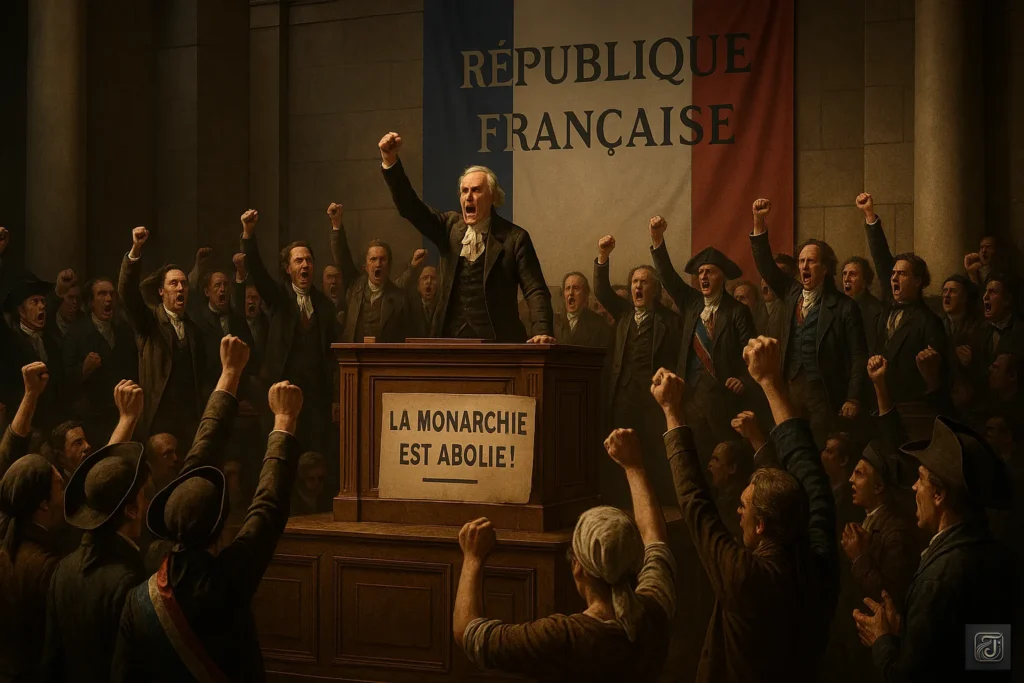
September 21, 1792
At last—
The French monarchy was abolished.
The National Convention
declared France a “Republic.”
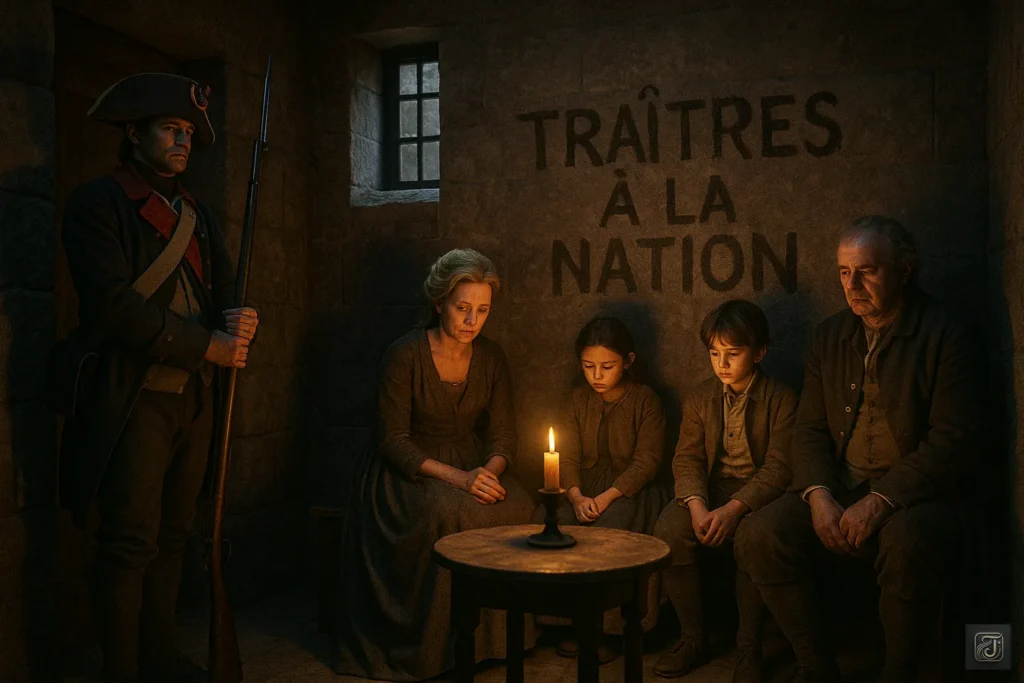
The royal family was no longer the king or queen.
Far from it—
They were now labeled as “enemies of the state” and “traitors.”
and imprisoned.
Louis XVI was put on trial.
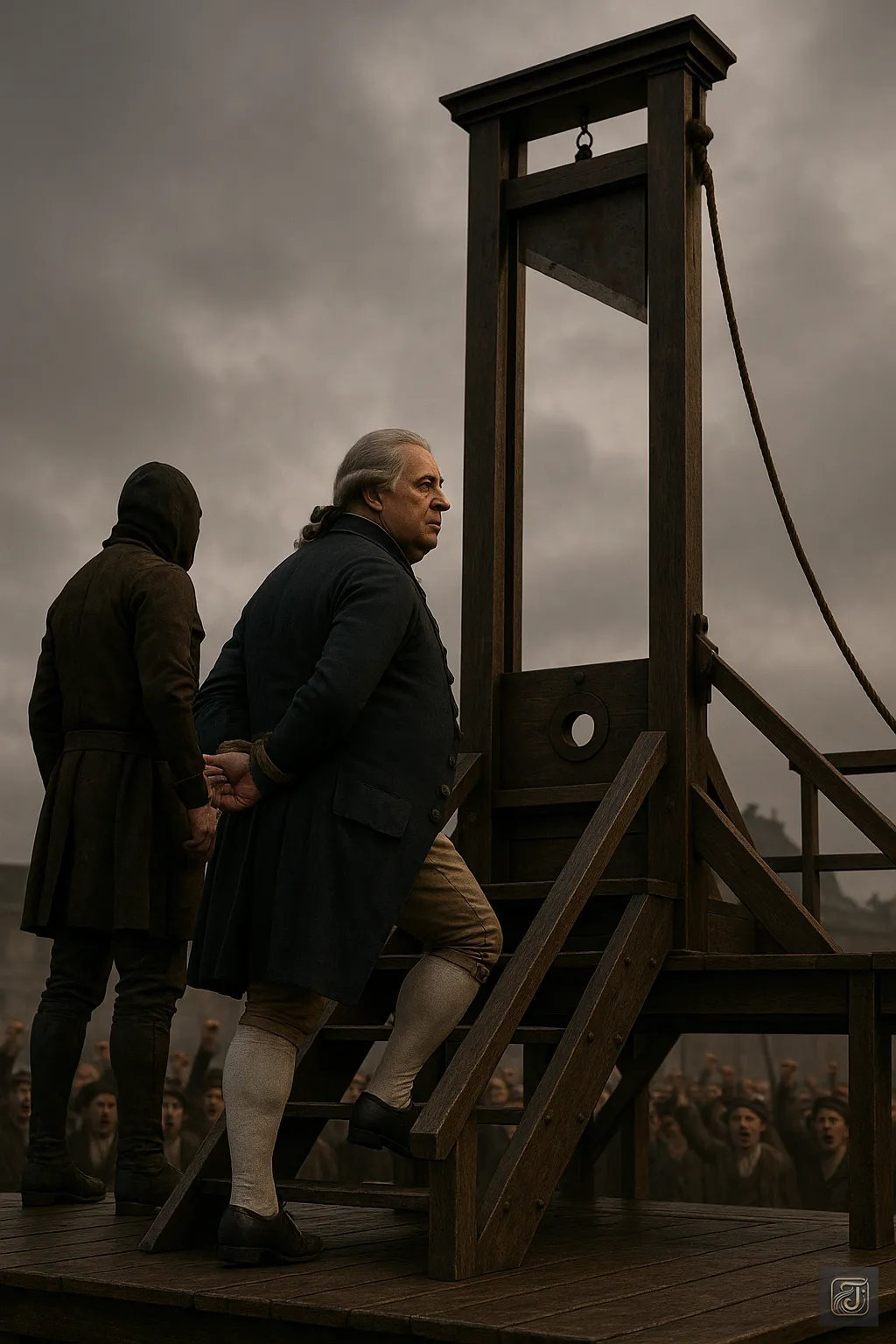
January 21, 1793.
Louis Capet (formerly King Louis XVI)
ascended the scaffold.
The decision: 361 votes for execution, 360 against — a margin of just one vote.
Marie Antoinette learned of the king’s final moments
from a dark corner of her prison cell.
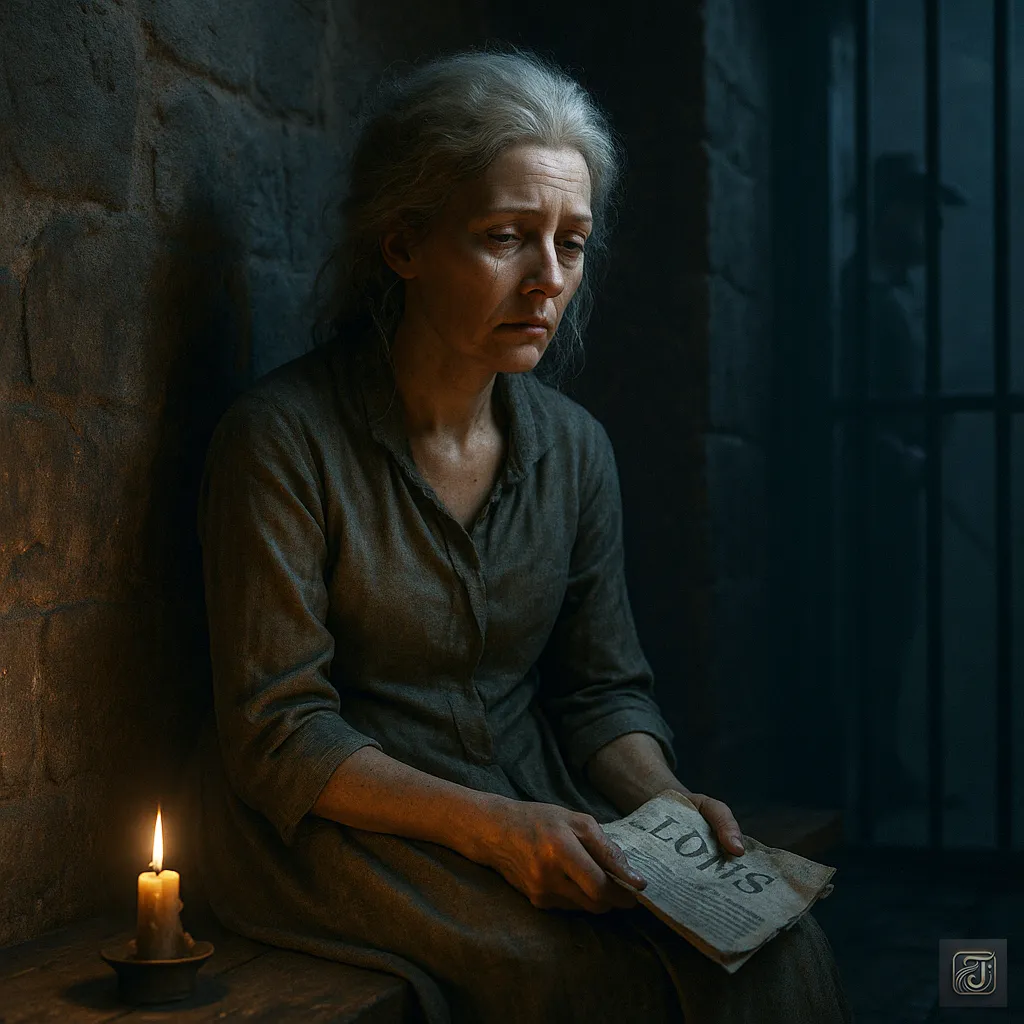
Marie Antoinette:
“Louis…”
Her heart was so worn
that even her tears had dried up.
And deep down—
She knew all too well:
She would be next.
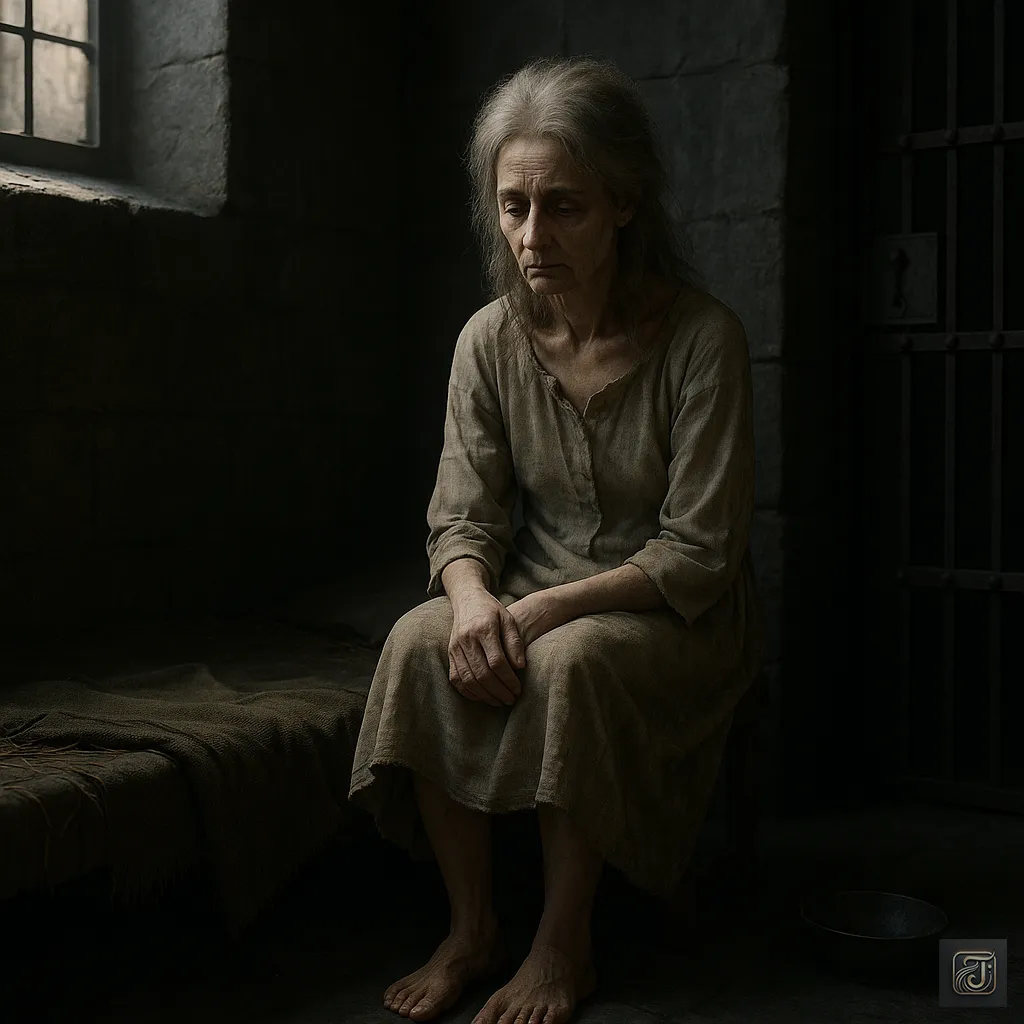
Conciergerie Prison.
Marie Antoinette was thrown into a narrow, dim cell.
No friends.
No servants.
The once-glorious queen now stood as a withered prisoner.
Her hair streaked with white,
her cheeks sunken,
clothed in nothing more than a single coarse garment.
And yet—
She never let go of her final dignity.
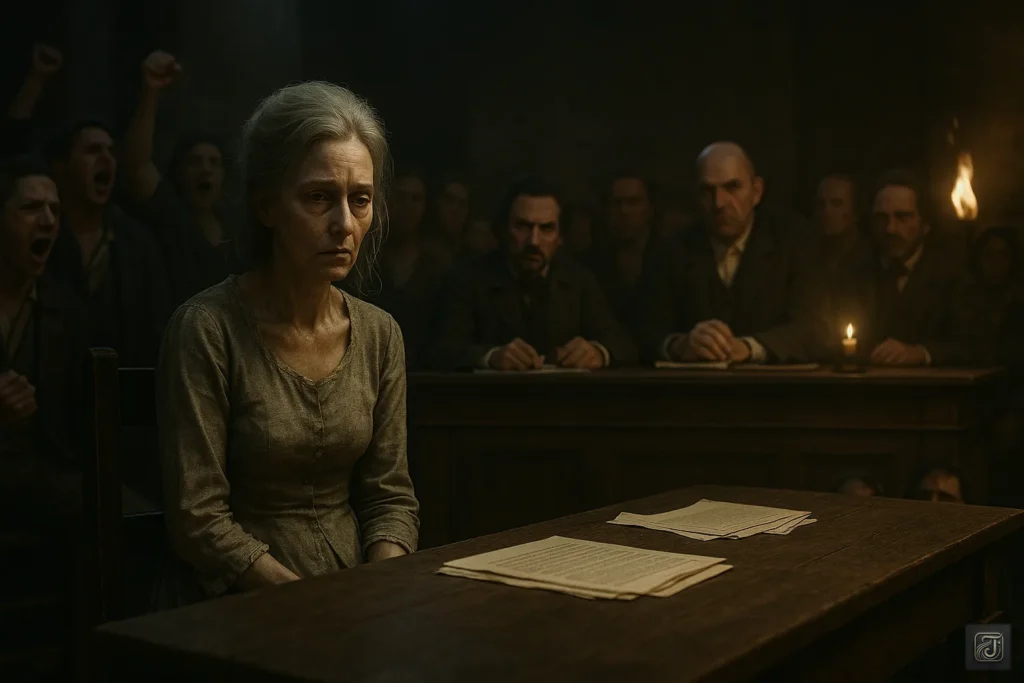
October 14, 1793.
The trial began.
From the very start, the Revolutionary Tribunal had only one goal: a guilty verdict.
No real evidence was presented—
only a barrage of insults and slander.
Yet Marie Antoinette responded with unwavering composure.

Marie Antoinette:
“I have done nothing more than fulfill my duty as Queen of France.”
Nevertheless, the verdict was:
“Death.”
October 16th, early morning.

A prison guard whispered to her:
“Your Majesty… the scaffold is ready.”
Marie Antoinette rose quietly to her feet.
Dressed in a white mourning gown, she took one step at a time—walking the path of no return.
On the way to the Place de la Révolution, riding in a simple cart—

Citizens:
“Die, you greedy woman!”
“This is justice! Feel the pain of all who starved to death because of you!!”
The crowd’s screams and curses surrounded the cart.
Yet, the queen’s eyes—
remained calm and silent.

Marie Antoinette:
“I’m… no longer afraid.”
With steady steps, she ascended the stairs to the guillotine.
By chance, she stepped on the executioner’s foot—
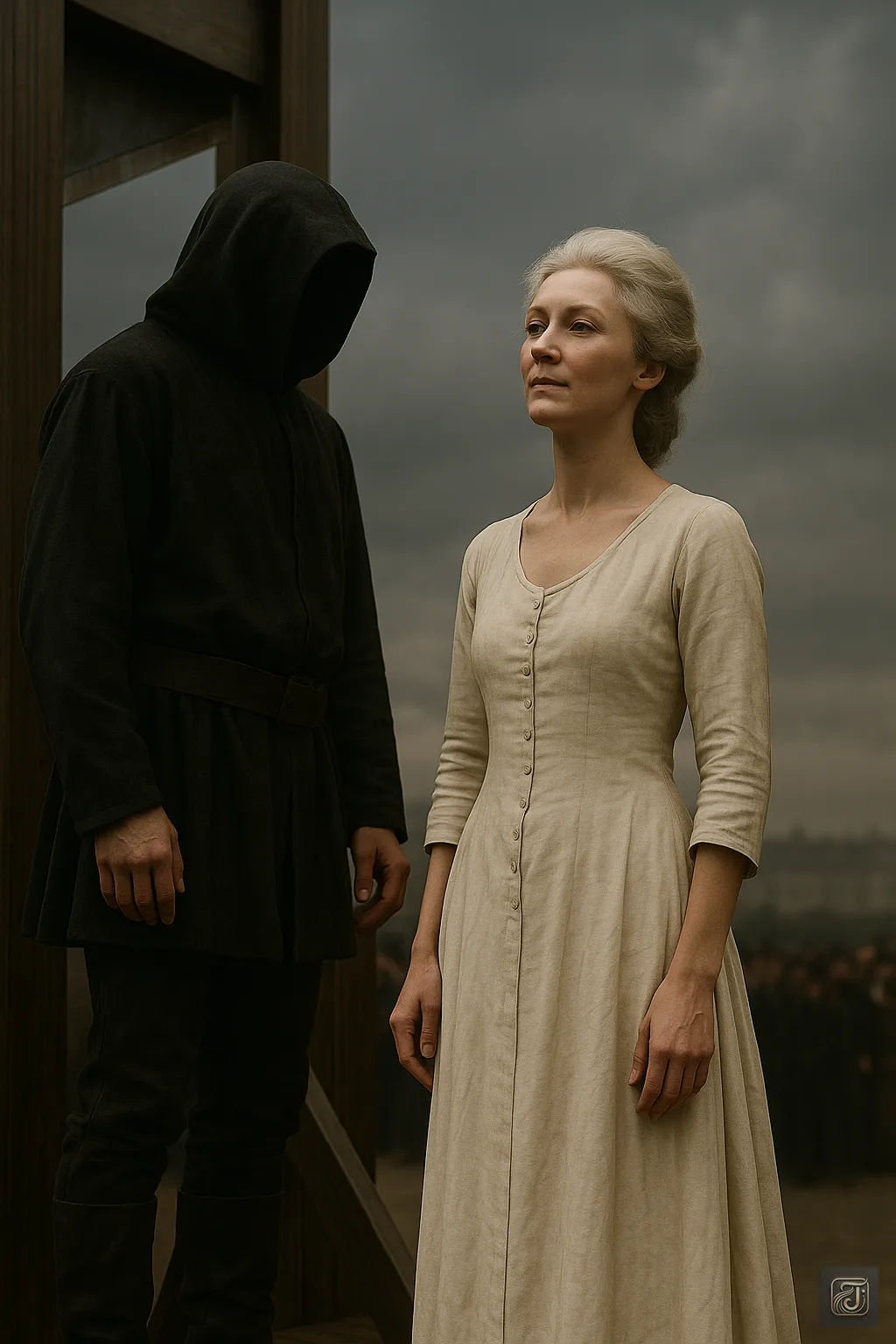
And with dignity, uttered her final words:
“Pardon me, sir.”
“I did not mean to.”

The blade fell, and the queen’s life came to an end.
She was 37 years old.
The crowd erupted in cheers.
But only a few years later—
The French Revolution would drown itself in blood, spiraling into an era of the Reign of Terror.
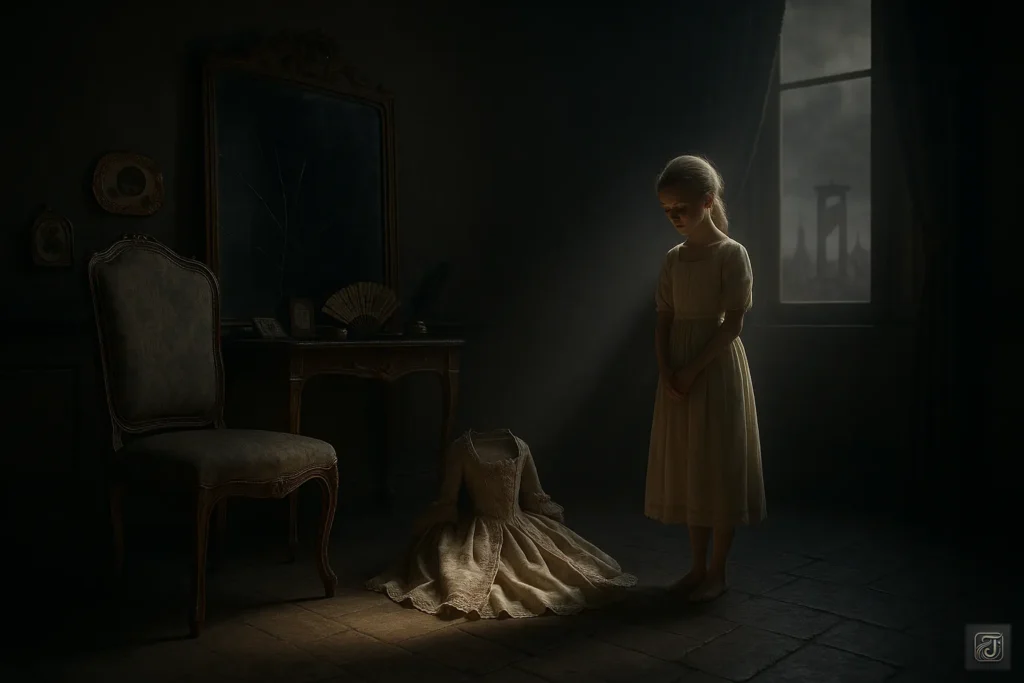
Marie Antoinette:
“Why was I hated so deeply?”
What might have gone through the mind of the young girl who had once arrived in France at the age of fourteen?
That answer now lies buried within the folds of history—
Final Chapter: Why Did People Hate This Queen?
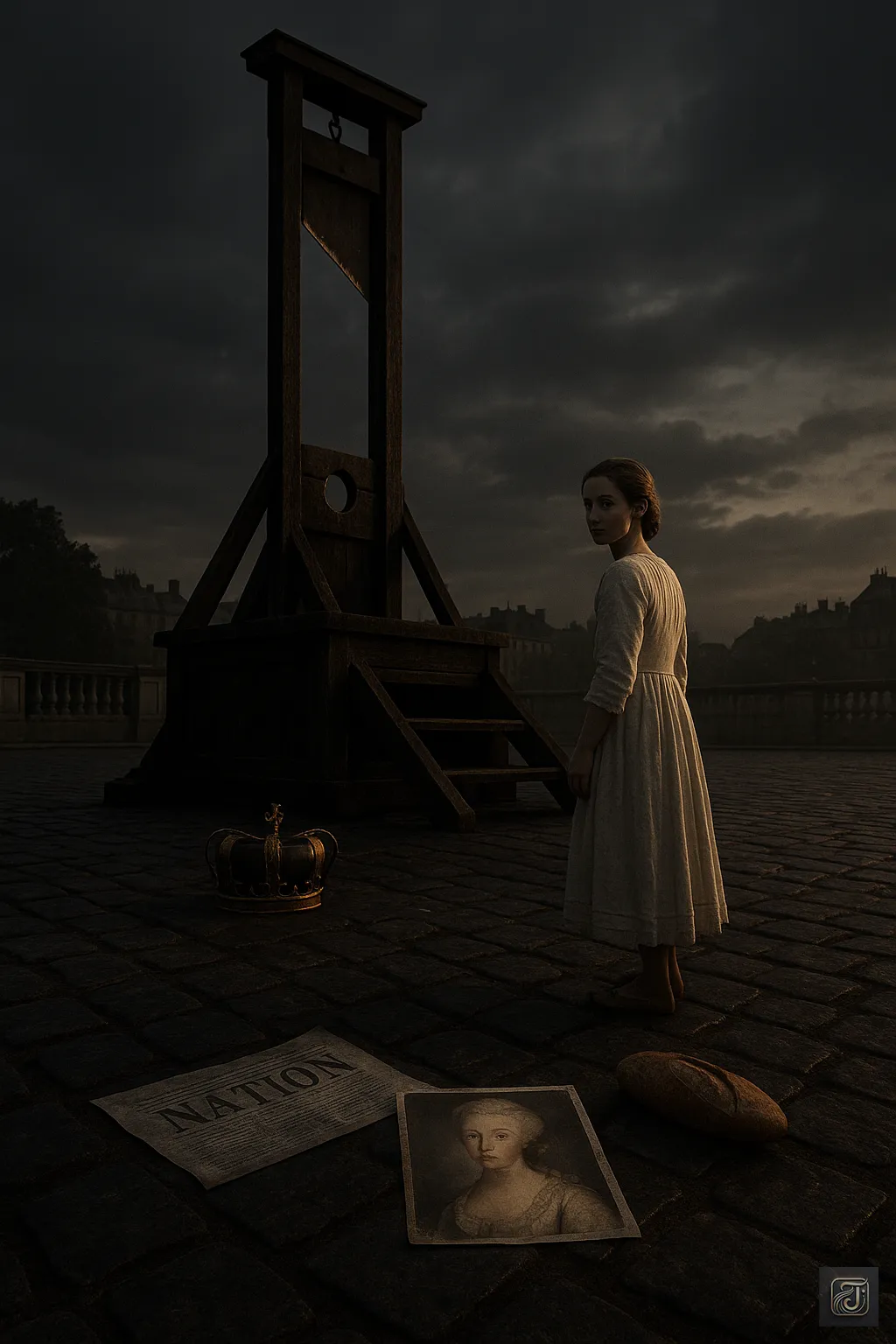
Why did the French people hate Marie Antoinette so deeply?
As a matter of fact—
She was executed.
But was she truly guilty of a crime so grave that it deserved the guillotine?
Her extravagant life at Versailles,
her lavish spending at the Petit Trianon,
her masked balls and costly games—yes, these were real.
Yet, she was not the only one indulging in luxury.
The Diamond Necklace Affair?
A complete miscarriage of justice.
And the Flight to Varennes—
It was not an act of betrayal against the country,
but rather a desperate escape to protect her family’s lives.
Even so, the people never forgave her.
And the reason was simple:

A symbol—
She became the symbol of the Ancien Régime.
Marie Antoinette, the woman herself—She
was never truly a villain or a heartless queen.
She was merely a young girl,
sent to France at a tender age,
bound in a loveless marriage,
wandering through loneliness in search of “freedom.”
And yet—
It is also true
that she unknowingly accumulated
countless impressions of arrogance and excess.

✅ Lavish dresses and jewelry
✅ A life of elegance, blind to the people’s suffering
✅ Habitual extravagance and gambling
✅ Elitism and favoritism toward the nobility
All of this—
to the starving people—
looked like evidence of an enemy.
“She never tried to understand the suffering of the people.”
That became her greatest “crime.”
And beyond that—the spirit of the age.
The French Revolution was not driven by “reason”—
But by a tidal wave of emotion.
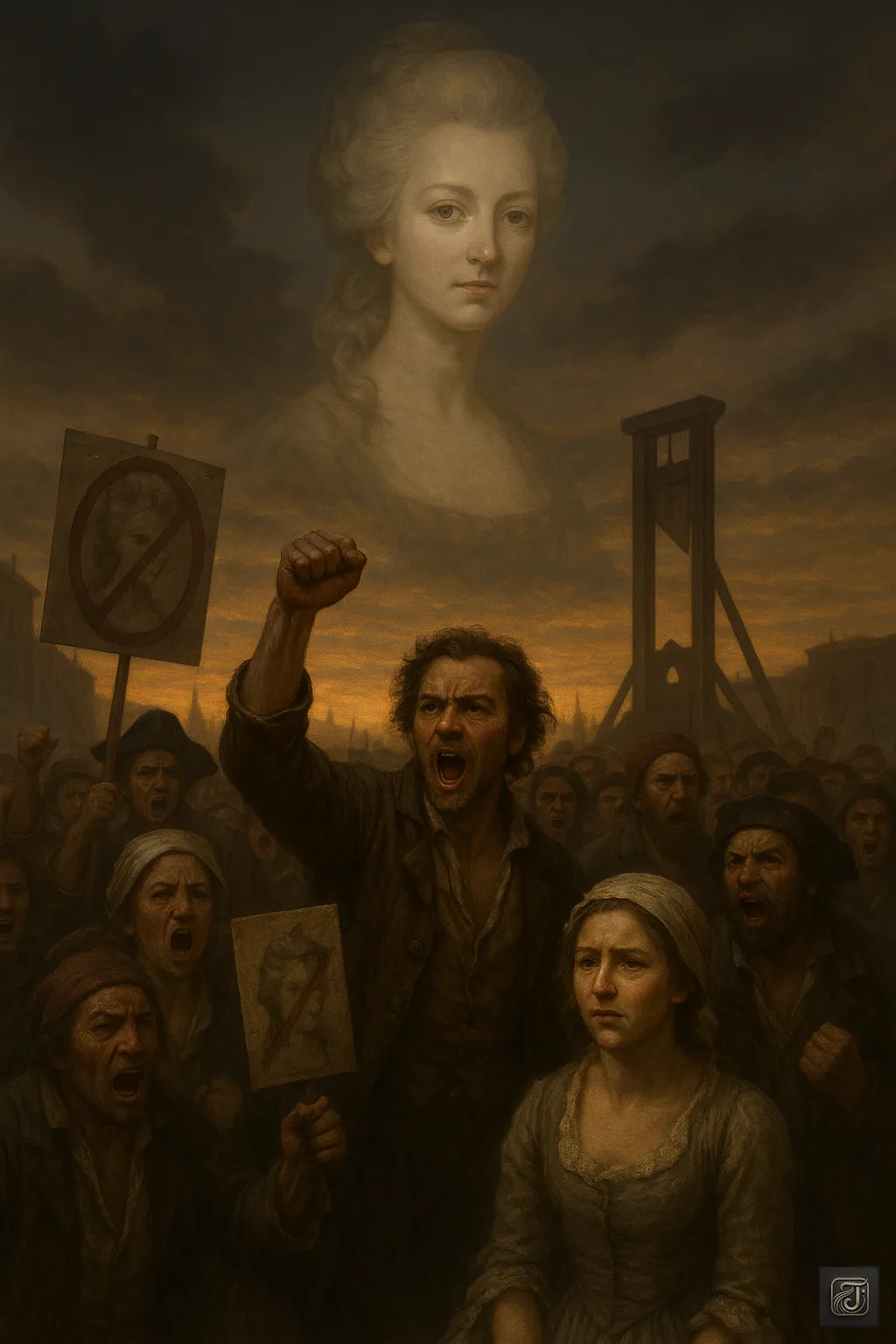
The people:
“needed someone to unleash their anger upon.”
In the later stages of the Revolution, the public desperately sought an outlet for their frustration.
Louis XVI, timid and unremarkable, faded into the background.
Instead, their fury turned toward Marie Antoinette—
a “foreigner,” and a “lavish” queen.
She was cast as the embodiment of noble corruption,
symbolized by the infamous words
“Let them eat cake.”
—words she never actually said.
As a “scapegoat,”
No one represented the decadence of the old regime more than Marie Antoinette.
—But was that truly justice?
In that final moment, climbing the steps to the guillotine,
Perhaps she thought to herself:
“Was I really so monstrous?”

Marie Antoinette:
“Where did I go wrong…?”
It was not just her own choices—
But the trap of fate laid by the era itself.
And now, as we look back on this tragedy,
Perhaps we must ask ourselves:
Would we, too, have judged her the same—without ever truly knowing her?
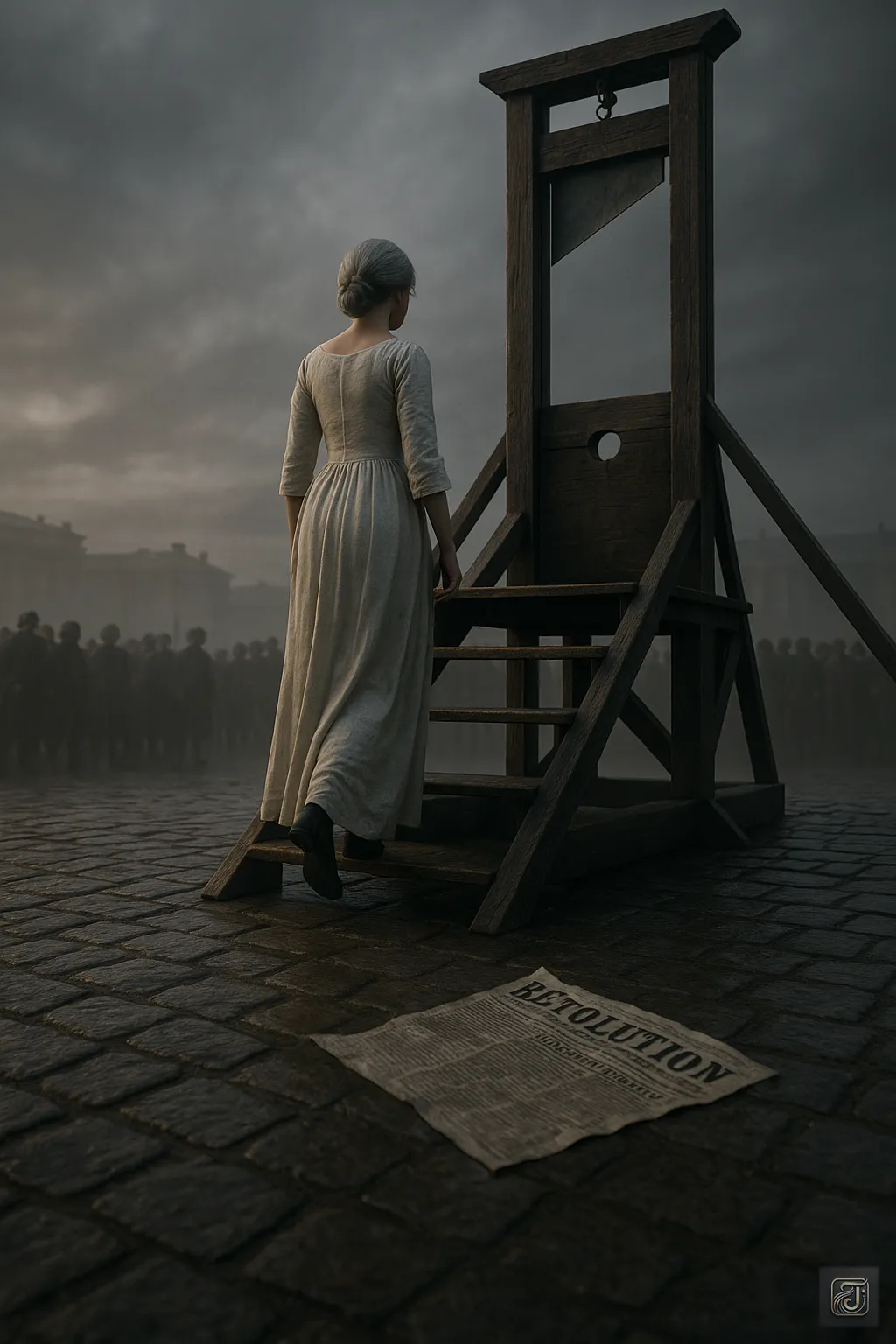
“Was she the greedy queen who drove France into starvation,
or the tragic monarch denied love since the age of fourteen—?”
The answer lies quietly,
buried somewhere in the folds of history.
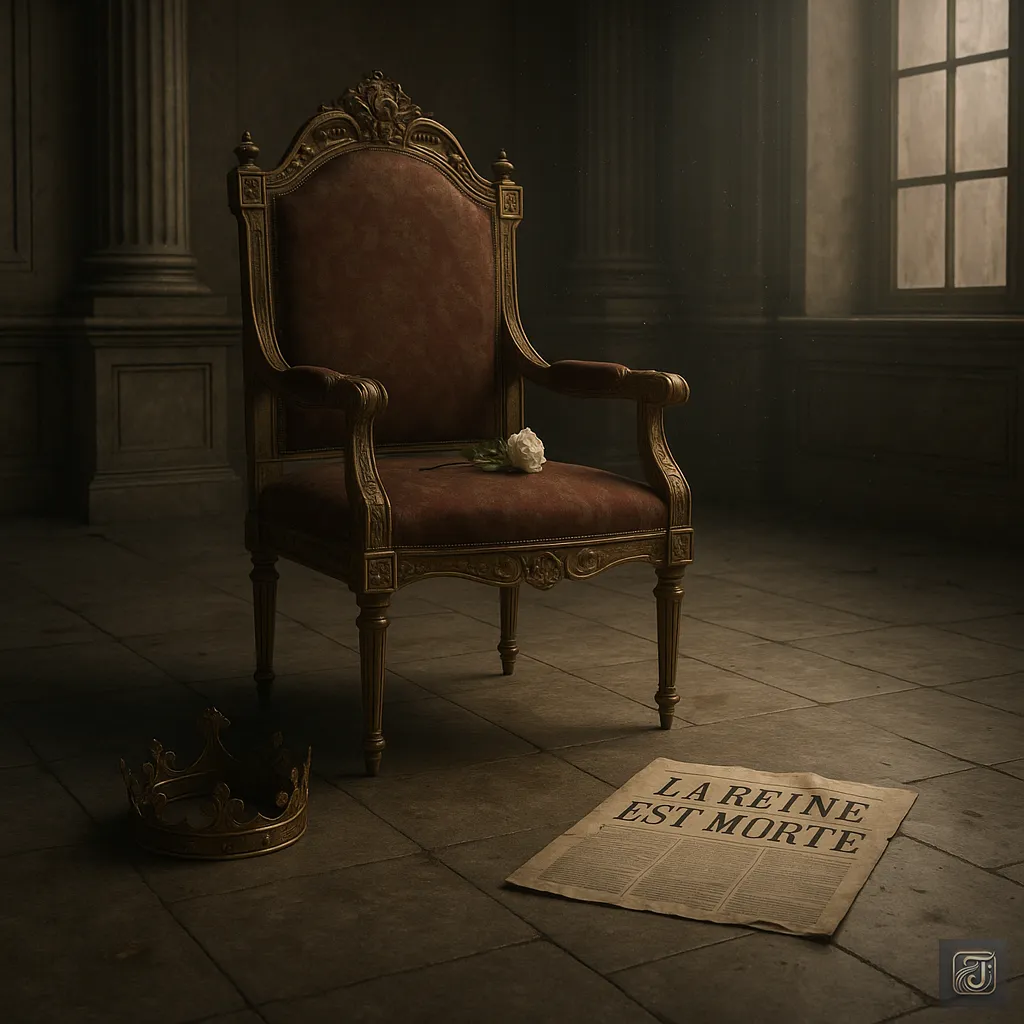
――Marie Antoinette.
Once called “The Greedy Queen”,
what was her true self?
Thus, the curtain falls on her story.
Afterword from the Author

The story of Queen Marie Antoinette—
As I wrote this, there is one thing I felt very strongly.
At only 14 years old, she lost her freedom and the right to love, all in the name of “diplomacy.”
She tried to fill the emptiness in her heart
with enormous wealth and a life of luxury.
Without considering the starving people—
But as a result,
she distanced herself from the hearts of the people,
and in the end, she was destroyed by those very people.
I believe this is a story that resonates even today.
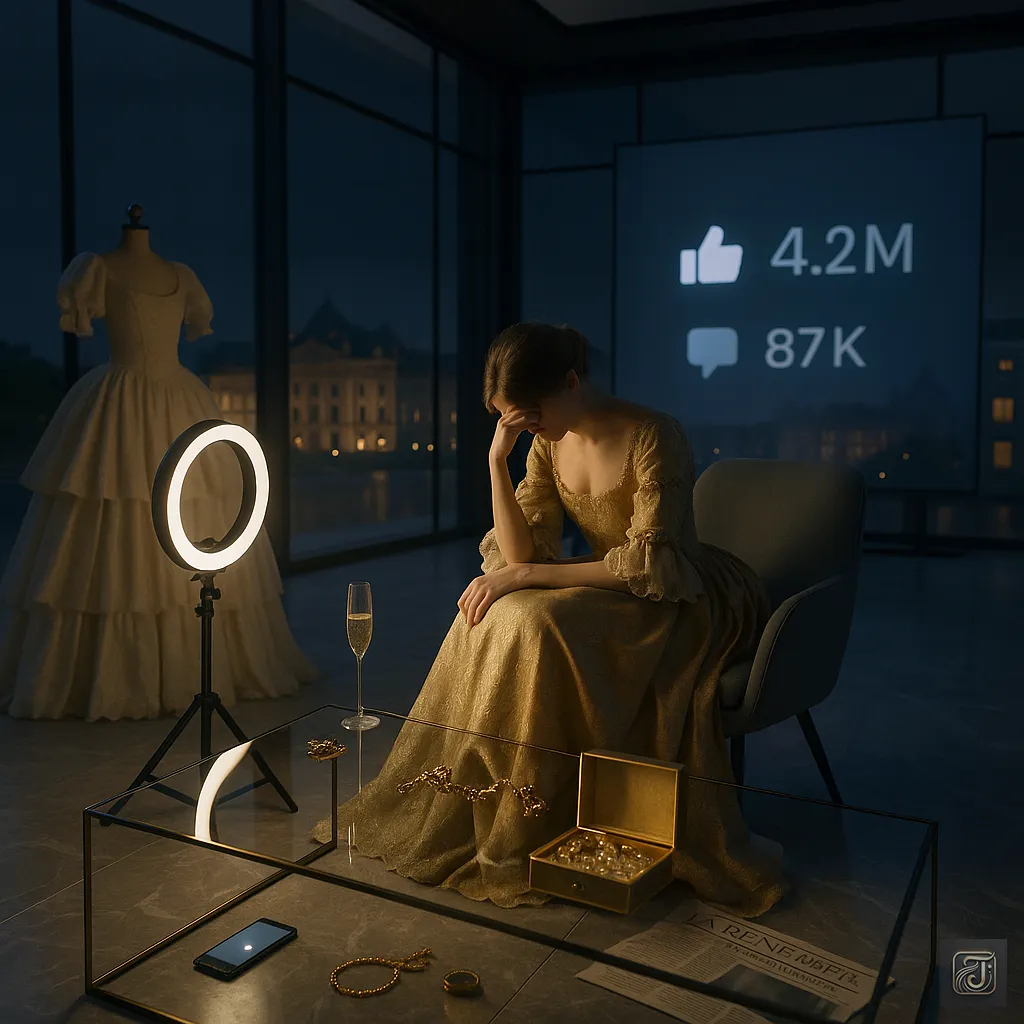
For example, those who succeed in business and build enormous wealth.
For example, those who win big in the lottery.
For example, influencers who flaunt their luxurious lifestyles on social media.
For some reason, many of these people eventually end up alone—
And it’s not uncommon for them to even go bankrupt.
Why is that?

Because they had no one they could truly trust.
When someone gains success by neglecting something important—
Sooner or later, they will be made to pay for what they ignored.
You can’t buy a genuine heart with money.
All you can buy is a heart that’s after your wealth.
And such a heart—once the money is gone—
will disappear just like the money itself.

“Success gained by neglecting something important will eventually be erased by what was neglected.”
Through the story of Marie Antoinette, I deeply felt this very lesson.
And I believe it’s something essential we must learn from history.
—That is exactly why I rewrote this story and wanted to share it with all of you.
If you were able to feel even a little something from the life of this tragic queen—
Then I would be truly grateful.
If you found this article helpful or enjoyable, please consider supporting me with a cup of coffee! 👈Click☕🙏
I’m a passionate blogger who loves diving deep into human history and sharing captivating stories about remarkable figures and events from the past.
My blog combines engaging storytelling with beautiful illustrations, making history accessible and enjoyable for everyone.
Currently, I write my blog while managing a full-time job.
Balancing both limits the time I can dedicate to research, writing, and illustrations.
With your support on Ko-fi, I can reduce the time spent on my main job and focus more on blogging, allowing me to increase the frequency of updates and bring you even more captivating stories.
Whether it’s a one-time coffee or a regular contribution, every bit goes directly into making history engaging and fun for my readers.
Thank you for joining me on this journey through time.
Let’s uncover the past together!
If you found this article insightful, please consider supporting me with a cup of coffee! 👈Click☕🙏

Author: Fuji
Human history is truly complex, isn’t it?
There are countless websites introducing historical figures and events,
but many of them are just plain explanations—not exactly exciting to read.
On the other hand, reading books takes a lot of time and effort.
That’s where I come in.
Through “stories that are more engaging than explanations and shorter than books,”
I aim to bring the world’s history and humanity’s records to you in a more accessible and interesting way.
If my stories inspire you to love history a little more, I’d be absolutely thrilled!



Comment